War in Afghanistan (2001–present)
The War in Afghanistan (or the U.S. War in Afghanistan; code named Operation Enduring Freedom – Afghanistan (2001–2014) and Operation Freedom's Sentinel (2015–present))[50][51] followed the United States invasion of Afghanistan[52] of 7 October 2001. The U.S. was supported initially by the United Kingdom and Canada[53] and later by a coalition of over 40 countries, including all NATO members. The war's public aims were to dismantle al-Qaeda and to deny it a safe base of operations in Afghanistan by removing the Taliban from power.[54] The War in Afghanistan is the second longest war in United States history, behind the Vietnam War.[55][56][57][58]
Following the September 11 attacks in 2001 on the U.S., which President George W. Bush blamed on Osama bin Laden who was living or hiding in Afghanistan, President Bush demanded that the Taliban hand over Osama bin Laden and expel al-Qaeda; bin Laden had already been wanted by the U.S. since 1998.[59] The Taliban declined to extradite him unless they were provided evidence of his involvement in the September 11 attacks and also declined demands to extradite others on the same grounds. The U.S. dismissed the request for evidence as a delaying tactic,[60] and on 7 October 2001 launched Operation Enduring Freedom with the United Kingdom.[61] The two were later joined by other forces, including the Northern Alliance which had been fighting the Taliban in the ongoing civil war since 1996.[62][63] In December 2001, the United Nations Security Council established the International Security Assistance Force (ISAF), to assist the Afghan interim authorities with securing Kabul. At the Bonn Conference the same month, Hamid Karzai was selected to head the Afghan Interim Administration, which after a 2002 loya jirga (grand assembly) in Kabul became the Afghan Transitional Administration. In the popular elections of 2004, Karzai was elected president of the country, now named the Islamic Republic of Afghanistan.[64]
NATO became involved in ISAF in August 2003, and later that year assumed leadership of it. At this stage, ISAF included troops from 43 countries with NATO members providing the majority of the force.[65] One portion of U.S. forces in Afghanistan operated under NATO command; the rest remained under direct U.S. command.
Following defeat in the initial invasion, the Taliban was reorganized by its leader Mullah Omar, and launched an insurgency against the government and ISAF in 2003.[66][67] Though outgunned and outnumbered, insurgents from the Taliban, Haqqani Network, Hezb-e-Islami Gulbuddin and other groups have waged asymmetric warfare with guerrilla raids and ambushes in the countryside, suicide attacks against urban targets and turncoat killings against coalition forces. The Taliban exploited weaknesses in the Afghan government, which is among the most corrupt in the world, to reassert influence across rural areas of southern and eastern Afghanistan. In the initial years there was little fighting, but from 2006 the Taliban made significant gains and showed an increased willingness to commit atrocities against civilians. ISAF responded in 2006 by increasing troops for counterinsurgency operations to "clear and hold" villages and "nation building" projects to "win hearts and minds".[68][69] Violence sharply escalated from 2007 to 2009.[70] While ISAF continued to battle the Taliban insurgency, fighting crossed into neighboring North-West Pakistan.[71] Troop numbers began to surge in 2009 continued to increase through 2011 when roughly 140,000 foreign troops operated under ISAF and U.S. command in Afghanistan.[72] Of these 100,000 were from the U.S.[73][74] On 1 May 2011, United States Navy SEALs killed Osama bin Laden in Abbotabad, Pakistan.
In May 2012, NATO leaders endorsed an exit strategy for withdrawing their forces. UN-backed peace talks have since taken place between the Afghan government and the Taliban.[75] In May 2014, the United States announced that its major combat operations would end in December 2014, and that it would leave a residual force in the country.[76] In October 2014, British forces handed over the last bases in Helmand to the Afghan military, officially ending their combat operations in the war.[77] On 28 December 2014, NATO formally ended ISAF combat operations in Afghanistan and officially transferred full security responsibility to the Afghan government. The NATO-led Operation Resolute Support was formed the same day as a successor to ISAF.[78][79] As of May 2017, over 13,000 foreign troops remain in Afghanistan without any formal plans to withdraw,[80][81] and continue their fight against the Taliban, which remains by far the largest single group fighting against the Afghan government and foreign troops.[82]
Tens of thousands of people have been killed in the war. Over 4,000 ISAF soldiers and civilian contractors, over 15,000 Afghan national security forces were killed, as well as over 31,000 civilians.[83]
Before the start of war
Origins of Afghanistan's civil war
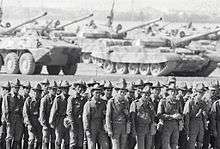
Afghanistan's political order began to break down with the overthrow of King Zahir Shah by his distant cousin Mohammed Daoud Khan in a bloodless 1973 Afghan coup d'état. Daoud Khan had served as prime minister since 1953 and promoted economic modernization, emancipation of women, and Pashtun nationalism. This was threatening to neighboring Pakistan, faced with its own restive Pashtun population. In the mid-1970s, Pakistani Prime Minister Zulfikar Ali Bhutto began to encourage Afghan Islamist leaders such as Burhanuddin Rabbani and Gulbuddin Hekmatyar, to fight against the regime. In 1978, Daoud Khan was killed in a coup by Afghan's Communist Party, his former partner in government, known as the People's Democratic Party of Afghanistan (PDPA). The PDPA pushed for a socialist transformation by abolishing arranged marriages, promoting mass literacy and reforming land ownership. This undermined the traditional tribal order and provoked opposition across rural areas. The PDPA's crackdown was met with open rebellion, including Ismail Khan's Herat Uprising. The PDPA was beset by internal leadership differences and was weakened by an internal coup on 11 September 1979 when Hafizullah Amin ousted Nur Muhammad Taraki. The Soviet Union, sensing PDPA weakness, intervened militarily three months later, to depose Amin and install another PDA faction led by Babrak Karmal.
The entry of Soviet forces in Afghanistan in December 1979 prompted its Cold War rivals, the United States, Pakistan, Saudi Arabia and China to support rebels fighting against the Soviet-backed Democratic Republic of Afghanistan. In contrast to the secular and socialist government, which controlled the cities, religiously motivated mujahideen held sway in much of the countryside. Beside Rabbani, Hekmatyar, and Khan, other mujahideen commanders included Jalaluddin Haqqani. The CIA worked closely with Pakistan's Inter-Service Intelligence to funnel foreign support for the mujahideen. The war also attracted Arab volunteers, known as "Afghan Arabs", including Osama bin Laden.
After the withdrawal of the Soviet military from Afghanistan in May 1989, the PDPA regime under Najibullah held on until 1992, when the collapse of the Soviet Union deprived the regime of aid, and the defection of Uzbek general Abdul Rashid Dostum cleared the approach to Kabul. With the political stage cleared of socialists, the warlords, some of them Islamist, vied for power. By then, Bin Laden had left the country and the United States' interest in Afghanistan also diminished.
Warlord rule (1992–1996)
In 1992, Rabbani officially became president of the Islamic State of Afghanistan, but had to battle other warlords for control of Kabul. In late 1994, Rabbani's defense minister, Ahmad Shah Massoud, defeated Hekmatyar in Kabul and ended ongoing bombardment of the capital.[84][85][86] Massoud tried to initiate a nationwide political process with the goal of national consolidation. Other warlords, including Ismail Khan in the west and Dostum in the north, maintained their fiefdoms.
In 1994, Mohammed Omar, a mujahideen member who taught at a Pakistani madrassa, returned to Kandahar and formed the Taliban movement. His followers were religious students, known as the Talib and they sought to end warlordism through strict adherence to Islamic law. By November 1994, the Taliban had captured all of Kandahar Province. They declined the government's offer to join in a coalition government and marched on Kabul in 1995.[87]
Taliban Emirate vs Northern Alliance
The Taliban's early victories in 1994 were followed by a series of costly defeats.[88] Pakistan provided strong support to the Taliban.[89][90] Analysts such as Amin Saikal described the group as developing into a proxy force for Pakistan's regional interests, which the Taliban denied.[89] The Taliban started shelling Kabul in early 1995, but were driven back by Massoud.[85][91]
On 27 September 1996, the Taliban, with military support by Pakistan and financial support from Saudi Arabia, seized Kabul and founded the Islamic Emirate of Afghanistan.[92] They imposed their fundamentalist interpretation of Islam in areas under their control, issuing edicts forbidding women to work outside the home, attend school, or to leave their homes unless accompanied by a male relative.[93] According to the Pakistani expert Ahmed Rashid, "between 1994 and 1999, an estimated 80,000 to 100,000 Pakistanis trained and fought in Afghanistan" on the side of the Taliban.[94][95]
Massoud and Dostum, former arch-enemies, created a United Front against the Taliban, commonly known as the Northern Alliance.[96] In addition to Massoud's Tajik force and Dostum's Uzbeks, the United Front included Hazara factions and Pashtun forces under the leadership of commanders such as Abdul Haq and Haji Abdul Qadir. Abdul Haq also gathered a limited number of defecting Pashtun Taliban.[97] Both agreed to work together with the exiled Afghan king Zahir Shah.[95] International officials who met with representatives of the new alliance, which the journalist Steve Coll referred to as the "grand Pashtun-Tajik alliance", said, "It's crazy that you have this today … Pashtuns, Tajiks, Uzbeks, Hazara … They were all ready to buy in to the process … to work under the king's banner for an ethnically balanced Afghanistan."[98][99] The Northern Alliance received varying degrees of support from Russia, Iran, Tajikistan and India. The Taliban captured Mazar-i-Sharif in 1998 and drove Dostum into exile.
The conflict was brutal. According to the United Nations (UN), the Taliban, while trying to consolidate control over northern and western Afghanistan, committed systematic massacres against civilians. UN officials stated that there had been "15 massacres" between 1996 and 2001. The Taliban especially targeted the Shia Hazaras.[100][101] In retaliation for the execution of 3,000 Taliban prisoners by Uzbek general Abdul Malik Pahlawan in 1997, the Taliban executed about 4,000 civilians after taking Mazar-i-Sharif in 1998.[102][103]
Bin Laden's 055 Brigade was responsible for mass killings of Afghan civilians.[104] The report by the United Nations quotes eyewitnesses in many villages describing "Arab fighters carrying long knives used for slitting throats and skinning people".[100][101]
By 2001, the Taliban controlled as much as 90% of Afghanistan, with the Northern Alliance confined to the country's northeast corner. Fighting alongside Taliban forces were some 28,000–30,000 Pakistanis (usually also Pashtun) and 2,000–3,000 Al-Qaeda militants.[87][104][105][106] Many of the Pakistanis were recruited from madrassas.[104] A 1998 document by the U.S. State Department confirmed that "20–40 percent of [regular] Taliban soldiers are Pakistani." The document said that many of the parents of those Pakistani nationals "know nothing regarding their child's military involvement with the Taliban until their bodies are brought back to Pakistan". According to the U.S. State Department report and reports by Human Rights Watch, other Pakistani nationals fighting in Afghanistan were regular soldiers, especially from the Frontier Corps, but also from the Pakistani Army providing direct combat support.[90][107]
Al-Qaeda
In August 1996, Bin Laden was forced to leave Sudan and arrived in Jalalabad, Afghanistan. He had founded Al-Qaeda in the late 1980s to support the Mujahideen's war against the Soviets, but became disillusioned by infighting among warlords. He grew close to Mullah Omar and moved Al-Qaeda's operations to eastern Afghanistan.
The 9/11 Commission in the U.S. found that under the Taliban, al-Qaeda was able to use Afghanistan as a place to train and indoctrinate fighters, import weapons, coordinate with other jihadists, and plot terrorist actions.[108] While al-Qaeda maintained its own camps in Afghanistan, it also supported training camps of other organizations. An estimated 10,000 to 20,000 men passed through these facilities before 9/11, most of whom were sent to fight for the Taliban against the United Front. A smaller number were inducted into al-Qaeda.[109]
After the August 1998 U.S. Embassy bombings were linked to bin Laden, President Bill Clinton ordered missile strikes on militant training camps in Afghanistan. U.S. officials pressed the Taliban to surrender bin Laden. In 1999, the international community imposed sanctions on the Taliban, calling for bin Laden to be surrendered. The Taliban repeatedly rebuffed these demands.
Central Intelligence Agency (CIA) Special Activities Division paramilitary teams were active in Afghanistan in the 1990s in clandestine operations to locate and kill or capture Osama bin Laden. These teams planned several operations, but did not receive the order to proceed from President Clinton. Their efforts built relationships with Afghan leaders that proved essential in the 2001 invasion.[110]
Change in U.S. policy toward Afghanistan
During the Clinton administration, the U.S. tended to favor Pakistan and until 1998–1999 had no clear policy toward Afghanistan. In 1997, for example, the U.S. State Department's Robin Raphel told Massoud to surrender to the Taliban. Massoud responded that, as long as he controlled an area the size of his hat, he would continue to defend it from the Taliban.[87] Around the same time, top foreign policy officials in the Clinton administration flew to northern Afghanistan to try to persuade the United Front not to take advantage of a chance to make crucial gains against the Taliban. They insisted it was the time for a cease-fire and an arms embargo. At the time, Pakistan began a "Berlin-like airlift to resupply and re-equip the Taliban", financed with Saudi money.[111]
U.S. policy toward Afghanistan changed after the 1998 U.S. embassy bombings. Subsequently, Osama bin Laden was indicted for his involvement in the embassy bombings. In 1999 both the U.S. and the United Nations enacted sanctions against the Taliban via United Nations Security Council Resolution 1267, which demanded the Taliban surrender Osama bin Laden for trial in the U.S. and close all terrorist bases in Afghanistan.[112] The only collaboration between Massoud and the U.S. at the time was an effort with the CIA to trace bin Laden following the 1998 bombings.[113] The U.S. and the European Union provided no support to Massoud for the fight against the Taliban.
By 2001 the change of policy sought by CIA officers who knew Massoud was underway.[114] CIA lawyers, working with officers in the Near East Division and Counter-terrorist Center, began to draft a formal finding for President George W. Bush's signature, authorizing a covert action program in Afghanistan. It would be the first in a decade to seek to influence the course of the Afghan war in favor of Massoud.[92] Richard A. Clarke, chair of the Counter-Terrorism Security Group under the Clinton administration, and later an official in the Bush administration, allegedly presented a plan to incoming Bush National Security Adviser Condoleezza Rice in January 2001.
A change in U.S. policy was effected in August 2001.[92] The Bush administration agreed on a plan to start supporting Massoud. A meeting of top national security officials agreed that the Taliban would be presented with an ultimatum to hand over bin Laden and other al-Qaeda operatives. If the Taliban refused, the U.S. would provide covert military aid to anti-Taliban groups. If both those options failed, "the deputies agreed that the United States would seek to overthrow the Taliban regime through more direct action."[115]
Northern Alliance on the eve of 9/11
Ahmad Shah Massoud was the only leader of the United Front in Afghanistan. In the areas under his control, Massoud set up democratic institutions and signed the Women's Rights Declaration.[116] As a consequence, many civilians had fled to areas under his control.[117][118] In total, estimates range up to one million people fleeing the Taliban.[119]
In late 2000, Ahmad Shah Massoud, a Tajik nationalist and leader of the Northern Alliance, invited several other prominent Afghan tribal leaders to a jirga in northern Afghanistan "to settle political turmoil in Afghanistan".[120] Among those in attendance were Pashtun nationalists, Abdul Haq and Hamid Karzai.[121][122]
In early 2001, Massoud and several other Afghan leaders addressed the European Parliament in Brussels, asking the international community to provide humanitarian help. The Afghan envoy asserted that the Taliban and al-Qaeda had introduced "a very wrong perception of Islam" and that without the support of Pakistan and Osama bin Laden, the Taliban would not be able to sustain their military campaign for another year. Massoud warned that his intelligence had gathered information about an imminent, large-scale attack on U.S. soil.[123]
On 9 September 2001, two French-speaking Algerians posing as journalists killed Massoud in a suicide attack in Takhar Province of Afghanistan. The two perpetrators were later alleged to be members of al-Qaeda. They were interviewing Massoud before detonating a bomb hidden in their video camera.[124][125] Both of the alleged al-Qaeda men were subsequently killed by Massoud's guards.
11 September attacks
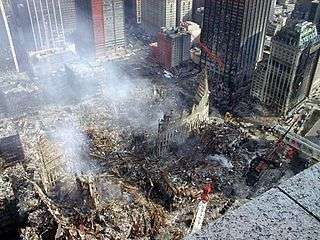
On the morning of 11 September 2001, a total of 19 Arab men carried out four coordinated attacks in the United States. Four commercial passenger jet airliners were hijacked.[126][127] The hijackers – members of al-Qaeda's Hamburg cell[128] – intentionally crashed two of the airliners into the Twin Towers of the World Trade Center in New York City, killing everyone on board and more than 2,000 people in the buildings. Both buildings collapsed within two hours from damage related to the crashes, destroying nearby buildings and damaging others. The hijackers crashed a third airliner into the Pentagon in Arlington, Virginia, just outside Washington, D.C. The fourth plane crashed into a field near Shanksville, in rural Pennsylvania, after some of its passengers and flight crew attempted to retake control of the plane, which the hijackers had redirected toward Washington, D.C., to target the White House, or the U.S. Capitol. No one aboard the flights survived. According to the New York State Health Department, the death toll among responders including firefighters and police was 836 as of June 2009.[129] Total deaths were 2,996, including the 19 hijackers.[129]
History
U.S. invasion of Afghanistan
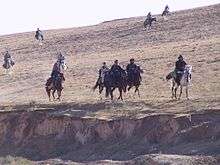
Immediately after the attacks, General Tommy Franks, then-commanding general of Central Command (CENTCOM), initially proposed to President George W. Bush and Secretary of Defense Donald Rumsfeld that the U.S. invade Afghanistan using a conventional force of 60,000 troops, preceded by six months of preparation. Rumsfield and Bush feared that a conventional invasion of Afghanistan could bog down as had happened to the Soviets and the British.[130] Rumsfield rejected Franks's plan, saying "I want men on the ground now!" Franks returned the next day with a plan utilizing U.S. Special Forces.[131] On 26 September 2001, fifteen days after the 9/11 attack, the U.S. covertly inserted members of the CIA's Special Activities Division led by Gary Schroen as part of team Jawbreaker into Afghanistan, forming the Northern Afghanistan Liaison Team.[132][133][134] They linked up with the Northern Alliance as part of Task Force Dagger.[135]
Two weeks later, Task Force Dagger; Operational Detachment Alpha (ODA) 555 and 595, both 12-man Green Beret teams from 5th Special Forces Group, plus Air Force combat controllers, were airlifted by helicopter from the Karshi-Khanabad Air Base in Uzbekistan[136] more than 300 kilometers (190 mi) across the 16,000 feet (4,900 m) Hindu Kush mountains in zero-visibility conditions by two SOAR MH-47E Chinook helicopters. The Chinooks were refueled in-flight three times during the 11-hour mission, establishing a new world record for combat rotorcraft missions at the time. They linked up with the CIA and Northern Alliance. Within a few weeks the Northern Alliance, with assistance from the U.S. ground and air forces, captured several key cities from the Taliban.[132][137]
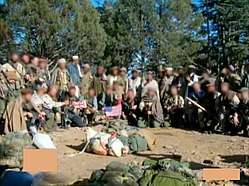
The U.S. officially launched Operation Enduring Freedom on 7 October 2001, with the assistance of the United Kingdom. The two were later joined by other countries.[62][63] The U.S. and its allies drove the Taliban from power and built military bases near major cities across the country. Most al-Qaeda and Taliban were not captured, escaping to neighboring Pakistan or retreating to rural or remote mountainous regions.[138]
On 20 December 2001, the United Nations authorized an International Security Assistance Force (ISAF), with a mandate to help the Afghans maintain security in Kabul and surrounding areas. It was initially established from the headquarters of the British 3rd Mechanised Division under Major General John McColl, and for its first years numbered no more than 5,000.[139] Its mandate did not extend beyond the Kabul area for the first few years.[140] Eighteen countries were contributing to the force in February 2002.
At the Bonn Conference in December 2001, Hamid Karzai was selected to head the Afghan Interim Administration, which after a 2002 loya jirga in Kabul became the Afghan Transitional Administration. In the popular elections of 2004, Karzai was elected president of the country, now named the Islamic Republic of Afghanistan.[64]
Post-Anaconda operations
Following the battle at Shahi-Kot, al-Qaeda fighters established sanctuaries on the Pakistani border, where they launched cross-border raids beginning in the summer of 2002. Guerrilla units, numbering between 5 and 25 men, regularly crossed the border to fire rockets at coalition bases, ambush convoys and patrols and assault non-governmental organizations. The area around the Shkin base in Paktika province saw some of the heaviest activity.
Taliban fighters remained in hiding in the rural regions of four southern provinces: Kandahar, Zabul, Helmand and Uruzgan. After Anaconda the Department of Defense requested British Royal Marines, highly trained in mountain warfare, to be deployed. In response, 45 Commando deployed under the operational codename Operation Jacana in April 2002. They conducted missions (including Operation Snipe, Operation Condor, and Operation Buzzard) over several weeks with varying results. The Taliban avoided combat.[141]
In May 2002 Combined Joint Task Force 180 became the senior U.S. military headquarters in the country, under Lieutenant General Dan K. McNeill.
Later in 2002, CJSOFT became a single integrated command under the broader CJTF-180 that commanded all US forces assigned to OEF-A, it was built around an Army Special Forces Group (often manned by National Guard units) and SEAL teams. A small JSOC element (formerly Task Force Sword/11) not under direct CTJF command - embedded within CJSOFT, it was manned by a joint SEAL and Ranger element that rotated command, it was not under direct ISAF command, although it operated in support of NATO operations.[142]
2003–2005 Taliban resurgence, war with Afghan forces
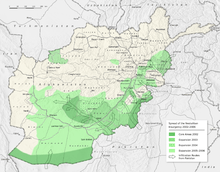
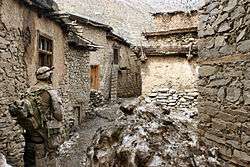
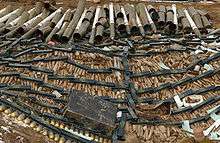
Pamphlets early 2003 turned up strewn in towns and countryside, by Taliban and other groups, urging Islamic faithful to rise up against US forces and other foreign soldiers in holy war.[143]
On 27 January 2003, during Operation Mongoose, a band of fighters were assaulted by U.S. forces at the Adi Ghar cave complex 25 km (15 mi) north of Spin Boldak.[144] 18 rebels were reported killed with no U.S. casualties. The site was suspected to be a base for supplies and fighters coming from Pakistan. The first isolated attacks by relatively large Taliban bands on Afghan targets also appeared around that time.
In May 2003, Taliban's Supreme Court's chief justice, Abdul Salam, proclaimed that the Taliban were back, regrouped, rearmed, ready for guerrilla war to expel US forces from Afghanistan. Omar assigned five operational zones to Taliban commanders such as Dadullah, who took charge in Zabul province.[145]
Small mobile training camps were established along the border to train recruits in guerrilla warfare, said senior Taliban warrior Mullah Malang in June 2003.[146] Most were drawn from tribal area madrassas in Pakistan. Bases, a few with as many as 200 fighters, emerged in the tribal areas by the summer of 2003. Pakistani will to prevent infiltration was uncertain, while Pakistani military operations proved of little use.[145]

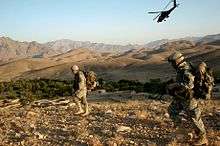
As the summer of 2003 continued, Taliban attacks gradually increased in frequency. Dozens of Afghan government soldiers, NGO humanitarian workers, and several U.S. soldiers died in the raids, ambushes and rocket attacks. Besides guerrilla attacks, Taliban fighters began building up forces in the district of Dai Chopan in Zabul Province. The Taliban decided to make a stand there. Over the course of the summer, up to 1,000 guerrillas moved there. Over 220 people, including several dozen Afghan police, were killed in August 2003.
On 11 August 2003, NATO assumed control of ISAF.[140] following NATO, taking the helm at ISAF.[65] Some U.S. forces in Afghanistan operated under NATO command; the rest remained under direct U.S. command. Taliban leader Mullah Omar reorganized the movement, and in 2003, launched an insurgency against the government and ISAF.[66][67]
In late 2004, the then hidden Taliban leader Mohammed Omar announced an insurgency against "America and its puppets" (referring to transitional Afghan government forces) to "regain the sovereignty of our country".[147]
In late August 2005, Afghan government forces attacked, backed by U.S. troops with air support. After a one-week battle, Taliban forces were routed with up to 124 fighters killed.
On 31 July 2006, ISAF assumed command of the south of the country, and by 5 October 2006, of the east.[148] Once this transition had taken place, ISAF grew to a large coalition involving up to 46 countries, under a U.S. commander.
2006: War between NATO forces and Taliban

From January 2006, a multinational ISAF contingent started to replace U.S. troops in southern Afghanistan. The British 16 Air Assault Brigade (later reinforced by Royal Marines) formed the core of the force, along with troops and helicopters from Australia, Canada and the Netherlands. The initial force consisted of roughly 3,300 British,[149] 2,300 Canadian,[150] 1,963 Dutch, 300 Australian,[151] 290 Danish[152] and 150 Estonian troops.[153] Air support was provided by U.S., British, Dutch, Norwegian and French combat aircraft and helicopters.
In January 2006, NATO's focus in southern Afghanistan was to form Provincial Reconstruction Teams with the British leading in Helmand while the Netherlands and Canada would lead similar deployments in Orūzgān and Kandahar, respectively. Local Taliban figures pledged to resist.[154]
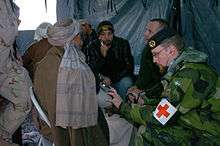
NATO operations in Southern Afghanistan in 2006 were led by British, Canadian and Dutch commanders. Operation Mountain Thrust was launched on 17 May 2006.
On 29 May 2006, while according to American website The Spokesman-Review Afghanistan faced "a mounting threat from armed Taliban fighters in the countryside", a US military truck that was part of a convoy in Kabul lost control and plowed into twelve civilian vehicles, killing one and injuring six people. The surrounding crowd got angry and a riot arose, lasting all day ending with 20 dead and 160 injured. When stone-throwing and gunfire had come from a crowd of some 400 men, the US troops had used their weapons "to defend themselves" while leaving the scene, a US military spokesman said. A correspondent for the Financial Times in Kabul suggested that this was the outbreak of "a ground swell of resentment" and "growing hostility to foreigners" that had been growing and building since 2004, and may also have been triggered by a US air strike a week earlier in southern Afghanistan killing 30 civilians, where she assumed that "the Taliban had been sheltering in civilian houses".[155][156]
In July, Canadian Forces, supported by U.S., British, Dutch and Danish forces, launched Operation Medusa.
A combined force of Dutch and Australians launched a successful offensive between late April to mid July 2006 to push the Taliban out of the Chora and Baluchi areas.
On 18 September 2006 Italian special forces of Task Force 45 and airborne troopers of the "Trieste" infantry regiment of the Rapid Reaction Corps composed of Italian and Spanish forces, took part in the Wyconda Pincer operation in the districts of Bala Buluk and Pusht-i-Rod, in Farah Province. Italian forces killed at least 70 Taliban. The situation in RC-W then deteriorated. Hotspots included Badghis in the far north and Farah in the southwest.
Further NATO operations included the Battle of Panjwaii, Operation Mountain Fury and Operation Falcon Summit. NATO achieved tactical victories and area denial, but the Taliban were not completely defeated. NATO operations continued into 2007.
2007: US build-up, ISAF war against Taliban
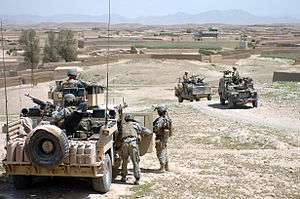
In January and February 2007, British Royal Marines mounted Operation Volcano to clear insurgents from firing-points in the village of Barikju, north of Kajaki.[157] Other major operations during this period included Operation Achilles (March–May) and Operation Lastay Kulang. The UK Ministry of Defence announced its intention to bring British troop levels in the country up to 7,700 (committed until 2009).[158] Further operations, such as Operation Silver and Operation Silicon, took place to keep up the pressure on the Taliban in the hope of blunting their expected spring offensive.[159][160]
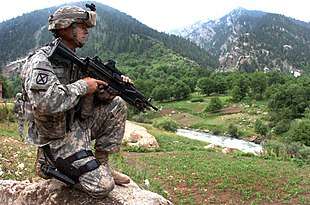
In February 2007, Combined Forces Command-Afghanistan inactivated. Combined Joint Task Force 76, a two-star U.S. command headquartered on Bagram Airfield, assumed responsibility as the National Command Element for U.S. forces in Afghanistan.[161] Combined Security Transition Command-Afghanistan, or CSTC-A, the other two-star U.S. command, was charged with training and mentoring the Afghan National Security Forces.
On 4 March 2007, U.S. Marines killed at least 12 civilians and injured 33 in Shinwar district, Nangrahar,[162] in a response to a bomb ambush. The event became known as the "Shinwar massacre".[163] The 120 member Marine unit responsible for the attack were ordered to leave the country by Army Major General Frank Kearney, because the incident damaged the unit's relations with the local Afghan population.[164]
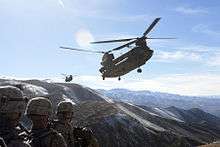
Later in March 2007, the U.S. during the Bush Administration deployed another more than 3,500 troops to Afghanistan to expand the fight against the Taliban.[165]
On 12 May 2007, ISAF forces killed Mullah Dadullah. Eleven other Taliban fighters died in the same firefight.
During the summer, NATO forces achieved tactical victories at the Battle of Chora in Orūzgān, where Dutch and Australian ISAF forces were deployed.
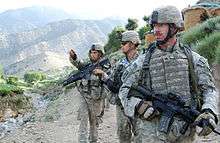
On 16 August, eight civilians including a pregnant woman and a baby died when, few hours after an insurgent IED ambush damaged a Polish wheeled armored vehicle, Polish soldiers shelled the village of Nangar Khel, Paktika Province. Seven soldiers were charged with war crimes, after locals stated the Polish unit fired mortar rounds and machine guns into a wedding celebration without provocation,[166] but they were cleared of all charges in 2011.[167]
On 28 October about 80 Taliban fighters were killed in a 24-hour battle in Helmand.[168]
Western officials and analysts estimated the strength of Taliban forces at about 10,000 fighters fielded at any given time. Of that number, only 2,000 to 3,000 were highly motivated, full-time insurgents. The rest were volunteer units, made up of young Afghans, angered by deaths of Afghan civilians in military airstrikes and American detention of Muslim prisoners who had been held for years without being charged.[169] In 2007, more foreign fighters came into Afghanistan than ever before, according to officials. Approximately 100 to 300 full-time combatants were foreigners, many from Pakistan, Uzbekistan, Chechnya, various Arab countries and perhaps even Turkey and western China. They were reportedly more violent, incontrollable and extreme, often bringing superior video-production or bombmaking expertise.[170]
On 2 November security forces killed a top-ranking militant, Mawlawi Abdul Manan, after he was caught crossing the border. The Taliban confirmed his death.[171] On 10 November the Taliban ambushed a patrol in eastern Afghanistan. This attack brought the U.S. death toll for 2007 to 100, making it the Americans' deadliest year in Afghanistan.[172]
The Battle of Musa Qala took place in December. Afghan units were the principal fighting force, supported by British forces.[173] Taliban forces were forced out of the town.
Reassessment and renewed commitment 2008
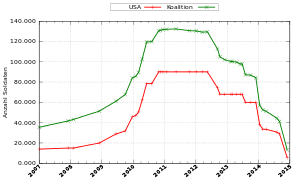
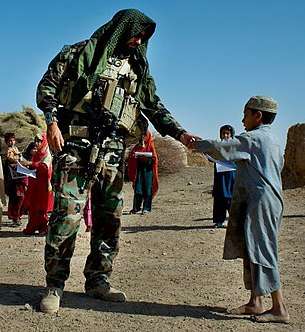
Admiral Mike Mullen, Chairman of the Joint Chiefs of Staff, said that while the situation in Afghanistan is "precarious and urgent", the 10,000 additional troops needed there would be unavailable "in any significant manner" unless withdrawals from Iraq are made. The priority was Iraq first, Afghanistan second.[174]
In the first five months of 2008, the number of U.S. troops in Afghanistan increased by over 80% with a surge of 21,643 more troops, bringing the total from 26,607 in January to 48,250 in June.[175] In September 2008, President Bush announced the withdrawal of over 8,000 from Iraq and a further increase of up to 4,500 in Afghanistan.[176]
In June 2008, British prime minister Gordon Brown announced the number of British troops serving in Afghanistan would increase to 8,030 – a rise of 230.[177] The same month, the UK lost its 100th serviceman.[178]
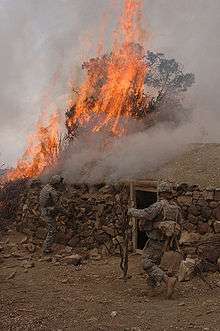
On 13 June, Taliban fighters demonstrated their ongoing strength, liberating all prisoners in Kandahar jail. The operation freed 1200 prisoners, 400 of whom were Taliban, causing a major embarrassment for NATO.[179]
On 13 July 2008, a coordinated Taliban attack was launched on a remote NATO base at Wanat in Kunar province. On 19 August, French troops suffered their worst losses in Afghanistan in an ambush with 10 soldiers killed in action and 21 injured.[180] Later in the month, an airstrike targeted a Taliban commander in Herat province and killed 90 civilians.
Late August saw one of NATO's largest operations in Helmand, Operation Eagle's Summit, aiming to bring electricity to the region.[181]
On 3 September, commandos, believed to be U.S. Army Special Forces, landed by helicopter and attacked three houses close to a known enemy stronghold in Pakistan. The attack killed between seven and twenty people. Local residents claimed that most of the dead were civilians. Pakistan condemned the attack, calling the incursion "a gross violation of Pakistan's territory".[182][183]
On 6 September, in an apparent reaction, Pakistan announced an indefinite disconnection of supply lines.[184]
On 11 September, militants killed two U.S. troops in the east. This brought the total number of U.S. losses to 113, more than in any prior year.[185] Several European countries set their own records, particularly the UK, who suffered 108 casualties.[186]
Taliban attacks on supply lines 2008
In November and December 2008, multiple incidents of major theft, robbery, and arson attacks afflicted NATO supply convoys in Pakistan.[187][188][189] Transport companies south of Kabul were extorted for money by the Taliban.[189][190] These incidents included the hijacking of a NATO convoy carrying supplies in Peshawar,[188] the torching of cargo trucks and Humvees east of the Khyber pass[191] and a half-dozen raids on NATO supply depots near Peshawar that destroyed 300 cargo trucks and Humvees in December 2008.[192]
US action into Pakistan 2008–2009

An unnamed senior Pentagon official told the BBC that at some point between 12 July – 12 September 2008, President Bush issued a classified order authorizing raids against militants in Pakistan. Pakistan said it would not allow foreign forces onto its territory and that it would vigorously protect its sovereignty.[193] In September, the Pakistan military stated that it had issued orders to "open fire" on U.S. soldiers who crossed the border in pursuit of militant forces.[194]
On 25 September 2008, Pakistani troops fired on ISAF helicopters. This caused confusion and anger in the Pentagon, which asked for a full explanation into the incident and denied that U.S. helicopters were in Pakistani airspace. Chief Pakistani military spokesman Major General Athar Abbas said that the helicopters had "crossed into our territory in Ghulam Khan area. They passed over our checkpost so our troops fired warning shots". A few days later a CIA drone crashed into Pakistan territory.[195]
A further split occurred when U.S. troops apparently landed on Pakistani soil to carry out an operation against militants in the Khyber Pakhtunkhwa Province. Pakistanis reacted angrily to the action, saying that 20 innocent villagers had been killed by U.S. troops.[196] However, despite tensions, the U.S. increased the use of remotely piloted drone aircraft in Pakistan's border regions, in particular the Federally Administered Tribal Areas (FATA) and Balochistan; as of early 2009, drone attacks were up 183% since 2006.[197]
By the end of 2008, the Taliban apparently had severed remaining ties with al-Qaeda.[198] According to senior U.S. military intelligence officials, perhaps fewer than 100 members of al-Qaeda remained in Afghanistan.[199]
In a meeting with General Stanley McChrystal, Pakistani military officials urged international forces to remain on the Afghan side of the border and prevent militants from fleeing into Pakistan. Pakistan noted that it had deployed 140,000 soldiers on its side of the border to address militant activities, while the coalition had only 100,000 soldiers to police the Afghanistan side.[200]
2009 US reinforcements, Taliban progress
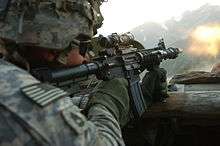
Northern Distribution Network
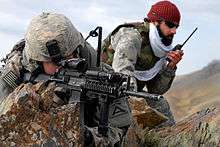
In response to the increased risk of sending supplies through Pakistan, work began on the establishment of a Northern Distribution Network (NDN) through Russia and Central Asian republics. Initial permission to move supplies through the region was given on January 20, 2009, after a visit to the region by General David Petraeus.[201] The first shipment along the NDN route left on 20 February from Riga, Latvia, then traveled 5,169 km (3,212 mi) to the Uzbek town of Termez on the Afghanistan border.[202] In addition to Riga, other European ports included Poti, Georgia and Vladivostok, Russia.[203] U.S. commanders hoped that 100 containers a day would be shipped along the NDN.[202] By comparison, 140 containers a day were typically shipped through the Khyber Pass.[204] By 2011, the NDN handled about 40% of Afghanistan-bound traffic, versus 30% through Pakistan.[203]
On 11 May 2009, Uzbekistan president Islam Karimov announced that the airport in Navoi (Uzbekistan) was being used to transport non-lethal cargo into Afghanistan. Due to the still unsettled relationship between Uzbekistan and the U.S. following the 2005 Andijon massacre and subsequent expulsion of U.S. forces from Karshi-Khanabad airbase, U.S. forces were not involved in the shipments. Instead, South Korea's Korean Air, which overhauled Navoi's airport, officially handled logistics.[205]
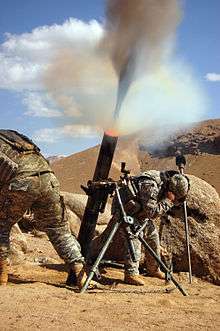
Originally only non-lethal resources were allowed on the NDN. In July 2009, however, shortly before a visit by new President Barack Obama to Moscow, Russian authorities announced that U.S. troops and weapons could use the country's airspace to reach Afghanistan.[206]
Human rights advocates were (as of 2009) concerned that the U.S. was again working with the government of Uzbekistan, which is often accused of violating human rights.[207] U.S. officials promised increased cooperation with Uzbekistan, including further assistance to turn Navoi into a regional distribution center for both military and civilian ventures.[208][209]
2009 Increase in U.S. troops
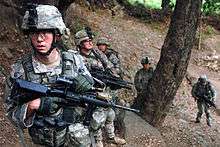
In January 2009, about 3,000 U.S. soldiers from the 3rd Brigade Combat Team of the 10th Mountain Division moved into the provinces of Logar, Wardak and Kunar. Afghan Federal Guards fought alongside them. The troops were the first wave of an expected surge of reinforcements originally ordered by President Bush and increased by President Obama.[210]
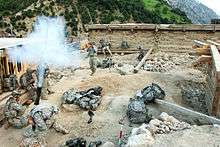
In mid-February 2009, it was announced that 17,000 additional troops would be deployed in two brigades and support troops; the 2nd Marine Expeditionary Brigade of about 3,500 and the 5th Brigade, 2nd Infantry Division, a Stryker Brigade with about 4,000.[211] ISAF commander General David McKiernan had called for as many as 30,000 additional troops, effectively doubling the number of troops.[212] On 23 September, a classified assessment by General McChrystal included his conclusion that a successful counterinsurgency strategy would require 500,000 troops and five years.[213]
In November 2009, Ambassador Karl W. Eikenberry sent two classified cables to Washington expressing concerns about sending more troops before the Afghan government demonstrates that it is willing to tackle the corruption and mismanagement that has fueled the Taliban's rise. Eikenberry, a retired three-star general who in 2006–2007 commanded U.S. troops in Afghanistan, also expressed frustration with the relative paucity of funds set aside for development and reconstruction.[214] In subsequent cables, Eikenberry repeatedly cautioned that deploying sizable American reinforcements would result in "astronomical costs" – tens of billions of dollars – and would only deepen the Afghan government's dependence on the United States.
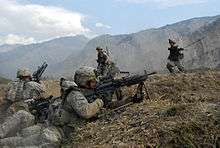
On 26 November 2009, Karzai made a public plea for direct negotiations with the Taliban leadership. Karzai said there is an "urgent need" for negotiations and made it clear that the Obama administration had opposed such talks. There was no formal U.S. response.[215][216]
On 1 December, Obama announced at the U.S. Military Academy in West Point that the U.S. would send 30,000 more troops.[217] Antiwar organizations in the U.S. responded quickly, and cities throughout the U.S. saw protests on 2 December.[218] Many protesters compared the decision to deploy more troops in Afghanistan to the expansion of the Vietnam War under the Johnson administration.[219]
Kunduz airstrike
On 4 September, during the Kunduz Province Campaign a devastating NATO air raid was conducted 7 kilometres southwest of Kunduz where Taliban fighters had hijacked civilian supply trucks, killing up to 179 people, including over 100 civilians.[220]
Operation Khanjar and Operation Panther's Claw
On 25 June U.S. officials announced the launch of Operation Khanjar ("strike of the sword").[221] About 4000 U.S. Marines from the 2nd Marine Expeditionary Brigade[222] and 650 Afghan soldiers[223] participated. Khanjar followed a British-led operation named Operation Panther's Claw in the same region.[224] Officials called it the Marines' largest operation since the 2004 invasion of Fallujah, Iraq.[222] Operation Panther's Claw was aimed to secure various canal and river crossings to establish a long-term ISAF presence.[225]
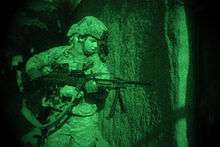
Initially, Afghan and American soldiers moved into towns and villages along the Helmand River[222] to protect the civilian population. The main objective was to push into insurgent strongholds along the river. A secondary aim was to bring security to the Helmand Valley in time for presidential elections, set to take place on 20 August.
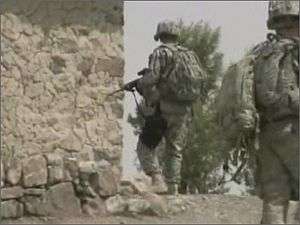
Taliban gains
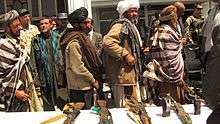
According to a 22 December briefing by Major General Michael T. Flynn, the top U.S. intelligence officer in Afghanistan, "The Taliban retains [the] required partnerships to sustain support, fuel legitimacy and bolster capacity."[226] The 23-page briefing states that "Security incidents [are] projected to be higher in 2010." Those incidents were already up by 300 percent since 2007 and by 60 percent since 2008, according to the briefing.[227] NATO intelligence at the time indicated that the Taliban had as many as 25,000 dedicated soldiers, almost as many as before 9/11 and more than in 2005.[228]
On 10 August McChrystal, newly appointed as U.S. commander in Afghanistan, said that the Taliban had gained the upper hand. In a continuation of the Taliban's usual strategy of summer offensives,[229] the militants aggressively spread their influence into north and west Afghanistan and stepped up their attack in an attempt to disrupt presidential polls.[230] Calling the Taliban a "very aggressive enemy", he added that the U.S. strategy was to stop their momentum and focus on protecting and safeguarding Afghan civilians, calling it "hard work".[231]
The Taliban's claim that the over 135 violent incidents disrupting elections was largely disputed. However, the media was asked to not report on any violent incidents.[232] Some estimates reported voter turn out as much less than the expected 70 percent. In southern Afghanistan where the Taliban held the most power, voter turnout was low and sporadic violence was directed at voters and security personnel. The chief observer of the European Union election mission, General Philippe Morillon, said the election was "generally fair" but "not free".[233]
Western election observers had difficulty accessing southern regions, where at least 9 Afghan civilians and 14 security forces were killed in attacks intended to intimidate voters. The Taliban released a video days after the elections, filming on the road between Kabul and Kandahar, stopping vehicles and asking to see their fingers. The video went showed ten men who had voted, listening to a Taliban militant. The Taliban pardoned the voters because of Ramadan.[234] The Taliban attacked towns with rockets and other indirect fire. Amid claims of widespread fraud, both top contenders, Hamid Karzai and Abdullah Abdullah, claimed victory. Reports suggested that turnout was lower than in the prior election.[235]
After Karzai's alleged win of 54 per cent, which would prevent a runoff, over 400,000 Karzai votes had to be disallowed after accusations of fraud. Some nations criticized the elections as "free but not fair".[236]
In December, an attack on Forward Operating Base Chapman, used by the CIA to gather information and to coordinate drone attacks against Taliban leaders, killed at least six CIA officers.
2010: American–British offensive and Afghan peace initiative
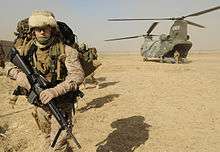
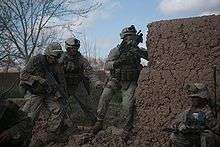
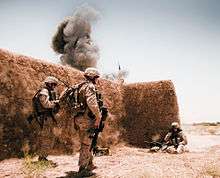
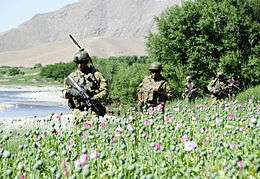
In public statements U.S. officials had previously praised Pakistan's military effort against militants during its offensive in South Waziristan in November 2009.[237] Karzai started peace talks with Haqqani network groups in March 2010,[238] and there were other peace initiatives including the Afghan Peace Jirga 2010. In July 2010, a U.S. Army report read: "It seems to always be this way when we go there [to meet civilians]. No one wants anything to do with us." A report on meeting up with school representatives mentioned students throwing rocks at soldiers and not welcoming their arrival, as had been reported on several occasions elsewhere.[239] President Zardari said that Pakistan had spent over 35 billion U.S. dollars during the previous eight years fighting against militancy.[240] According to the Afghan government, approximately 900 Taliban were killed in operations conducted during 2010.[241] Due to increased use of IEDs by insurgents the number of injured coalition soldiers, mainly Americans, significantly increased.[242] Beginning in May 2010 NATO special forces began to concentrate on operations to capture or kill specific Taliban leaders. As of March 2011, the U.S. military claimed that the effort had resulted in the capture or killing of more than 900 low- to mid-level Taliban commanders.[243][244] Overall, 2010 saw the most insurgent attacks of any year since the war began, peaking in September at more than 1,500. Insurgent operations increased "dramatically" in two-thirds of Afghan provinces.[245]
Troop surge
Deployment of additional U.S. troops continued in early 2010, with 9,000 of the planned 30,000 in place before the end of March and another 18,000 expected by June, with the 101st Airborne Division as the main source and a Marine Expeditionary Force in the Helmand Province. U.S. troops in Afghanistan outnumbered those in Iraq for the first time since 2003.[246]
The CIA, following a request by General McChrystal, planned to increase teams of operatives, including elite SAD officers, with U.S. military special operations forces. This combination worked well in Iraq and was largely credited with the success of that surge.[247] The CIA also increased its campaign using Hellfire missile strikes on Al-Qaeda in Pakistan. The number of strikes in 2010, 115, more than doubled the 50 drone attacks that occurred in 2009.[248]
The surge in troops supported a sixfold increase in Special Forces operations.[249] 700 airstrikes occurred in September 2010 alone versus 257 in all of 2009. From July 2010 to October 2010, 300 Taliban commanders and 800-foot-soldiers were killed.[250] Hundreds more insurgent leaders were killed or captured as 2010 ended.[249] Petraeus said, "We've got our teeth in the enemy's jugular now, and we're not going to let go."[251]
The CIA created Counter-terrorism Pursuit Teams (CTPT) staffed by Afghans at the war's beginning.[252][253] This force grew to over 3,000 by 2010 and was considered one of the "best Afghan fighting forces". Firebase Lilley was one of SAD's nerve centers.[253] These units were not only effective in operations against the Taliban and al-Qaeda forces in Afghanistan,[254] but have expanded their operations into Pakistan.[255] They were also important factors in both the "counterterrorism plus" and the full "counter-insurgency" options discussed by the Obama administration in the December 2010 review.[256]
Battle of Marjah
In early February, Coalition and Afghan forces began highly visible plans for an offensive, codenamed Operation Moshtarak, on the Taliban stronghold near the village of Marjah. It began on 13 February and, according to U.S. and Afghan officials, was the first operation where Afghan forces led the coalition. Led by the 2nd Marine Expeditionary Brigade (US), the offensive involved 15,000 US, British, Canadian, Estonian, Danish, French, and Afghan troops. It was the biggest joint operation since the 2001 invasion that ousted the Taliban.[257] The troops were fighting over an area of less than 100 square miles (260 km2), with a population of 80,000.
WikiLeaks disclosure
On 25 July 2010, the release of 91,731 classified documents from the WikiLeaks organization was made public. The documents cover U.S. military incident and intelligence reports from January 2004 to December 2009.[258] Some of these documents included sanitized, and "covered up", accounts of civilian casualties caused by Coalition Forces. The reports included many references to other incidents involving civilian casualties like the Kunduz airstrike and Nangar Khel incident.[259] The leaked documents also contain reports of Pakistan collusion with the Taliban. According to Der Spiegel, "the documents clearly show that the Pakistani intelligence agency Inter-Services Intelligence (usually known as the ISI) is the most important accomplice the Taliban has outside of Afghanistan."[260]
Pakistan and U.S. tensions
Tensions between Pakistan and the U.S. were heightened in late September after several Pakistan Frontier Corps soldiers were killed and wounded. The troops were attacked by a U.S. piloted aircraft that was pursuing Taliban forces near the Afghan-Pakistan border, but for unknown reasons opened fire on two Pakistan border posts. In retaliation for the strike, Pakistan closed the Torkham ground border crossing to NATO supply convoys for an unspecified period. This incident followed the release of a video allegedly showing uniformed Pakistan soldiers executing unarmed civilians.[261] After the Torkham border closing, Pakistani Taliban attacked NATO convoys, killing several drivers and destroying around 100 tankers.[262]
2011: U.S. and NATO drawdown
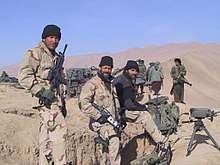
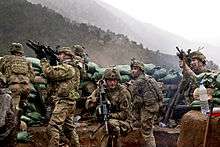

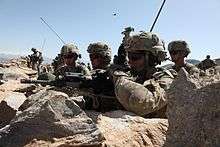

Battle of Kandahar
The Battle of Kandahar was part of an offensive named after the Battle of Bad'r that took place on 13 March 624, between Medina and Mecca. The Battle followed an 30 April announcement that the Taliban would launch their Spring offensive.[263]
On 7 May the Taliban launched a major offensive on government buildings in Kandahar. The Taliban said their goal was to take control of the city. At least eight locations were attacked: the governor's compound, the mayor's office, the NDS headquarters, three police stations and two high schools.[264] The battle continued onto a second day. The BBC's Bilal Sarwary called it "the worst attack in Kandahar province since the fall of the Taliban government in 2001, and a embarrassment for the Western-backed Afghan government."[265]
Death of Osama bin Laden
On 2 May U.S. officials announced that al-Qaeda leader Osama bin Laden had been killed in Operation Neptune Spear, conducted by the U.S. Navy SEALs, in Pakistan.[266]
Withdrawal
On 22 June President Obama announced that 10,000 troops would be withdrawn by the end of 2011 and an additional 23,000 troops would return by the summer of 2012. After the withdrawal of 10,000 U.S. troops, only 80,000 remained.[267] In July 2011 Canada withdrew its combat troops, transitioning to a training role.
Following suit, other NATO countries announced troop reductions. The United Kingdom stated that it would gradually withdraw its troops, however it did not specify numbers or dates.[268] France announced that it would withdraw roughly 1,000 soldiers by the end of 2012, with 3,000 soldiers remaining. Hundreds would come back at the end of 2011 and in the beginning of 2012, when the Afghan National Army took control of Surobi district. The remaining troops would continue to operate in Kapisa. Their complete withdrawal was expected by the end of 2014 or earlier given adequate security.[269]
Belgium announced that half of their force would withdraw starting in January 2012.[270] Norway announced it had started a withdrawal of its near 500 troops and would be completely out by 2014.[271] Equally, the Spanish Prime Minister announced the withdrawal of troops beginning in 2012, including up to 40 percent by the end of the first half of 2013, and complete withdrawal by 2014.[272]
2011 U.S.–NATO attack in Pakistan
After Neptune Spear, ISAF forces accidentally attacked Pakistan's armed forces on 26 November, killing 24 Pakistani soldiers. Pakistan blocked NATO supply lines and ordered Americans to leave Shamsi Airfield. NATO Secretary General Anders Fogh Rasmussen said the attack was 'tragic' and 'unintended'. "This (regret) is not good enough. We strongly condemn the attacks and reserve the right to take action," said DG ISPR Major General Athar Abbas. "This could have serious consequences in the level and extent of our cooperation."[273]
2012: Strategic agreement
Taliban attacks continued at the same rate as they did in 2011, around 28,000 attacks.[274] In September 2012, the surge of American personnel that began in late 2009 ended.[275]
Reformation of the United Front (Northern Alliance)
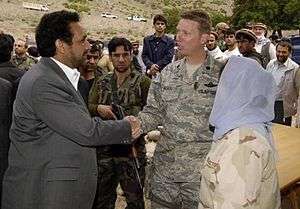
In late 2011 the National Front of Afghanistan (NFA) was created by Ahmad Zia Massoud, Abdul Rashid Dostum and Haji Mohammad Mohaqiq in what many analysts have described as a reformation of the military wing of the United Front (Northern Alliance) to oppose a return of the Taliban to power.[276] Meanwhile, much of the political wing reunited under the National Coalition of Afghanistan led by Abdullah Abdullah becoming the main democratic opposition movement in the Afghan parliament.[277][278] Former head of intelligence Amrullah Saleh has created a new movement, Basej-i Milli (Afghanistan Green Trend), with support among the youth mobilizing about 10,000 people in an anti-Taliban demonstration in Kabul in May 2011.[279][280][281]
In January 2012, the National Front of Afghanistan raised concerns about the possibility of a secret deal between the U.S., Pakistan and the Taliban during a widely publicized meeting in Berlin. U.S. Congressman Louie Gohmert wrote, "These leaders who fought with embedded Special Forces to initially defeat the Taliban represent over 60-percent of the Afghan people, yet are being entirely disregarded by the Obama and Karzai Administrations in negotiations."[282] After the meeting with U.S. congressmen in Berlin the National Front signed a joint declaration stating among other things:
We firmly believe that any negotiation with the Taliban can only be acceptable, and therefore effective, if all parties to the conflict are involved in the process. The present form of discussions with the Taliban is flawed, as it excludes anti-Taliban Afghans. It must be recalled that the Taliban extremists and their Al-Qaeda supporters were defeated by Afghans resisting extremism with minimal human embedded support from the United States and International community. The present negotiations with the Taliban fail to take into account the risks, sacrifices and legitimate interests of the Afghans who ended the brutal oppression of all Afghans.[283]
— National Front Berlin Statement, January 2012
High-profile U.S. military incidents
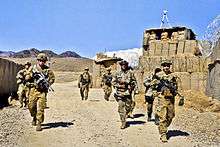
Beginning in January 2012, incidents involving U.S. troops[284][285][286][287][288][289] occurred which were described by The Sydney Morning Herald as "a series of damaging incidents and disclosures involving U.S. troops in Afghanistan […]".[284] These incidents created fractures in the partnership between Afghanistan and ISAF,[290] raised the question whether discipline within U.S. troops was breaking down,[291] undermined "the image of foreign forces in a country where there is already deep resentment owing to civilian deaths and a perception among many Afghans that U.S. troops lack respect for Afghan culture and people"[292] and strained the relations between Afghanistan and the United States.[285][286] Besides an incident involving U.S. troops who posed with body parts of dead insurgents and a video apparently showing a U.S. helicopter crew singing "Bye-bye Miss American Pie" before blasting a group of Afghan men with a Hellfire missile[292][293][294] these "high-profile U.S. military incidents in Afghanistan"[288] also included the 2012 Afghanistan Quran burning protests and the Panjwai shooting spree.
Enduring Strategic Partnership Agreement
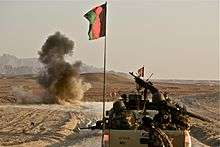
On 2 May 2012, Presidents Karzai and Obama signed a strategic partnership agreement between the two countries, after the U.S. president had arrived unannounced in Kabul on the first anniversary of Osama bin Laden's death.[295] The U.S.–Afghanistan Strategic Partnership Agreement, officially entitled the "Enduring Strategic Partnership Agreement between the Islamic Republic of Afghanistan and the United States of America",[296] provides the long-term framework for the two countries' relationship after the drawdown of U.S. forces.[297] The Strategic Partnership Agreement went into effect on 4 July 2012, according to Secretary of State Hillary Clinton on 8 July 2012 at the Tokyo Conference on Afghanistan.[298] On 7 July 2012, as part of the agreement, the U.S. designated Afghanistan a major non-NATO ally after Karzai and Clinton met in Kabul.[299] On 11 November 2012, as part of the agreement, the two countries launched negotiations for a bilateral security agreement.[300]
NATO Chicago Summit: Troops withdrawal and long-term presence
On 21 May 2012 the leaders of NATO-member countries endorsed an exit strategy during the NATO Summit.[64] ISAF Forces would transfer command of all combat missions to Afghan forces by the middle of 2013,[301] while shifting from combat to advising, training and assisting Afghan security forces.[302][303] Most of the 130,000 ISAF troops would depart by the end of December 2014.[301] A new NATO mission would then assume the support role.[302][304]
2013: Withdrawal
Karzai–Obama meeting
Karzai visited the U.S. in January 2012. At the time the U.S. Government stated its openness to withdrawing all of its troops by the end of 2014.[305] On 11 January 2012 Karzai and Obama agreed to transfer combat operations from NATO to Afghan forces by spring 2013 rather than summer 2013.[306][307] "What's going to happen this spring is that Afghans will be in the lead throughout the country", Obama said. "They [ISAF forces] will still be fighting alongside Afghan troops...We will be in a training, assisting, advising role." Obama added[307] He also stated the reason of the withdrawals that "We achieved our central goal, or have come very close...which is to de-capacitate al-Qaeda, to dismantle them, to make sure that they can't attack us again."[308]
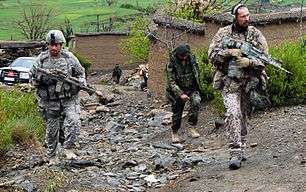
Obama also stated that he would determine the pace of troop withdrawal after consultations with commanders.[309] He added that any U.S. mission beyond 2014 would focus solely on counterterrorism operations and training.[308][309] Obama insisted that a continuing presence must include an immunity agreement in which U.S. troops are not subjected to Afghan law.[310] "I can go to the Afghan people and argue for immunity for U.S. troops in Afghanistan in a way that Afghan sovereignty will not be compromised, in a way that Afghan law will not be compromised," Karzai replied.[307]
Both leaders agreed that the United States would transfer Afghan prisoners and prisons to the Afghan government[307][311] and withdraw troops from Afghan villages in spring 2013.[311][312] "The international forces, the American forces, will be no longer present in the villages, that it will be the task of the Afghan forces to provide for the Afghan people in security and protection," the Afghan president said.[311]
Security transfer
On 18 June 2013 the transfer of security responsibilities was completed.[313][314][315][316] The last step was to transfer control of 95 remaining districts. Karzai said, "When people see security has been transferred to Afghans, they support the army and police more than before." NATO leader Rasmussen said that Afghan forces were completing a five-stage transition process that began in March 2011. "They are doing so with remarkable resolve," he said. "Ten years ago, there were no Afghan national security forces … now you have 350,000 Afghan troops and police."[313] ISAF remained slated to end its mission by the end of 2014.[316] Some 100,000 ISAF forces remained in the country.[314]
2014: Withdrawal continues and the insurgency increases
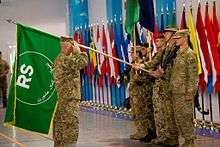
After 2013, the Taliban escalated suicide bombings. An example of this is a bombing of a Lebanese restaurant in the Wazir Akbar Khan area of Kabul on 18 February 2014. Among the dead in this attack were UN staff and the owner of a restaurant, who died protecting his business; 21 people altogether were killed. Meanwhile, the withdrawal continued, with 200 more U.S. troops going home. The UK halved their force and were slowing withdrawal with all but two bases being closed down. On 20 March 2014, more than 4 weeks after a bomb in a military bus by the Taliban rocked the city once again, a raid on the Serena Hotel's restaurant in Kabul by the Taliban resulted in the deaths of 9 people, including the 4 perpetrators. The attack came just 8 days after Swedish radio journalist Nils Horner was shot dead by the Taliban.
However, as the U.S. troops withdrew from Afghanistan, they were replaced by private security companies hired by the United States government and the United Nations. Many of these private security companies (also termed military contractors) consisted of ex U.S. Army, U.S. Marine, British, French and Italian defense personnel who had left the defense after a few years of active service. Their past relations with the defense helped establish their credentials, simultaneously allowing the U.S. and British to continue to be involved in ground actions without the requirement to station their own forces. This included companies such as the Ohio-based military contracting company, Mission Essential Personnel set up by Sunil Ramchand, a former White House staffer and U.S. Navy veteran.[317]
Despite the crisis in Crimea, by March 2014 Russia had not tried to exert pressure on the U.S. via the Northern Distribution Network supply line.[318] On 9 June 2014 a coalition air strike mistakenly killed five U.S. troops, an Afghan National Army member and an interpreter in Zabul Province.[319]
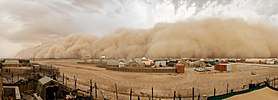
On 5 August 2014, a gunman in an Afghan military uniform opened fire on a number of U.S., foreign and Afghan soldiers, killing a U.S. general, Harold J. Greene[320] and wounding about 15 officers and soldiers including a German brigadier general and a large number of U.S. soldiers at Camp Qargha, a training base west of Kabul.[321]
Two longterm security pacts, the Bilaterial Security agreement between Afghanistan and the United States of America and the NATO Status of Forces Agreement between NATO and Afghanistan, were signed on 30 September 2014. Both pacts lay out the framework for the foreign troop involvement in Afghanistan after the year 2014.[322]
After 13 years Britain and the United States officially ended their combat operation in Afghanistan on 26 October 2014. On that day Britain handed over its last base in Afghanistan, Camp Bastion, while the United States handed over its last base, Camp Leatherneck, to Afghan forces.[323]
As early as November 2012, the U.S. and NATO were considering the precise configuration of their post-2014 presence in Afghanistan.[324][325] On 27 May 2014, President Barack Obama announced that U.S. combat operations in Afghanistan would end in December 2014 (see Withdrawal of U.S. troops from Afghanistan). 9,800 troops were to remain, training Afghan security forces and supporting counterterrorism operations against remnants of al-Qaeda. This force would be halved by the end of 2015, and consolidated at Bagram Air Base and in Kabul. All U.S. forces, with the exception of a "normal embassy presence," would be removed from Afghanistan by the end of 2016.[326] In 2014, 56 United States service members, and 101 contractors, died in Afghanistan.[327]
On 28 December 2014 NATO officially ended combat operations in a ceremony held in Kabul.[78] Continued operations by United States forces within Afghanistan will continue under the name Operation Freedom's Sentinel;[328] this was joined by a new NATO mission under the name of Operation Resolute Support.[329] Operation Resolute Support will involve 28 NATO nations, 14 partner nations, 11,000 American troops, and 850 German troops.[330] The Special Operations Joint Task Force – Afghanistan, the remnant U.S./NATO special forces organisation, includes a counter-terrorism task force. In the words of the U.S. Special Operations Command Factbook for 2015, this task force '[c]onducts offensive operations in Afghanistan to degrade the Taliban, al-Qaeda, and the Haqqani Networks in order to prevent them from establishing operationally significant safe havens which threaten the stability and sovereignty of Government of the Islamic Republic of Afghanistan and the United States.'[331] This task force is similar to previous forces such as Task Force 373.
The UK officially commemorated the end of its role in the Afghan war in a ceremony held in St Paul's cathedral on 13 March 2015.[332] Around 500 UK troops remain in "non-combat" roles.[333][334]
2015 Taliban resurgence
The Taliban began a resurgence due to several factors. At the end of 2014, the US and NATO combat mission ended and the withdrawal of most foreign forces from Afghanistan reduced the risk the Taliban faced of being bombed and raided. In June 2014, the Pakistani military's Operation Zarb-e-Azb, launched in the North Waziristan tribal area in June 2014, dislodged thousands of mainly Uzbek, Arab and Pakistani militants, who flooded into Afghanistan and swelled the Taliban's ranks. The group was further emboldened by the comparative lack of interest from the international community and the diversion of its attention to crisis in other parts of the world, such as Syria, Iraq, Yemen, and Ukraine. Afghan security forces also lack certain capabilities and equipment, especially air power and reconnaissance. The political infighting in the central government in Kabul and the apparent weakness in governance at different levels are also exploited by the Taliban.[335] In May 2015, Russia has closed a key military transport corridor which allowed NATO to deliver military supplies to Afghanistan through the Russian territory.[336]
On 5 January, a suicide car bomber attacked the HQ of EUPOL Afghanistan in Kabul, killing 1 person and injuring 5. The Taliban claimed responsibility.[337] On 15 January, Afghan security officials arrested five men in Kabul in relation to their suspected involvement in the 2014 Peshawar school massacre in Pakistan.[338] In mid-January 2015, the Islamic State of Iraq and the Levant established a branch in Afghanistan called Wilayah Khorasan and began recruiting fighters[339] and clashing with the Taliban.[340][341] However, an Afghan military officer stated that he believed the Afghan military could handle any threat that the group presented in the country.[339]
American forces have increased raids against "Islamist militants," moving beyond counter-terrorism missions. This is partially due to improved relations with the United States due to the Ghani presidency. Reasoning used for these raids include protecting American forces, which has been broadly interpreted.[342] One raid, a joint raid by American and Afghan forces arrested six Taliban connected to the 2014 Peshawar school massacre.[343] American Secretary of Defense Ash Carter traveled to Afghanistan in February 2015;[344] during a period when it was discussed that the U.S. would slow down its withdrawal from Afghanistan.[345]
In February 2015, the headquarters element of the U.S. 7th Infantry Division began to deploy to Afghanistan.[346] It will serve as the Resolute Support Mission's Train Advise Assist Command - South headquarters. It will be joined by 10th Mountain Division's 2nd Brigade Combat Team, and 101st Combat Aviation Brigade.[347]
On 18 March, Hafiz Wahidi, ISIL's replacement deputy Emir in Afghanistan, was killed by the Afghan Armed Forces, along with 9 other ISIL militants accompanying him.[348]
On 19 March, it was reported by Reuters that the U.S. military bases in Kandahar and Jalalabad were likely to remain open beyond the end of 2015, a senior U.S. official said, as the Federal Government of the United States considered slowing its military withdrawal to help the new government fight the Taliban. The anticipated policy reversal reflected U.S. support of Afghanistan's new and more cooperative president, Ashraf Ghani, and a desire to avoid the collapse of local security forces that occurred in Iraq after the U.S. withdrawal there.
On 25 March, the Afghan National Army killed twenty-nine insurgents and injured twenty-one others in a series of operations in the Daikundi, Ghazni, and Parwan provinces.[349] Eleven people, including one U.S. service member, died in a Taliban attack on Camp Integrity in Kabul in August.[350]
Suicide bombers attacked Hetal Hotel in May. Norwegian Marinejegerkommandoen special forces were central in saving 37 Australian hostages while maintaining direct contact with the Australian ambassador in Kabul.[351]
Throughout 2015, the US launched about one thousand bombs and missiles at targets in Afghanistan, according to the Council on Foreign Relations.[352]
Kabul Parliament attack
On 22 June 2015, the Taliban detonated a car bomb outside the National Assembly in Kabul, and Taliban fighters attacked the building with assault rifles and RPGs.[353][354] A Taliban fighter driving a car loaded with explosives managed to get through security checkpoints before detonating the vehicle outside the parliament's gates. Six Taliban insurgents with AK-47 rifles and RPGs took up positions in a construction site nearby.[355] Members of Parliament were evacuated to safety, while security forces engaged the insurgents in a two-hour gun battle. Afghan Interior Ministry spokesman Sediq Sediqqi said all seven attackers were killed by police and no MPs were wounded.[356] The UN mission in Afghanistan said a woman and a child were killed in the attack, and forty civilians were injured.[357]
Kunduz Offensive
Heavy fighting has occurred in the Kunduz province,[358][359] which was the site of clashes from 2009 onwards. In May, flights into the Northern city of Kunduz were suspended due to weeks of clashes between the Afghan security forces and the Taliban outside the city.[360] The intensifying conflict in the Northern Char Dara District within the Kunduz province led the Afghan government to enlist local militia fighters to bolster opposition to the Taliban insurgency.[361] In June, the Taliban intensified attacks around the Northern city of Kunduz as part of a major offensive in an attempt to capture the city.[362][363][364] Tens of thousands of inhabitants have been displaced internally in Afghanistan by the fighting. The government recaptured the Char Dara district after roughly a month of fighting.[365]
In late September, Taliban forces launched an attack on Kunduz, seizing several outlying villages and entering the city. The Taliban stormed the regional hospital and clashed with security forces at the nearby university. The fighting saw the Taliban attack from four different districts: Char Dara to the west, Aliabad to the south-west, Khanabad to the east and Imam Saheb to the north.[366][367] The Taliban took the Zakhel and Ali Khel villages on the highway leading south, which connects the city to Kabul and Mazar-e Sharif through Aliabad district, and reportedly made their largest gains in the south-west of Kunduz, where some local communities had picked up weapons and supported the Taliban.[366] Taliban fighters had allegedly blocked the route to the Airport to prevent civilians fleeing the city.[368] One witness reported that the headquarters of the National Directorate of Security was set on fire.[369] Kunduz was recaptured by Afghan and American forces on 14 October 2015.
Taliban negotiations, 2015–2016
Chinese officials have declared that Afghan stability affects separatist movements in the region, including in China's West[370] as well as the security of the China–Pakistan Economic Corridor.[371] China and Pakistan have been involved in negotiations between the Afghan government and the Taliban.[370][372] The Quadrilateral Coordination Group-consisting of Afghan, American, Chinese and Pakistani officials have been inviting the Taliban to discuss peace talks since January 2016, but currently they are presumably preoccupied with fighting each other and the government forces. A meeting between representatives of both sides were expected to take place in early March but the Taliban stated they would not participate.[373][374][375]
The bombing of the Kabul parliament has highlighted differences within the Taliban in their approach to peace talks.[376][377] In April 2016, President Ashraf Ghani "pulled the plug" on the Afghan governments failing effort to start peace talks with the Taliban.[378] And due to the Haqqani Networks integration into the Taliban leadership, it will now be harder for peace talks to take place.[379][380] Although leader of the Taliban, Haibatullah Akhundzada, said a peace agreement was possible if the government in Kabul renounced its foreign allies.[381]
Taliban infighting, 2015–2016
On 11 November 2015, it was reported that infighting had broken out between different Taliban factions in Zabul Province. Fighters loyal to the new Taliban leader Mullah Akhtar Mansoor fought a Pro-ISIL splinter faction led by Mullah Mansoor Dadullah. Even though Dadullah's faction enjoyed the support of foreign ISIL fighters, including Uzbeks and Chechens, it was reported that Mansoor's Taliban loyalists had the upper hand. According to Ghulam Jilani Farahi, provincial director of security in Zabul, more than 100 militants from both sides were killed since the fighting broke out.[382]
The infighting has continued into 2016; on 10 March 2016, officials said that the Taliban clashed with the Taliban splinter group (led by Muhammad Rasul) in the Shindand district of Herat with up to 100 militants killed; the infighting has also stifled peace talks.[373][383]
As a result of the infighting, which has resulted in Mansour being consumed with a campaign to quell dissent against his leadership; Sirajuddin Haqqani, chief of the Haqqani Network was selected to become the deputy leader of the Taliban in the summer of 2015, during a leadership struggle within the Taliban. Sirajuddin and other Haqqani leaders increasingly run the day-to-day military operations for the Taliban, in particular; refining urban terrorist attacks and cultivating a sophisticated international fund-raising network, they have also appointing Taliban governors and began uniting the Taliban. As a result, the Haqqani Network is now closely integrated with the Taliban at a leadership level, and is growing in influence within the insurgency, whereas the network was largely autonomous before, and there are concerns that the fighting is going to be deadlier. Tensions with the Pakistani military have also been raised because American and Afghan officials accuse them of sheltering the Haqqanis as a proxy group.[379][380]
Taliban offensive in Helmand Province, 2015–2018
In 2015 the Taliban began an offensive in Helmand Province, taking over parts of the Province. By June 2015, they had seized control of Dishu and Baghran killing 5,588 Afghan government security forces (3,720 of them were police officers).[384] By the end of July, the Taliban had overrun Nawzad District[385] and on 26 August, the Taliban took control of Musa Qala.[386] the status of the remaining districts, by 18 December 2015, is that Taliban and Afghan security forces are contesting Nahr-i-Sarraj, Sangin, Kajaki, Nad Ali and Khanashin (Afghan security forces claim to have previously "ejected" the Taliban from the Khanashin district center, with 42 Taliban fighters killed) whilst Garmsir, Washir, and Nawa-i-Barak are believed to be contested.[387]
In October 2015, Taliban forces had attempted to take Lashkar Gah; the capital of Helmand province, the Afghan's 215th Corps and special operations forces launched a counteroffensive against the Taliban in November,[388] Whilst the assault was repelled, Taliban forces remained dug into the city's suburbs as of December 2015.[389] December 2015 saw a renewed Taliban offensive in Helmand focused on the town of Sangin, Sangin district fell to the Taliban on 21 December, after fierce clashes that killed more than 90 soldiers in two days.[390] It was reported that 30 members of the SAS alongside 60 US special forces operators joined the Afghan Army in the Battle to retake parts of Sangin from Taliban insurgents,[391] in addition, about 300 U.S. troops and a small number of British troops are in Helmand and are advising Afghan commanders at the Corps level.[392][393]
On or around 23 December, approximately 200 Afghan Police and Army forces were besieged inside the town's police headquarters, with ammunition, military equipment and food having to be airdropped to their positions, with the rest of Sangin being under Taliban control, and an attempted relief mission failing.[389][394][395][396][397] As of 27 December 2015, the Taliban control the districts of Musa Qala, Nawzad, Baghran, and Disho and districts of Sangin, Marja, Khanishin, Nad Ali, and Kajaki have also experienced sustained fighting according to Mohammad Karim Attal, the chief of the Helmand Provincial council.[398]
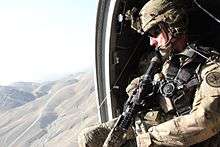
Senior American commanders said that the Afghan troops in the province have lacked effective leaders as well as the necessary weapons and ammunition to hold off persistent Taliban attacks. Some Afghan soldiers in Helmand have been fighting in tough conditions for years without a break to see their family, leading to poor morale and high desertion rates.[392] In early February 2016, Taliban insurgents renewed their assault on Sangin, after previously being repulsed in December 2015, launching a string of ferocious attacks on Afghan government forces earlier in the month. As a result, the United States decided to send troops from the 2nd Battalion, 87th Infantry Regiment, 10th Mountain Division, in order to prop up the Afghan 215th Corps in Helmand province, particularly around Sangin, joining US special operations forces already in the area.[399][400][401][402][403]
On 23 February 2016, CNN announced that Afghan troops pulled out of Nawzad and Musa Qala districts in Helmand Province on 20 and 21 February in what a senior military official said was a "tactical" move. Head of the local provincial council Mohammad Karim Atal told CNN, "Afghan soldiers had paid a heavy price and had recaptured some of the areas in those districts by shedding their blood only few months back, but now because of mismanagement, lack of coordination and weak leadership they left them in the hands of enemies."[404]
On 14 March 2016, Khanneshin District in Helmand Province fell to the Taliban; and district by district, Afghan troops are retreating back to urban centers in Helmand.[375][403] In early April 2016, 600 Afghan troops launched a major offensive to retake Taliban-occupied areas of Sangin and the area around it,[405] an Afghan army offensive to retake the town of Khanisheen was repelled by the Taliban, desertions from the army in the area are rife.[406] By 28 July 2016, the outlook on the situation in Helmand province was good, U.S. military officials are now expecting a major Taliban offensive. General Nicholson said, "Now, fighting season's not over. We anticipate we'll see other enemy attempts to regain territory in Helmand. But thus far, things are on a real positive trajectory."[407]
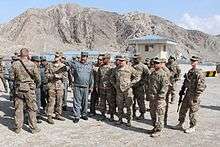
Despite US airstrikes, militants besieged Lashkar Gah, reportedly controlling all roads leading to the city and areas a few miles away. The US stepped up airstrikes in support of Afghan ground forces. Afghan forces in Lashkar Gah were reported as "exhausted" whilst police checkpoints around the capital were falling one by one; whilst the Taliban sent a new elite commando force into Helmand called "Sara Khitta" in Pashto.[408][409][410] Afghan security forces beat back attacks by Taliban fighters encroaching on Chah-e-Anjir, just 10 km from Lashkar Gah; Afghan special forces backed by U.S. airstrikes battled increasingly well-armed and disciplined Taliban militants. An Afghan special forces commander said "The Taliban have heavily armed, uniformed units that are equipped with night vision and modern weapons."[411] On 22 August 2016, the US announced that 100 U.S. troops were sent to Lashkar Gah to help prevent the Taliban from overrunning it, in what Brigadier General Charles Cleveland called a "temporary effort" to advise the Afghan police.[412] The deployment brought the number of US troops deployed in and around Lashkar Gah to about 700; according to a spokesman for the provincial governor of Helmand, U.S. forces have been carrying out operations with Afghan forces in the Chah Anjir area of Nad-e-Ali district and around the Babaji area.[413]
On 1 October 2016, it was reported that Taliban fighters advanced closer to Lashkar Gah by pushing into a farming district on the other side of the river from the town. Despite pushing back the Taliban with the support of US airstrikes in August, the Afghan government is struggling to reverse the tide of fighting. Local officials said that security forces were engaging insurgents and were expected to begin offensive operations soon.[414] On 10 October, it was reported that the Taliban launched a large-scale attack on Lashkar Gah, pushing into the town, and were said to have taken Bolan and Nawa.[415][416]
On 31 December 2016, the Taliban continued their assault on the province with attacks on Sangin and Marjah districts.[417] In January 2017, the Marine Corps Times reported that in spring 2017, the U.S. Marine Corps will deploy a task force of 300 personnel (known as Task Force Southwest) for nine months to southwestern Afghanistan to advise-and-assist local security forces in countering Taliban gains in the Helmand province. Officials said the Marines will work alongside "key leaders" from the Afghan National Army's 215th Corps and the 505th Zone National Police "to further optimize their capabilities in that region." Task Force Southwest will comprise mostly more-senior military personnel selected from units across II Marine Expeditionary Force, including the 6th Marine Regiment; the Task Force will be replacing the US Army's Task Force Forge, which has conducted a similar advisory role for much of 2016. Some estimates suggest the Taliban has retaken more than 80% of Helmand province. According to Defense Department statistics 9 U.S. service members were killed in action and another 70 were wounded there by hostile activity throughout 2016.[418] The Washington Post reported that the Afghan government control 2 districts whilst 6 districts are contested and the 6 others are largely controlled by the Taliban.[419]
On 12 February 2017, the Huffington Post reported that, according to a UN report, that US aircraft conducted around 30 air strikes in Helmand Province in the preceding week; according to a U.N. statement, air strikes in Sangin district on 9 and 10 February killed as many as 18 civilians.[420] Military.com reported that the Helmand governor's office said 60 Taliban fighters, including 8 commanders, were killed in the recent fighting but denied any civilian deaths.[421]
During the early hours of 23 March 2017 Sangin district was captured by the Taliban as they have overrun the district center, the town of Sangin. During earlier phase of the war almost a quarter of British casualties were caused by fighting for the town, while more recently hundreds of Afghan troops lost their lives defending it.[422][423] On 29 April 2017, the Donald Trump administration deployed an additional 5,000 US Marines to the Southern Helmand Province, this marks the return of US marines to the province since 2014.[424]
The Washington Post reported on 16 April 2018, that the Afghan government believe they have Lashkar Gah and Gereshk under control, and have expanded security as far south as Garmser district center and as far west as Marjah district center, but most of those two districts and many others remain under Taliban influence or control. On 1 April 2018, Afghan forces, with US air support launched an offensive in Nad-e Ali district.[425]
2016
In January 2016, the US government sent a directive to the Pentagon which granted new legal authority for the U.S. military to go on the offensive against Militants affiliated with the ISIL-KP (Islamic State of Iraq and the Levant – Khorasan Province), after the State Department announced the designation of ISIS in Afghanistan and Pakistan as a foreign terrorists organisation. ISIS-K formed in January 2015 after it pledged its allegiance to Abu Bakr al-Baghdadi,[426] the number of militants started with around 60 or 70, with most of them coming over the border with Pakistan but now they range between 1,000 and 3,000 militants,[427] mainly defectors from the Afghan and the Pakistani Taliban, and is generally confined to Nangarhar Province but also has/had a presence in Kunar province.[427][428]
.jpg)
For 3 weeks in that month, the U.S. military carried out at least a dozen operations, including commando raids and airstrikes, many of these raids and strikes taking place in the Tora Bora region of Nangarhar Province. American commanders in Afghanistan said they believed that between 90 and 100 Islamic State militants had been killed in these recent operations.[429] By 11 February, ABC news reported the U.S. military had carried out 20 airstrikes on ISIS in eastern Afghanistan in the previous 3 weeks.[430] On 21 February, the Wall Street Journal reported that, just over a week before, Afghan forces supported by U.S. airstrikes launched an operation dubbed "Eagle 18," against ISIL forces in Nangarhar province. Ground forces led by the Afghan army and backed by police and paramilitary groups pushed into Achin district, the group's main base and Dislodged Islamic State From their Stronghold, U.S. airstrikes had hit the area almost daily for weeks, killing militants affiliated with Islamic State and weakening their grip on the district. Two Afghan soldiers were wounded in the operation but ISIL militants retreated from Achin and other districts.[431] On 6 March 2016, Afghanistan's President Ashraf Ghani announced in the Afghan parliament that the Islamic State has been defeated in the eastern parts of the country, Afghan forces claimed victory following the 21-day operation in Achin and Shinwar districts of Nangarhar province, claiming at least 200 militants killed. The operation was aided by local civilians who set up checkpoints to help maintain security in their villages and later supplemented the Afghan forces.[432] On 15 March 2016, an official confirmed that Islamic State militants had moved into Chahar Dara district of Kunduz province and into Kunar province.[433][434]
In early April 2016, it was reported that US and Afghan forces had killed 1,979 suspected militants, 736 others wounded and 965 detained between April 2015 and March 2016, ISIS militants have also been trying to flee into Ghazni and Nuristan province, whilst a rise in defections from the group to the government and the Taliban.[383][435] On 12 April 2016, the Taliban announced that they would launch an offensive called Operation Omari.[436][437]
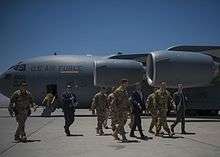
In late June 2016, IS militants attacked police checkpoints in the Kot area of Nangarhar province, heavy fighting between Islamic State militants and government security forces has claimed dozens of lives in eastern Afghanistan, as many as 36 IS militants are reported to have been killed in the assaults, at least a dozen Afghan security forces and civilians have been killed, with another 18 wounded. The latest attacks indicate the group remains a potent threat to a government already battling an insurgency dominated by the rival Taliban.[438][439]
.jpg)
Afghan forces have been battling the Taliban in northeastern Kunduz as part of the Afghan forces' own spring offensive.[383] On 14 April, hundreds of Taliban and other insurgents attempted to retake Kunduz, however Afghan forces repelled the assault, according to Kunduz provincial police chief, allegedly killing 40 and injuring between 8 and 60 Taliban, whilst Afghan forces suffered 4 killed and 6 wounded. U.S. surveillance aircraft are supporting Afghan forces as they try to push the Taliban back, there has also been fighting in at least 6 other districts, where a further 28 Taliban fighters were killed with another 28 wounded.[440][441][442] On 18 July 2016, at least 100 Taliban fighters attacked Qalai Zal district, Kunduz Province, in an attempt to take the district, but Afghan forces pushed them back, 8 Taliban – including a commander – were killed, while 1 Afghan security force member was killed and three others wounded.[443]
The Taliban executed at least 10 people, some of whom were reportedly off-duty soldiers from the Afghan army on 31 May 2016 after kidnapping up to 220 people from buses and cars at a checkpoint on the Kunduz-Takhar highway. The majority of the passengers were released after they were interrogated by the Taliban insurgents, however at least 18 individuals still remained hostage.[444][445][446] On 7 June 2016, in Ghazni province 12 members of Afghan security forces were killed, they include seven policemen, three soldiers, and two officials from the National Directorate of Security, the next day in the northern province of Kunduz Taliban fighters stopped a bus on a highway near the provincial capital and abducted 40 passengers—the second such abduction in the province in less than two weeks.[447]
On 1 June 2016, Taliban insurgents stormed a court in the Afghan city of Ghazni, clashing with police for at least an hour in an attack in which 10 people, including all five of the militants, were killed, police said. The attack came days after the Taliban, vowed to seek revenge for the execution last month of six Taliban prisoners by the Afghan government.[448] Another retaliatory attack for the execution of prisoners by the Afghan government came on 5 June 2016, leaving at least 5 people killed and at least 19 others injured at an appeals court in Pul-e Alam in Logar province, among the five killed in the attack was the newly named head of the appeals court.[449] Later same day an Afghan member of parliament, Shir Wali Wardak, was killed by a bomb planted near his residence in the capital Kabul, another 11 people were injured by the blast, no group has claimed responsibility.[450]
In June 2016, President Obama approved a policy to give the U.S. military greater ability to accompany and enable Afghan forces fighting the Taliban; the decision also allows greater use of US air power, particularly in CAS missions. The US commander in Afghanistan, General John Nicholson, will now be able to decide when it is appropriate for American troops to accompany conventional Afghan forces into the field; something they have so far only been allowed to do with Afghan special forces. A senior US defence official said that the expanded powers are only meant to be employed "in those select instances in which their engagement can enable strategic effects on the battlefield". Previous US rules of engagement in Afghanistan impose limits on US forces ability to strike at insurgents; being allowed to take action against the Taliban in moments when their assistance was needed to prevent a significant Afghan military setback.[451] The Taliban are refocusing their attention mostly on Helmand, Kandahar and Uruzgan province, according to U.S. and Afghan military officials, although the insurgents also have struck elsewhere. The Taliban still have a large presence in the region with as many as 25,000 fighters with more than 30,000 Afghan security forces fighting to quell the group's resurgence.[452] On 24 June, it was reported that in the previous week, the U.S. military had launched its first airstrikes against the Taliban since the change in US policy; carrying out a "couple" of airstrikes on targets in southern Afghanistan.[453] In July 2016, President Obama announced that he plans to leave 8,400 US troops in Afghanistan when he finishes his term – instead of reducing the number of personnel to 5,500 troops by the end of this year, reflecting the difficulty of drawing down the US presence in the country.[443][454] Whilst the UK sent up to 50 additional military personnel to Afghanistan: 21 will join the counter-terrorism mission, 15 will be involved in a leadership development at the Afghan army's officer training academy, and 13 will join the Resolute Support Mission, joining the 450 British troops already in the country. UK troops had been due to leave Afghanistan this year but will now have their mission extended into 2017.[454] On 30 June 2016, two suicide bombers attacked an Afghan police convoy carrying recently graduated cadets on the western outskirts of the capital Kabul, killing up to 40 cadets, while injuring 40 more. The incident comes 10 days after an attack on a bus carrying Nepali security guards working for the Canadian embassy in Kabul that killed 14 people.[455][456]
As of July 2016, the US American Time magazine estimated that at least 20% of Afghanistan was under Taliban control with southernmost Helmand Province as major stronghold,[457] while US commanding General in Afghanistan, J.M. Nicholson, stated that Afghan official armed forces' casualties had risen 20 percent compared to 2015.[407] On 23 July 2016, Afghan and U.S. forces began an offensive to clear Nangarhar province of Islamic State militants hours after the Kabul bombing, the operation was dubbed "Wrath of the Storm" involving both Afghan regular army and special forces and is the Afghan army's first major strategic offensive of the summer. The operation was backed by U.S. special forces troops and airstrikes; 5 US special forces troops were wounded by small arms fire or shrapnel over 24 and 25 July whilst clearing areas of southern Nangarhar with Afghan special operations troops, it appeared to be the first reported instance of U.S. troops being wounded in fighting ISIL in Afghanistan. On 26 July, in overnight raid in Kot district during the operation, supported by foreign air support, one of the most important leaders of IS in the region, Saad Emarati, one of the founders of the ISIL-KP, was killed along with 120 other suspected militants killed; by 30 July killed hundreds of IS militants in eastern Afghanistan. Afghan troops pushed into Kot district after a heavy air and artillery bombardment that forced Daesh to flee into nearby mountain areas, Afghan forces met little resistance, finding an already destroyed training camp, by 30 July, the provincial governor said that 78 Daesh fighters had been killed in the operation. The operation reclaimed large and significant parts of eastern Afghanistan, forcing Daesh militants back into the mountains of southern Nangarhar. The estimated size of the ISIL-KP in January 2016 was around 3,000, but by July 2016 the number had been reduced to closely 1,000 to 1,500, with 70% of its fighters come from the TTP.[407][458][459][460][461]
_memorialize_two_of_their_fallen_brothers_during_a_memorial_held_at_Kunduz_Airfield_in_Afghanistan_on_Nov._7%2C_2016.jpg)
On 4 October 2016, A US soldier from B Company, 2nd Battalion, 10th SFG was killed by a roadside bomb blast in Achin, Nangarhar province, he was on a patrol with Afghan forces during an operation against ISIL-K militants.[462] This marked the first time a U.S. serviceman was killed in combat against IS militants in the country.[463] The Washington Post reported that during October, as part of coordinated attacks on several cities in the country in an attempt to retake territory lost during the invasion, Farah was besieged for three weeks by the Taliban and was only ended with US air support. Afghan intelligence officials said four dead Iranian Commandos were discovered, village elders told Afghan provincial officials that many Taliban dead and wounded were taken back across the Iranian border, where the insurgents had been recruited and trained.[464] CNN reported that during the month, US aircraft dropped 203 bombs, missiles and other munitions on Taliban and local ISIS targets in Afghanistan.[465]
In December 2016, CNN reported that The Afghan air force was just beginning to conduct its first independent airstrikes; whilst the Afghan government had become increasingly reliant on Afghan Special Forces to carry out the fight against ISIS and the Taliban – the 17,000-strong force is responsible for 70% of offensive military operations, an operational tempo that the commander of the international coalition, General John Nicholson acknowledged is difficult to sustain. As of December 2016, there are 9,800 US service members in Afghanistan, Nicholson told reporters at the Pentagon that the number of US forces would be reduced to 8,450 by 2017; the US and its 39 coalition partners in Afghanistan are committed to providing support to Afghanistan for through 2020, in particular, Nicholson added that the international community had pledged millions of dollars and advisory support to Afghanistan – these commitments would help grow the size of the Afghan Special Forces. Even with the US providing advisers and airstrikes to the Afghan forces, the US military believes that the government only controls about 64% of the country, with the Taliban controlling about 10% and the remainder being contested by the army and the insurgency; Nicholson also said that US-led operations in 2016 had killed or captured 50 leaders from al Qaeda and AQIS.[466] On 24 December 2016, Military.com reported that Brigadier General Charles Cleveland said that ISIL-K's presence in the country has been pushed back from nearly a dozen districts to just two or three, the number of its members in Afghanistan had been reduced to about 1,000 from an estimated strength of between 1,500 and 3,000 members the previous year. Overall, U.S. troops in Afghanistan conducted more than 350 operations against the IS and al-Qaeda this year, more than 200 al-Qaeda members were killed or captured. In early December, General John Nicholson said U.S.-led counter-terrorism operations and Afghan government forces had killed 12 of the organization's top leaders in the country; U.S. officials have said IS fighters are primarily located in Nangarhar and Kunar Province's and Al-Qaida fighters operate in at least 6 provinces also along the country's eastern border.[467] In January 2017, the Marine Corps Times reported that according to an inspector general, the Afghan army comprises about 169,000 soldiers, but in 2016 they suffered a 33 percent attrition rate—a 7 percent increase from 2015.[418]
2016 peace deal
On 22 September 2016, the Afghan government signed a draft peace deal with Hezb-i-Islami. According to the draft agreement, Hezb-i-Islami agreed to cease hostilities, cut ties to extremist groups and respect the Afghan Constitution, in exchange for government recognition of the group and support for the removal of United Nations and American sanctions against Hekmatyar, who was also promised an honorary post in the government.[468][469] The agreement was formalized on 29 September by both Afghan President Ashraf Ghani and Hekmatyar who appeared via a video link in the presidential palace, signing the agreement.
2017
Events
.svg.png)
In early January 2017, the Marine Corps Times reported that Afghan forces seek to rebuild, following an exhausting 2016 fighting season; 33 districts, which are spread across 16 Afghan provinces, are under insurgent control whilst 258 are under government control and nearly 120 districts remain "contested".[418]
On 9 February 2017, General John W. Nicholson Jr. told Congress that NATO and allied forces in Afghanistan are facing a "stalemate" and that he needed a few thousand additional troops to more effectively train and advise Afghan soldiers. He also asserted that Russia was trying to "legitimize" the Taliban by creating the "false narrative" that the militant organization has been fighting the Islamic State and that Afghan forces have not, he asserted Russia's goal, was "to undermine the United States and NATO" in Afghanistan. However he said that the area in which Islamic State fighters operate in Afghanistan had been greatly reduced.[470] A U.S. Special Forces soldier was severely wounded that day when the base he was at was attacked in Helmand province, raising the number of U.S. troops injured in combat nationwide so far this year to at least 6, Nicholson indicated the soldier was wounded in Sangin.[471]
The Military Times reported that on 26 February 2017, a USAF airstrike that killed the Taliban leadership commander Mullah Abdul Salam in Kunduz province in a joint operation with Afghan security forces. The airstrike marked a renewed strategy by U.S. forces under the Trump administration to remove the Taliban leadership/commanders from the battlefield. The Obama administration strategy had focused much of its efforts in pushing reconciliation between the Taliban and the central government of Afghanistan; although in June 2016, to turn back the tide of Taliban gains, President Obama changed the rules of engagement to give U.S. commanders more flexibility to provide airstrikes and ground support to struggling Afghan forces, if those efforts were perceived to provide "strategic effects." It made a concerted effort to kill high-profile al-Qaeda and Haqqani terrorists-groups officially designated as terrorist organizations by the U.S. State Department-while attempting to draw down U.S. and NATO forces in the region, having a tangible successes.[472]
The Army Times reported that in early March 2017, American and Afghan forces launched Operation Hamza to "flush" ISIS-K from its stronghold in eastern Afghanistan, engaging in regular ground battles.[473] Stars and Stripes reported that General Dawlat Waziri, spokesman for Afghanistan's Defense Ministry, said that for four weeks before 13 April Nangarhar airstrike (which was part of the operation), Afghan special forces unsuccessfully attempted to penetrate the area because of the difficult terrain and improvised explosive device (IEDs) planted by ISIS-KP militants.[474] The governor of Achin province Ismail Shinwary, confirmed to the BBC that two weeks preceding the strike that Afghan special forces, with the US air support, had begun anti-IS operations in the area two weeks ago.[475]
In April 2017, the Washington Post reported that Captain Bill Salvin, a spokesman for NATO's mission to Afghanistan, said that Afghan and international forces had reduced ISIS-K controlled territory in Afghanistan by two-thirds and had killed around half their fighters in the previous two years. Since the beginning of 2017, 460 airstrikes against terrorists (with drone strikes alone killing more than 200 IS militants); he added that the affiliate has an estimated 600-800 fighters in two eastern Afghan provinces.[476]
On 13 April 2017, the United States dropped[477] the largest non-nuclear bomb, known as the GBU-43/B Massive Ordnance Air Blast (MOAB) Mother of All Bombs, at 34.073336, 70.631215 (latitude and longitude coordinates) near Momand village[478] upon a Nangahar's Achin District village in eastern Afghanistan to destroy tunnel complexes used by the Islamic State of Iraq and the Levant – Khorasan Province (ISIL-KP or ISIS-K).[479][480][481] The Guardian reported that following the strike, US and Afghan forces conducted clearing operations and airstrikes in the area and assessed the damage.[482]
On 21 April 2017, Islamic Emirate of Afghanistan fighters along with Afghan security forces allied to them stormed 209th Corps military base near Mazar-e-Sharif, killing over 140 Afghan soldiers.[483][484][485]
On 28 April 2017, the Washington Post reported that the Taliban announced the beginning of their spring offensive dubbed "Operation Mansouri."[486] On 20 May, Islamic Emirate of Afghanistan fully secured Waghaz District in the province of Ghazni, while at the same time stormed Dih Yak district center and blew up Governor of Ghazni compound in Ghazni city.[487] Another major assault took place on 22 May in Shah Wali Kot district, Northern Kandahar province, during which Taliban managed to capture large military base, while inflicting heavy casualties to the Afghan army, reportedly killing 35 and capturing 4 soldiers as well as 3 Armoured Personnel Carriers. During the same day they had overran a border outpost in southern Shorabak district, killing 15 soldiers, in addition to another outpost in district of Khakrez, killing 8 more. The next day rebels assaulted another military base in Shah Wali Kot and an outpost, killing 4 soldiers and injuring 4 more, while pro-government forces abandoned a village in northern district of Maruf. On 24 May Taliban assaulted a base in Maiwand district killing 13 soldiers.[488] Taliban launched another attack in province of Kandahar on 26 May, killing at least 18 soldiers, injuring 16 more and capturing 4 according to security officials, while the group itself claimed to have killed 35 soldiers and capturing 7 more, while also seizing 7 Armoured Personnel Carriers and an array of weapons[489] On 27 May, 13 members of Khost Provincial Force, a CIA funded and equipped paramilitary group, known for torture and extrajudicial killings, were killed after a Taliban car bomb blew up in Khost city.[490]
On 31 May 2017, the German embassy in Kabul was attacked by a suicide truck, located in the heavily fortified area of Kabul, killing over 90 and injuring over 350.[491][492][493] No one has claimed responsibility for the attack yet. The bomb went off at about 08:25 local time (03:55 GMT) during rush hour.[492] The fortified area is considered the safest area of Kabul, with 3 m (10 ft) tall blast walls.[492] India's foreign minister Sushma Swaraj said its embassy staff were safe.
On 23 August 2017, the Taliban captured the district of Zana Khan in Ghazni Province after a series of clashes with Afghan security forces.[494]
The Guardian reported that following the announcement of Donald Trump new strategy in the country, More than 900 munitions were released in August and September, bringing the total number of munitions used in 2017 to nearly 3,000, more than twice the expended munitions in 2016.[495]
On 14 October 2017, The Guardian reported that there were then between 600 and 800 ISIL-KP militants left in Afghanistan, who are mostly concentrated in Nangarhar Province.[496] CNN reported that throughout October, US aircraft dropped 653 bombs, missiles and other munitions on Taliban and local ISIL targets in Afghanistan; military officials said that the success against ISIS in Iraq and Syria has freed up air assets to be deployed to Afghanistan and other theatres.[465]
The Washington Post reported that on 20 November 2017, General John W. Nicholson announced that US aircraft were targeting drug production facilities in Afghanistan under a new strategy aimed at cutting off Taliban funding, saying that the Taliban was "becoming a criminal organization" that was earning about $200 million a year from drug-related activities. President Ashraf Ghani strongly endorsed the new campaign of U.S. and Afghan airstrikes against the Taliban-run narcotic centers; the following day, a spokesman for the Helmand governor's office said that the past week's air operations involving coalition forces and Afghan air force planes conducted "direct strikes on Taliban hideouts and narcotics centers" (8 strikes by the coalition and 2 by the afghan air force), killing more than 40 Taliban fighters and that a "main processing center of narcotics was destroyed" along with about 2,200 pounds of drugs.[497] CNN reported that the campaign is known as Operation Jagged Knife, three of the strikes occurred in Kajaki district, four in Musa Qala and one in Sangin; a Pentagon spokesman said that the airstrikes were carried out by US F-16s and B-52s, General Nicholson told reporters at the Pentagon that a US F-22 Raptor and Afghan Air Force A-29s also participated in the strikes. Nicholson estimated that there are approximately 400 to 500 such facilities in Afghanistan and that "these operations will continue on in the coming days."[498] CNN also reported that General Nicholson said "our priority's been in Iraq and Syria and, as we continue to see success there, we hope to see more assets coming over to enable us to do more of these kinds of operations," the strikes marked the first time commanders used their newly granted authorities to target Taliban revenue sources.[465] Vice President Mike Pence announced on 21 December 2017 that Afghan President Ashraf Ghani told him that more senior Taliban leaders have been killed in 2017 than in all prior years of the war combined. Pence also stated that the USA was making great progress with the war in Afghanistan.[499]
Donald Trump's Afghanistan policy
On 21 August 2017, US President Donald Trump stated that he would expand the American presence in Afghanistan, without giving details on how or when.[500] Trump did not formulate any timelines, troop numbers or specific purposes to be met; only that a US withdrawal was not an option now as it would play into the hands of terrorists and that publicising deadlines and exact plans would only help those groups prepare.[501][502] Trump also said that 20 US designated terrorist organizations are active in Afghanistan and Pakistan. According to The Washington Post, this contradicts the official US Government list which only has 13 such organizations.[503]
The Guardian reported that Afghan government officials praised the new strategy, not only for increasing troop numbers and removing with strict timelines, but for increasing pressure on Pakistan-which they see as a main sponsor of the insurgency. In a televised address, President Trump said a new approach to Pakistan would be a "pillar" of the new strategy, adding that "we can no longer be silent about Pakistan's safe havens for terrorist organisations, the Taliban and other groups that pose a threat to the region and beyond;" Najibullah Azad, a spokesman for the Afghan president, said that "the strategy is made in accordance with realities on the ground," and that "this is the first time the US government is coming with a very clear-cut message to Pakistan to either stop what you're doing or face the negative consequences." Other statements by Afghan officials such as Davood Moradian, the director general of the Afghan Institute for Strategic Studies in Kabul, said that "the new strategy is premised on 'peace through strength', in contrast to Obama's failed approach, which was essentially 'peace through appeasement'." In response, Pakistani security officials accused Trump of shifting blame for its failures in the war against the Taliban and other armed groups in Afghanistan and of endangering the already fraught bilateral relations between the two countries.[504]
On 15 September 2017, the New York Times reported that the CIA was looking to reportedly seeking authority to conduct its own drone strikes in Afghanistan and other war zones, according to current and former intelligence and military officials, the change in authority was being considered by the White House as part of the new strategy, despite concerns by the Pentagon.[505] On 19 September 2017, the Trump Administration deployed another 3,000 US troops to Afghanistan. They will add to the approximately 11,000 US troops already serving in Afghanistan, bringing the total to at least 14,000 US troops stationed in Afghanistan.[506] On 4 October 2017, Fox News reported that Defense Secretary Jim Mattis approved a change in rules of engagement as part of the new strategy so that there is no longer a requirement for US troops to be in contact with enemy forces in Afghanistan before opening fire.[507]
2018
Events
In January 2018, the BBC reported that the Taliban are openly active in 70% of the country (being in full control of 14 districts and have an active and open physical presence in a further 263) and that Islamic State is more active in the country than ever before. Following attacks by the Taliban and Islamic State that killed scores of civilians, President Trump and Afghan officials decided to rule out any talks with the Taliban.[508]
On 15 February 2018, The New York Times reported the rise of Afghan civilians being intentionally targeted by the Taliban, based on an annual United Nations report released a week earlier. This report offered a detailed assessment of the 16 year Afghan war, showing the rise of complex bombing attacks deliberately targeting civilians in 2017, having 10,453 Afghan civilians wounded or killed.[509] As the US and Afghan government are publishing fewer statistics, the UN report is one of the most reliable indicators about the war's impact by 2018. The report emphasizes the rise of "complex attacks", a type of suicide assault that is becoming more deadly, described by the New York Times as the hallmark of the war in 2018. These attacks are referred to as the Taliban's ferocious response to US President Trump's new strategy of war, an increased pace of aerial bombardments targeting Taliban and Islamic State Militants, giving the message that the Taliban can strike at will, even in the capital city, Kabul. The UN report included a statement showing the Taliban's position, the Taliban blamed the U.S and its allies for fighting war in Afghanistan, and it denied targeting civilians. The New York Times quoted Atiqullah Amarkhel, a retired general and military analyst based in Kabul, saying that the UN report proved the failure of peace talks, as the Taliban and the US government are both determined for victory rather than negotiating settlement. He said "More airstrikes mean more suicide attacks," proving the intensification of the war by 2018.[510]
In September 2018, the United Nations raised concerns over the increasing number of civilian casualties due to air strikes in Afghanistan. The U.S. air force dropped around 3,000 bombs in the first six months of the year, to force Taliban militants for peace talks. In a statement issued by the UNAMA, it reminded all the parties involved in the conflict "to uphold their obligations to protect civilians from harm.”[511]
Impact on Afghan society
Civilian casualties
According to the Watson Institute for International Studies Costs of War Project, roughly 31,000 civilians had been killed as a result of the war up to the middle of 2016.[83] A report titled Body Count put together by Physicians for Social Responsibility, Physicians for Global Survival and the Nobel Peace Prize-winning International Physicians for the Prevention of Nuclear War (IPPNW) concluded that 106,000–170,000 civilians have been killed as a result of the fighting in Afghanistan at the hands of all parties to the conflict.[512]

A UN report over the year 2009 stated that, of the 1,500 civilians having died from January until the end of August 2009, 70% were blamed on "anti-government elements".[513]
The US website of The Weekly Standard stated in 2010, referring to a UN Report, that 76% of civilian deaths in Afghanistan over the past year had been "caused by the Taliban".[514] That is a misquotation of the UNAMA Report, which does not attribute numbers of deaths directly to the Taliban, but to "anti-government elements" (AGE) and to "pro-government forces" (PGF). Over the period January until June 2010, indeed the report published in August 2010 stated that, of all 3,268 civilian casualties (dead or wounded), 2,477 casualties (76%) were caused by AGE, 386 caused by PGF (11%).[515]
Over the whole of 2010, with a total of 2,777 civilians killed, the UN reported 2,080 civilian deaths caused by "anti-government elements" (75%), "pro-government forces" caused 440 deaths, and 257 deaths "could not be attributed to any party".[516][517]
In July 2011, a UN report said "1,462 non-combatants died" in the first six months of 2011 (insurgents 80%).[518] In 2011 a record 3,021 civilians were killed, the fifth successive annual rise.[519] According to a UN report, in 2013 there were 2,959 civilian deaths with 74% being blamed on anti-government forces, 8% on Afghan security forces, 3% on ISAF forces, 10% to ground engagements between anti-Government forces and pro-Government forces and 5% of the deaths were unattributed.[520] 60% of Afghans have direct personal experience and most others report suffering a range of hardships. 96% have been affected either personally or from the wider consequences.[521]
In 2015, according to the United Nations (UN) annual report there were 3,545 civilian deaths and 7,457 people wounded.[522] The anti-government elements were responsible for 62 percent of the civilians killed or wounded. The pro-government forces caused 17 percent of civilian deaths and injuries – including United States and NATO troops, which were responsible for about 2 percent of the casualties.[523]
In 2016, a total of 3,498 civilians deaths and 7,920 injuries were recorded by the United Nations. The UN attributed 61% of casualties to anti-government forces.[524] Afghan security forces caused about 20 percent of the overall casualties, while pro-government militias and Resolute Support Mission caused 2 percent each. Air strikes by US and NATO warplanes resulted in at least 127 civilian deaths and 108 injuries. While, the Afghan air force accounted for at least 85 deaths and 167 injuries. The UN was not able to attribute responsibility for the remaining 38 deaths and 65 injuries resulting from air strikes.[525]
Health
According to Nicholas Kristoff, improved healthcare resulting from the war has saved hundreds of thousands of lives.[526]
Refugees
Since 2001, more than 5.7 million former refugees have returned to Afghanistan,[527][528][529] but 2.2 million others remained refugees in 2013.[530] In January 2013 the UN estimated that 547,550 were internally displaced persons, a 25% increase over the 447,547 IDPs estimated for January 2012[529][530][531]
Interpreters
Afghans who interpreted for the British army have been tortured and killed in Afghanistan, including their families. As of May 2018 the UK government has not resettled any interpreter or family member in the UK.[532]
Drug trade
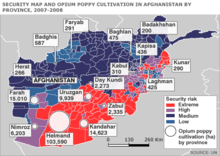
From 1996 to 1999, the Taliban controlled 96% of Afghanistan's poppy fields and made opium its largest source of revenue. Taxes on opium exports became one of the mainstays of Taliban income. According to Rashid, "drug money funded the weapons, ammunition and fuel for the war." In The New York Times, the Finance Minister of the United Front, Wahidullah Sabawoon, declared the Taliban had no annual budget but that they "appeared to spend U.S.$300 million a year, nearly all of it on war". He added that the Taliban had come to increasingly rely on three sources of money: "poppy, the Pakistanis and bin Laden".[533]
By 2000 Afghanistan accounted for an estimated 75% of the world's opium supply and in 2000 produced an estimated 3276 tonnes from 82,171 hectares (203,050 acres).[534] Omar then banned opium cultivation and production dropped to an estimated 74 metric tonnes from 1,685 hectares (4,160 acres).[535] Some observers say the ban – which came in a bid for international recognition at the United Nations – was issued only to raise opium prices and increase profit from the sale of large existing stockpiles. 1999 had yielded a record crop and had been followed by a lower but still large 2000 harvest. The trafficking of accumulated stocks continued in 2000 and 2001. In 2002, the UN mentioned the "existence of significant stocks of opiated accumulated during previous years of bumper harvests". In September 2001 – before 11 September attacks against the U.S. – the Taliban allegedly authorized Afghan peasants to sow opium again.[533]
Soon after the invasion opium production increased markedly.[536] By 2005, Afghanistan was producing 90% of the world's opium, most of which was processed into heroin and sold in Europe and Russia.[537] In 2009, the BBC reported that "UN findings say an opium market worth $65bn (£39bn) funds global terrorism, caters to 15 million addicts, and kills 100,000 people every year".[538]
Public education
As of 2017, the Afghan government has cooperated with Taliban forces to provide education services: in Khogyani District, the government is given "nominal control" by local Taliban fighters in return for paying the wages of teachers whom the Taliban appoint in local schools.[539]
Girls' education
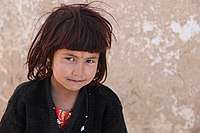
As of 2013, 8.2 million Afghans attended school, including 3.2 million girls, up from 1.2 million in 2001, including fewer than 50,000 girls.[540][541]
While the Taliban have typically opposed girls' education, in 2017 in Khogyani District it has allowed girls to receive education in order to improve its standing among local residents.[539]
War crimes
War crimes (a serious violation of the laws and customs of war giving rise to individual criminal responsibility)[542] have been committed by both sides including civilian massacres, bombings of civilian targets, terrorism, use of torture and the murder of prisoners of war. Additional common crimes include theft, arson, and the destruction of property not warranted by military necessity.
Taliban
In 2011, The New York Times reported that the Taliban was responsible for 3⁄4 of all civilian deaths in the war in Afghanistan.[543][544] In 2013 the UN stated that the Taliban had been placing bombs along transit routes.[545]
In 2015, Amnesty International reported that the Taliban committed mass murder and gang rape of Afghan civilians in Kunduz.[546] Taliban fighters killed and raped female relatives of police commanders and soldiers as well as midwives.[546] One female human rights activist described the situation in the following manner:[546]
When the Taliban asserted their control over Kunduz, they claimed to be bringing law and order and Shari'a to the city. But everything they've done has violated both. I don't know who can rescue us from this situation.
Northern Alliance
In December 2001, the Dasht-i-Leili massacre took place, where between 250 and 3,000 Taliban fighters who had surrendered, were shot and/or suffocated to death in metal truck containers during transportation by Northern Alliance forces. Reports place U.S. ground troops at the scene.[547][548][549] The Irish documentary Afghan Massacre: The Convoy of Death investigated these allegations and claimed that mass graves of thousands of victims were found by UN investigators[550] and that the U.S. blocked investigations into the incident.[551]
Coalition
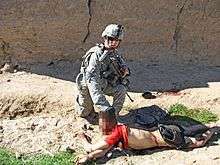
On 21 June 2003, David Passaro, a CIA contractor and former United States Army Ranger, killed Abdul Wali, a prisoner at a U.S. base 16 km (10 mi) south of Asadabad, in Kunar Province. Passaro was found guilty of one count of felony assault with a dangerous weapon and three counts of misdemeanor assault. On 10 August 2009, he was sentenced to 8 years and 4 months in prison.[552][553]
In 2002, two unarmed civilian Afghan prisoners were tortured and later killed by U.S. armed forces personnel at the Bagram Theater Internment Facility (also Bagram Collection Point or B.C.P.) in Bagram, Afghanistan.[554] The prisoners, Habibullah and Dilawar, were chained to the ceiling and beaten, which caused their deaths.[555] Military coroners ruled that both the prisoners' deaths were homicides.[556] Autopsies revealed severe trauma to both prisoners' legs, describing the trauma as comparable to being run over by a bus. Fifteen soldiers were charged.
During the summer of 2010, ISAF charged five United States Army soldiers with the murder of three Afghan civilians in Kandahar province and collecting their body parts as trophies in what came to be known as the Maywand District murders. In addition, seven soldiers were charged with crimes such as hashish use, impeding an investigation and attacking the whistleblower, Specialist Justin Stoner.[557][558][559] Eleven of the twelve soldiers were convicted on various counts.[560]
A British Royal Marine Sergeant, identified as Sergeant Alexander Blackman from Taunton, Somerset,[561] was convicted at court martial in Wiltshire of the murder of an unarmed, reportedly wounded, Afghan fighter in Helmand Province in September 2011.[562] In 2013, he received a life sentence from the court martial in Bulford, Wiltshire, and was dismissed with disgrace from the Royal Marines. In 2017, after appeal to the Court Martial Appeal Court (CMAC), his conviction was lessened to manslaughter on the grounds of diminished responsibility and the sentence was reduced to seven years effectively releasing Blackman due to time served.[563]
On 11 March 2012, the Kandahar massacre occurred when sixteen civilians were killed and six wounded in the Panjwayi District of Kandahar Province, Afghanistan.[564][565] Nine of the victims were children,[565] and eleven of the dead were from the same family.[566] United States Army Staff Sergeant Robert Bales was taken into custody and charged with sixteen counts of premeditated murder. After pleading guilty to sixteen counts of premeditated murder, Bales was sentenced to life in prison without parole and dishonorably discharged from the United States Army.[567]
Costs
The cost of the war reportedly was a major factor as U.S. officials considered drawing down troops in 2011.[568] A March 2011 Congressional Research Service report noted, 1) following the Afghanistan surge announcement in 2009, Defense Department spending on Afghanistan increased by 50%, going from $4.4 billion to $6.7 billion a month. During that time, troop strength increased from 44,000 to 84,000, and was expected to be at 102,000 for fiscal year 2011; 2) The total cost from inception to the fiscal year 2011 was expected to be $468 billion.[569] The estimate for the cost of deploying one U.S. soldier in Afghanistan is over U.S.$1 million a year.[570]
According to "Investment in Blood", a book by Frank Ledwidge, summations for the UK contribution to the war in Afghanistan came to £37bn ($56.46 billion).[571]
Criticism of costs
In 2011, the independent Commission on Wartime Contracting reported to Congress that, during the previous decade in Iraq and Afghanistan, the United States had lost between $31 and $60 billion to waste and fraud and that this amount may continue to increase.[572]
In the summer of 2013, preparing for withdrawal the following year, the U.S. military destroyed over 77,000 metric tons of equipment and vehicles worth over $7 billion that could not be shipped back to the United States. Some was sold to Afghans as scrap metal.[573] In 2013, the Special Inspector General for Afghanistan Reconstruction, a U.S. government oversight body, criticized the misuse or waste of hundreds of millions of dollars in U.S. aid, including the $772 million purchase of aircraft for the Afghan military especially since "the Afghans lack the capacity to operate and maintain them."[574]
Stability problems
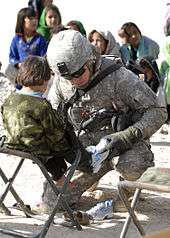
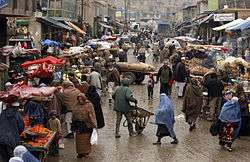
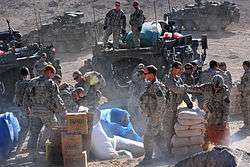
In a 2008 interview, the then-head U.S. Central Command General David H. Petraeus, insisted that the Taliban were gaining strength. He cited a recent increase in attacks in Afghanistan and in neighboring Pakistan. Petraeus insisted that the problems in Afghanistan were more complicated than the ones he had faced in Iraq during his tour and required removing widespread sanctuaries and strongholds.[575]
Observers have argued that the mission in Afghanistan is hampered by a lack of agreement on objectives, a lack of resources, lack of coordination, too much focus on the central government at the expense of local and provincial governments, and too much focus on the country instead of the region.[576]
In 2009, Afghanistan moved three places in Transparency International's annual index of corruption, becoming the world's second most-corrupt country just ahead of Somalia.[577] In the same month, Malalai Joya, a former member of the Afghan Parliament and the author of "Raising My Voice", expressed opposition to an expansion of the U.S. military presence and her concerns about the future. "Eight years ago, the U.S. and NATO – under the banner of women's rights, human rights, and democracy – occupied my country and pushed us from the frying pan into the fire. Eight years is enough to know better about the corrupt, mafia system of President Hamid Karzai. My people are crushed between two powerful enemies. From the sky, occupation forces bomb and kill civilians … and on the ground, the Taliban and warlords continue their crimes. It is better that they leave my country; my people are that fed up. Occupation will never bring liberation, and it is impossible to bring democracy by war."[578]
Pakistan plays a central role in the conflict. A 2010 report published by the London School of Economics says that Pakistan's ISI has an "official policy" of support to the Taliban.[579] "Pakistan appears to be playing a double-game of astonishing magnitude," the report states.[579] Amrullah Saleh, former director of Afghanistan's intelligence service, stated, "We talk about all these proxies [Taliban, Haqqanis] but not the master of proxies, which is the Pakistan army. The question is what does Pakistan's army want to achieve …? They want to gain influence in the region"[580] About the presence of foreign troops in Afghanistan he stated: "[T]hey fight for the U.S. national interest but … without them we will face massacre and disaster and God knows what type of a future Afghanistan will have."[580][581]
Afghan security forces
Afghan National Army
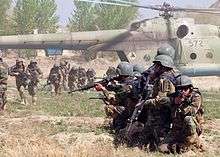
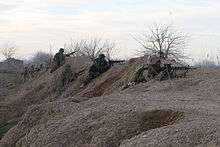
U.S. policy called for boosting the Afghan National Army to 134,000 soldiers by October 2010. By May 2010 the Afghan Army had accomplished this interim goal and was on track to reach its ultimate number of 171,000 by 2011.[582] This increase in Afghan troops allowed the U.S. to begin withdrawing its forces in July 2011.[583][584]
In 2010, the Afghan National Army had limited fighting capacity.[585] Even the best Afghan units lacked training, discipline and adequate reinforcements. In one new unit in Baghlan Province, soldiers had been found cowering in ditches rather than fighting.[586] Some were suspected of collaborating with the Taliban.[585] "They don't have the basics, so they lay down," said Capt. Michael Bell, who was one of a team of U.S. and Hungarian mentors tasked with training Afghan soldiers. "I ran around for an hour trying to get them to shoot, getting fired on. I couldn't get them to shoot their weapons."[585] In addition, 9 out of 10 soldiers in the Afghan National Army were illiterate.[587]
The Afghan Army was plagued by inefficiency and endemic corruption.[588] U.S. training efforts were drastically slowed by the problems.[589] U.S. trainers reported missing vehicles, weapons and other military equipment, and outright theft of fuel.[585] Death threats were leveled against U.S. officers who tried to stop Afghan soldiers from stealing. Afghan soldiers often snipped the command wires of IEDs instead of marking them and waiting for U.S. forces to come to detonate them. This allowed insurgents to return and reconnect them.[585] U.S. trainers frequently removed the cell phones of Afghan soldiers hours before a mission for fear that the operation would be compromised.[590] American trainers often spent large amounts of time verifying that Afghan rosters were accurate – that they are not padded with "ghosts" being "paid" by Afghan commanders who stole the wages.[591]
Desertion was a significant problem. One in every four combat soldiers quit the Afghan Army during the 12-month period ending in September 2009, according to data from the U.S. Defense Department and the Inspector General for Reconstruction in Afghanistan.[592]
In early 2015, Philip Munch of the Afghanistan Analysts' Network wrote that '..the available evidence suggests that many senior ANSF members, in particular, use their positions to enrich themselves. Within the ANSF there are also strong external loyalties to factions who themselves compete for influence and access to resources. All this means that the ANSF may not work as they officially should. Rather it appears that the political economy of the ANSF prevents them from working like modern organisations – the very prerequisite' of the Resolute Support Mission.[593] Formal and informal income, Munch said, which can be generated through state positions, is rent-seeking – income without a corresponding investment of labour or capital. 'Reportedly, ANA appointees also often maintain clients, so that patron-client networks, structured into competing factions, can be traced within the ANA down to the lowest levels. ... There is evidence that Afghan officers and officials, especially in the higher echelons, appropriate large parts of the vast resource flows which are directed by international donors into the ANA.[594]
Special Inspector General for Afghanistan Reconstruction has reported that roughly half of Afghan soldiers brought to the United States for training go absent without leave which may inhibit the operational readiness of their units back in Afghanistan, negatively impact the morale of other trainees and home units and pose security risks to the United States.[595]
Afghan National Police
The Afghan National Police provides support to the Afghan army. Police officers in Afghanistan are also largely illiterate. Approximately 17 percent of them tested positive for illegal drugs in 2010. They were widely accused of demanding bribes.[596] Attempts to build a credible Afghan police force were faltering badly, according to NATO officials.[597] A quarter of the officers quit every year, making the Afghan government's goals of substantially building up the police force even harder to achieve.[597]
Tactics/strategy of anti-government elements
The armed opposition or anti-government elements – some Western news media tend to address them all simply as "Taliban"[598] – have from 2008 into 2009 shifted their tactics from frontal attacks on pro-government forces to guerrilla type activities, including suicide, car and road side bombs (IEDs), and targeted assassinations, said a UNAMA report in July 2009.[599] Mr. Maley, an Afghanistan expert at the Australian National University, stated in 2009 that IEDs had become Taliban's weapon of choice.[598]
In 2008–2009, according to the Christian Science Monitor, 16 improvised explosive devices (IEDs) were planted in girls' schools in Afghanistan, but there's no certainty who did that.[598]
ISAF conception of Taliban strategy
In 2009, Colonel Richard Kemp, formerly Commander of British forces in Afghanistan and current intelligence coordinator for the British government – thus part of the anti-Taliban coalition (ISAF), made these comments about the Taliban tactics and strategy as he perceived them:
Like Hamas in Gaza, the Taliban in southern Afghanistan are masters at shielding themselves behind the civilian population and then melting in among them for protection. Women and children are trained and equipped to fight, collect intelligence, and ferry arms and ammunition between battles. Female suicide bombers are increasingly common. The use of women to shield gunmen as they engage NATO forces is now so normal it is deemed barely worthy of comment. Schools and houses are routinely booby-trapped. Snipers shelter in houses deliberately filled with women and children.[600][601]
Insider attacks
Beginning in 2011, insurgent forces in Afghanistan began using a tactic of insider attacks on ISAF and Afghan military forces. In the attacks, Taliban personnel or sympathizers belonging to, or pretending to belong to, the Afghan military or police forces attack ISAF personnel, often within the security of ISAF military bases and Afghan government facilities. In 2011, for example, 21 insider attacks killed 35 coalition personnel. Forty-six insider attacks killed 63 and wounded 85 coalition troops, mostly American, in the first 11 months of 2012.[602] The attacks continued but began diminishing towards the planned 31 December 2014 ending of combat operations in Afghanistan by ISAF. However, on 5 August 2014, a gunman in an Afghan military uniform opened fire on a number of international military personnel, killing a U.S. general and wounding about 15 officers and soldiers, including a German brigadier general and 8 U.S. troops, at a training base west of Kabul.[321]
Reactions
Domestic reactions
In November 2001, the CNN reported widespread relief amongst Kabul's residents after the Taliban fled the city, with young men shaving off their beards and women taking off their burqas.[603] Later that month the BBC's longtime Kabul correspondent Kate Clark reported that "almost all women in Kabul are still choosing to veil" but that many felt hopeful that the ousting of the Taliban would improve their safety and access to food.[604][A 1]
A 2006 WPO opinion poll found that the majority of Afghans endorsed America's military presence, with 83% of Afghans stating that they had a favorable view of the U.S. military forces in their country. Only 17% gave an unfavorable view.[605] The majority of Afghans, among all ethnic groups including Pashtuns, stated that the overthrowing of the Taliban was a good thing. 82% of Afghans as a whole and 71% of those living in the war zone held this anti-Taliban view.[606] The Afghan population gave the U.S.A one of its most favorable ratings in the world. A solid majority (81%) of Afghans stated that they held a favorable view of the U.S.A.[607] However, the majority of Afghans (especially those in the war zone) held negative views on Pakistan and most Afghans also stated that they believe that the Pakistani government was allowing the Taliban to operate from its soil.[608]
Polls of Afghans displayed strong opposition to the Taliban and significant support of the U.S. military presence. However the idea of permanent U.S. military bases was not popular in 2005.[609]

According to a May 2009 BBC poll, 69% of Afghans surveyed thought it was at least mostly good that the U.S. military came in to remove the Taliban – a decrease from 87% of Afghans surveyed in 2005. 24% thought it was mostly or very bad – up from 9% in 2005. The poll indicated that 63% of Afghans were at least somewhat supportive of a U.S. military presence in the country – down from 78% in 2005. Just 18% supported increasing the U.S. military's presence, while 44% favored reducing it. 90% of Afghans surveyed opposed the Taliban, including 70% who were strongly opposed. By an 82%–4% margin, people said they preferred the current government to Taliban rule.[610]
In a June 2009 Gallup survey, about half of Afghan respondents felt that additional U.S. forces would help stabilize the security situation in the southern provinces. But opinions varied widely; residents in the troubled South were mostly mixed or uncertain, while those in the West largely disagreed that more U.S. troops would help the situation.[611]
In December 2009, many Afghan tribal heads and local leaders from the south and east called for U.S. troop withdrawals. "I don't think we will be able to solve our problems with military force," said Muhammad Qasim, a Kandahar tribal elder. "We can solve them by providing jobs and development and by using local leaders to negotiate with the Taliban."[612] "If new troops come and are stationed in civilian areas, when they draw Taliban attacks civilians will end up being killed," said Gulbadshah Majidi, a lawmaker and close associate of Mr. Karzai. "This will only increase the distance between Afghans and their government."[613]
In late January 2010, Afghan protesters took to the streets for three straight days and blocked traffic on a highway that links Kabul and Kandahar. The Afghans were demonstrating in response to the deaths of four men in a NATO-Afghan raid in the village of Ghazni. Ghazni residents insisted that the dead were civilians.[614]
A 2015 survey by Langer Research Associates found that 77% of Afghans support the presence of U.S. forces; 67% also support the presence of NATO forces. Despite the problems in the country, 80% of Afghans still held the view that it was a good thing for the United States to overthrow the Taliban in 2001. More Afghans blame the Taliban or al-Qaeda for the country's violence (53%) than those who blame the U.S.A (12%).[615]
- ↑ Reporting in Kabul had been severely limited first by the Taliban's ban on nearly all foreign news organizations and subsequently by US bombing which destroyed Al Jazeera's Kabul headquarters and damaged the BBC's and Associated Press' offices; no journalists died as a result of the US bombing. https://cpj.org/2002/03/attacks-on-the-press-2001-afghanistan.php
International reactions
A 47-nation global survey of public opinion conducted in June 2007 by the Pew Global Attitudes Project found considerable opposition to the NATO military operations in Afghanistan. Only Israel and Kenya citizens were in favor of the war.[616] On the other hand, in 41 of the 47 countries pluralities wanted NATO troops out of Afghanistan as soon as possible. The authors of the survey mentioned a "global unease with major world powers" and in America that "Afghan War not worth it".[616] In 32 out of 47 countries majorities wanted NATO troops out of Afghanistan as soon as possible. Majorities in 7 out of 12 NATO member countries wanted troops withdrawn as soon as possible.[616][617][618]
In 2008 there was a strong opposition to war in Afghanistan in 21 of 24 countries surveyed. Only in the U.S. and Great Britain did half the people support the war, with a larger percentage (60%) in Australia.[619][619] Since then, public opinion in Australia and Britain has shifted, and the majority of Australians and British now also want their troops to be brought home from Afghanistan. Authors of articles on the issue mentioned that "Australians lose faith in Afghan War effort" and "cruel human toll of fight to win Afghan peace".[620][621][622][623] Of the seven NATO countries in the survey, not one showed a majority in favor of keeping NATO troops in Afghanistan – one, the U.S., came close to a majority (50%). Of the other six NATO countries, five had majorities of their population wanting NATO troops removed from Afghanistan as soon as possible.[619]
The 2009 global survey reported that majorities or pluralities in 18 out of 25 countries wanted NATO to remove their troops from Afghanistan as soon as possible.[624]:22 Despite American calls for NATO allies to send more troops to Afghanistan, there was majority or plurality opposition to such action in every one of the NATO countries surveyed.[624]:39
Public opinion in 2001
When the invasion began in October 2001, polls indicated that about 88% of Americans and about 65% of Britons backed military action.[625]
A large-scale 37-nation poll of world opinion carried out by Gallup International in late September 2001 found that large majorities in most countries favored a legal response, in the form of extradition and trial, over a military response to 9/11: only three countries out of the 37 surveyed – the U.S., Israel and India – did majorities favor military action. In the other 34 countries surveyed, the poll found many clear majorities that favored extradition and trial instead of military action: in the United Kingdom (75%), France (67%), Switzerland (87%), Czech Republic (64%), Lithuania (83%), Panama (80%) and Mexico (94%).[626][627]
An Ipsos-Reid poll conducted between November and December 2001 showed that majorities in Canada (66%), France (60%), Germany (60%), Italy (58%), and the UK (65%) approved of U.S. airstrikes while majorities in Argentina (77%), China (52%), South Korea (50%), Spain (52%), and Turkey (70%) opposed them.[628]
Development of public opinion
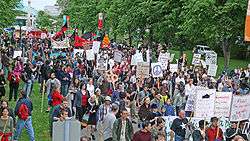
In a 47-nation June 2007 survey of global public opinion, the Pew Global Attitudes Project found international opposition to the war. Out of the 47 countries surveyed, 4 had a majority that favored keeping foreign troops: the U.S. (50%), Israel (59%), Ghana (50%), and Kenya (60%). In 41, pluralities wanted NATO troops out as soon as possible.[616] In 32 out of 47, clear majorities wanted war over as soon as possible. Majorities in 7 out of 12 NATO member countries said troops should be withdrawn as soon as possible.[616][629]
A 24-nation Pew Global Attitudes survey in June 2008 similarly found that majorities or pluralities in 21 of 24 countries want the U.S. and NATO to remove their troops from Afghanistan as soon as possible. Only in three out of the 24 countries – the U.S. (50%), Australia (60%), and Britain (48%) – did public opinion lean more toward keeping troops there until the situation has stabilized.[630][631]
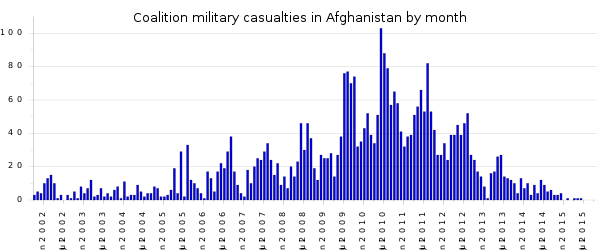
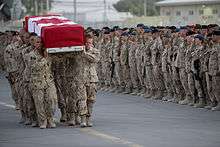
Following that June 2008 global survey, however, public opinion in Australia and Britain diverged from that in the U.S. A majority of Australians and Britons now want their troops home. A September 2008 poll found that 56% of Australians opposed continuation of their country's military involvement.[621][632][633] A November 2008 poll found that 68% of Britons wanted their troops withdrawn within the next 12 months.[620][634][635]
In the U.S., a September 2008 Pew survey found that 61% of Americans wanted U.S. troops to stay until the situation has stabilized, while 33% wanted them removed as soon as possible.[636] Public opinion was divided over Afghan troop requests: a majority of Americans continued to see a rationale for the use of military force in Afghanistan.[637] A slight plurality of Americans favored troop increases, with 42%–47% favoring some troop increases, 39%–44% wanting reduction, and 7–9% wanting no changes. Just 29% of Democrats favored troop increases while 57% wanted to begin reducing troops. Only 36% of Americans approved of Obama's handling of Afghanistan, including 19% of Republicans, 31% of independents, and 54% of Democrats.[638]
In a December 2009 Pew Research Center poll, only 32 percent of Americans favored increasing U.S. troops in Afghanistan, while 40 percent favored decreasing them. Almost half of Americans, 49 percent, believed that the U.S. should "mind its own business" internationally and let other countries get along the best they can. That figure was an increase from 30 percent who said that in December 2002.[639]
An April 2011 Pew Research Center poll showed little change in American views, with about 50% saying that the effort was going very well or fairly well and only 44% supporting NATO troop presence in Afghanistan.[640]
Protests, demonstrations and rallies
The war has been the subject of large protests around the world starting with the large-scale demonstrations in the days leading up to the invasion and every year since. Many protesters consider the bombing and invasion of Afghanistan to be unjustified aggression.[641][642] The deaths of Afghan civilians caused directly and indirectly by the U.S. and NATO bombing campaigns is a major underlying focus of the protests.[643] In January 2009, Brave New Foundation launched Rethink Afghanistan, a national campaign for non-violent solutions in Afghanistan built around a documentary film by director and political activist Robert Greenwald.[644] Dozens of organizations planned (and eventually held) a national march for peace in Washington, D.C. on 20 March 2010.[645][646]
Human rights abuses
Multiple accounts document human rights violations in Afghanistan.[647]
Taliban
The Afghanistan Independent Human Rights Commission (AIGRC) called the Taliban's terrorism against the Afghan civilian population a war crime.[68] According to Amnesty International, the Taliban commit war crimes by targeting civilians, including killing teachers, abducting aid workers and burning school buildings. Amnesty International said that up to 756 civilians were killed in 2006 by bombs, mostly on roads or carried by suicide attackers belonging to the Taliban.[648]
NATO has alleged that the Taliban have used civilians as human shields. As an example, NATO pointed to the victims of NATO air strikes in Farah province in May 2009, during which the Afghan government claims up to 150 civilians were killed. NATO stated it had evidence the Taliban forced civilians into buildings likely to be targeted by NATO aircraft involved in the battle. A spokesman for the ISAF commander said: "This was a deliberate plan by the Taliban to create a civilian casualty crisis. These were not human shields; these were human sacrifices. We have intelligence that points to this."[649] according to the U.S. State Department, the Taliban committed human rights violations against women in Afghanistan.[650]
White phosphorus use
White phosphorus has been condemned by human rights organizations as cruel and inhumane because it causes severe burns. White phosphorus burns on the bodies of civilians wounded in clashes near Bagram were confirmed. The U.S. claims at least 44 instances in which militants have used white phosphorus in weapons or attacks.[651] In May 2009, the U.S. confirmed that Western military forces in Afghanistan use white phosphorus to illuminate targets or as an incendiary to destroy bunkers and enemy equipment.[652][653] U.S. forces used white phosphorus to screen a retreat in the Battle of Ganjgal when regular smoke munitions were not available.[654]
Human Rights Abuses Against Afghan Refugees
Human rights abuses against Afghan refugees and asylum seekers have been documented. This includes mistreatment of refugees who lived in Iran, Pakistan, Netherlands, Canada, Australia, US, Europe, and other NATO members countries.
Afghan refugees in Iran, for example, were not allowed attend public schools,[655][656] "faced with restrictions on property ownership, freedom of movement, and access to government services...bullying, and physical abuse accompany many Afghan children throughout their adolescence...whether playing at recess or standing in line for bread at the naanvai, they hear jeers like 'Go back to your country,' and 'Dirty Afghan' daily",[657] denied participation in any form of elections, and legally restricted to take a handful of minimum paid jobs, and frequent target of scapegoating. For the price of citizenship for their family members, Afghan children as young as 14 were recruited to fight in Iraq and Syria for a six-month tour.[658]
Afghan refugees were regularly denied visa to travel between countries to visit their family members, faced long delays (usually a few years)[659] in processing of their visa applications to visit family members for purposes such as weddings, gravely ill family member, burial ceremonies, and university graduation ceremonies; potentially violating rights including free movement, right to family life and the right to an effective remedy.[660][661][662] Racism, low wage jobs including below minimum wage jobs, lower than inflation rate salary increases, were commonly practiced in Europe and the Americas. Many Afghan refugees were not permitted to visit their family members for a decade or two. Studies have shown abnormally high mental health issues and suicide rates among Afghan refugees and their children living in the west.[663][664][665][666][667][668]
Environmental legacy
Since 1979 landmines, shells, bombs, and other unexploded ordnance have been left behind.
In 2015 the NATO's International Security Assistance Force (ISAF) was replaced by the U.S.-led "Resolute Support" The director of the Mine Action Coordination Centre for Afghanistan (MACCA). ISAF stressed it had never used landmines.
See also
Footnotes
References
- ↑ Scott, Shane (22 June 2008). "Inside a 9/11 Mastermind's Interrogation". The New York Times.
- ↑ "Operation Enduring Freedom Fast Facts". CNN. Retrieved 11 July 2017.
- ↑ "The elite force who are ready to die". the Guardian. 27 October 2001.
- ↑ Neville, Leigh, Special Forces in the War on Terror (General Military), Osprey Publishing, 2015 ISBN 978-1472807908, p.48
- ↑ "Pakistan's 'fanatical' Uzbek militants". BBC. 11 June 2014.
- ↑ "Pakistan's militant Islamic groups". BBC. 13 January 2002.
- ↑ "Evaluating the Uighur Threat". the long war journal. 9 October 2008.
- ↑ Start of the Taliban insurgency after the fall of the Taliban regime.
- ↑ "Role of Pakistan in afghan war".
- ↑ "News – Resolute Support Mission". Retrieved 4 October 2015.
- ↑ "Forget Nato v the Taliban. The real Afghan fight is India v Pakistan". 26 June 2013. Retrieved 16 January 2017 – via The Guardian.
- ↑ "Taliban storm Kunduz city". The Long War Journal. Retrieved 30 September 2015.
- 1 2 The Taliban's new leadership is allied with al Qaeda, The Long War Journal, 31 July 2015
- ↑ "Central Asian groups split over leadership of global jihad". The Long War Journal. 24 August 2015. Retrieved 27 August 2015.
- ↑ Rod Nordland; Jawad Sukhanyar; Taimoor Shah (19 June 2017). "Afghan Government Quietly Aids Breakaway Taliban Faction". The New York Times. Retrieved 6 September 2017.
- 1 2 3 Matthew DuPée (January 2018). "Red on Red: Analyzing Afghanistan's Intra-Insurgency Violence". Combating Terrorism Center. Retrieved 18 February 2018.
- ↑ "Uzbek militants in Afghanistan pledge allegiance to ISIS in beheading video". khaama.com.
- ↑ "Who is Lashkar-e-Jhangvi?". Voanews.com. 2016-10-25. Retrieved 2017-06-02.
- ↑ "ISIS 'OUTSOURCES' TERROR ATTACKS TO THE PAKISTANI TALIBAN IN AFGHANISTAN: U.N. REPORT". Newsweek. August 15, 2017.
- 1 2 3 "'Afghan Taliban leader Mullah Omar is dead'". The Express Tribune. 29 July 2015. Retrieved 29 July 2015.
- 1 2 "Mullah Najibullah: Too Radical for the Taliban". Newsweek. 30 August 2013. Retrieved 22 August 2015.
- ↑ "The Afghan National Security Forces Beyond 2014: Will They Be Ready?" (PDF). Centre for Security Governance. February 2014.
- 1 2 "The continuing US war in Afghanistan". World Socialist Web Site. 30 December 2014. Retrieved 30 December 2014.
- 1 2 Akmal Dawi. "Despite Massive Taliban Death Toll No Drop in Insurgency". Voanews.com. Retrieved 10 August 2014.
- ↑ Rassler, Don; Vahid Brown (14 July 2011). "The Haqqani Nexus and the Evolution of al-Qaida" (PDF). Harmony Program. Combating Terrorism Center. Retrieved 2 August 2011.
- ↑ Reuters. "Sirajuddin Haqqani dares US to attack N Waziristan, by Reuters, Published: September 24, 2011". Tribune. Retrieved 10 April 2014.
- ↑ Perlez, Jane (14 December 2009). "Rebuffing U.S., Pakistan Balks at Crackdown". The New York Times.
- ↑ "Afghanistan after the Western Drawdown". Google books. 16 January 2015. Retrieved 13 August 2015.
- ↑ Bill Roggio (26 April 2011). "How many al Qaeda operatives are now left in Afghanistan? – Threat Matrix". Longwarjournal.org. Archived from the original on 6 July 2014. Retrieved 10 April 2014.
- ↑ "Al Qaeda in Afghanistan Is Attempting A Comeback". The Huffington Post. 21 October 2012. Archived from the original on 10 December 2013. Retrieved 10 April 2014.
- ↑ "In Afghanistan, al-Qaeda is working more closely with the Taliban, Pentagon says". the Washington post. 6 May 2016.
- ↑ "War-related Death, Injury, and Displacement in Afghanistan and Pakistan 2001–2014" (PDF). brown.edu. Retrieved 28 June 2017.
- ↑ New Year May Bring Renewed War to Afghanistan
Over 2,500 Afghan soldiers killed from Jan-May: US report
"'It's a Massacre': Blast in Kabul Deepens Toll of a Long War". New York Times. 2018-01-27. - ↑ "Scores Killed in Fresh Kunduz Fighting". Foxnews.com. November 26, 2001. Retrieved October 2, 2008.
- ↑ Morello, Carol; Loeb, Vernon (6 December 2001). "Friendly fire kills 3 GIs". Post-Gazette. Retrieved 2 October 2008.
- ↑ Terry McCarthy/Kunduz (18 November 2001). "A Volatile State of Siege After a Taliban Ambush". Time. Archived from the original on 30 May 2012. Retrieved 2 October 2008.
- ↑ John Pike (9 December 2001). "VOA News Report". Globalsecurity.org. Retrieved 9 February 2010.
- ↑ "US Bombs Wipe Out Farming Village". Rawa.org. Retrieved 9 February 2010.
- ↑ UK military deaths in Afghanistan
- ↑ OPERATION ENDURING FREEDOM (OEF) U.S. CASUALTY STATUS FATALITIES as of: December 30, 2014, 10 a.m. EDT Archived 6 July 2009 at the Wayback Machine.
- ↑ "Number of Afghanistan UK Military and Civilian casualties (7 October 2001 to 30 November 2014)" (PDF). www.gov.uk. Retrieved 28 June 2017.
- ↑ "Over 2,000 Canadians were wounded in Afghan mission: report". National Post. Retrieved 2012-02-01.
- 1 2 "U.S. Department of Labor – Office of Workers' Compensation Programs (OWCP) – Defense Base Act Case Summary by Nation". Dol.gov. Retrieved 2 August 2011.
- 1 2 T. Christian Miller (23 September 2009). "U.S. Government Private Contract Worker Deaths and Injuries". Projects.propublica.org. Retrieved 2 August 2011.
- ↑ Iraj. "Deadliest Year for the ANSF: Mohammadi". Retrieved 17 July 2015.
- ↑ 7,000 killed (2015), 18,500 killed (2016), total of 25,500 reported killed
- ↑ Crawford, Neta (August 2016). "Update on the Human Costs of War for Afghanistan and Pakistan, 2001 to mid-2016" (PDF). brown.edu. Retrieved 18 July 2017.
- ↑ "International Security Assistance Force (ISAF): Key Facts and Figures" (PDF).
- ↑ "Resolute Support Mission (RSM): Key Facts and Figures" (PDF).
- ↑
- "U.S. War in Afghanistan: 1999–Present". Council on Foreign Relations. 2014. Retrieved 21 February 2015.
- "U.S. War in Afghanistan". NBC News. 2015. Retrieved 21 February 2015.
- Lamothe, Dan (6 January 2015). "This new graphic shows the state of the U.S. war in Afghanistan". Washington post. Retrieved 21 February 2015.
- Matt Doeden; Blake Hoena (1 January 2014). War in Afghanistan: An Interactive Modern History Adventure. Capstone. p. 2. ISBN 978-1-4765-5221-7.
- Michael Cox; Doug Stokes (9 February 2012). US Foreign Policy. Oxford University Press. p. 140. ISBN 978-0-19-958581-6.
- Robert M. Cassidy () (2004). Peacekeeping in the Abyss: British and American Peacekeeping Doctrine and Practice After the Cold War. Greenwood Publishing Group. p. 243. ISBN 978-0-275-97696-5.
- ↑ David P. Auerswald; Stephen M. Saideman (5 January 2014). NATO in Afghanistan: Fighting Together, Fighting Alone. Princeton University Press. pp. 87–88. ISBN 978-1-4008-4867-6.
- ↑ Peter Dahl Thruelsen, From Soldier to Civilian: DISARMAMENT DEMOBILISATION REINTEGRATION IN AFGHANISTAN, DIIS REPORT 2006:7, 12, supported by Uppsala Conflict Database Project, Uppsala University.
- ↑ Maloney, S (2005). Enduring the Freedom: A Rogue Historian in Afghanistan. Washington, D.C: Potomac Books Inc.
- ↑ Darlene Superville and Steven R. Hurst. "Updated: Obama speech balances Afghanistan troop buildup with exit pledge". cleveland.com. Associated Press. and Arkedis, Jim (23 October 2009). "Why Al Qaeda Wants a Safe Haven". Foreign Policy. Archived from the original on 14 July 2014. Retrieved 13 June 2014.
- ↑ America's longest war comes to an end (sort of), msnbc.com.
- ↑ Obama Welcomes End Of The Longest War In American History, huffingtonpost.com.au
- ↑ The Longest War in American History Is Officially Over, slate.com.
- ↑ Editor's Notebook: Afghan War Now Country's Longest, abcnews.go.com.
- ↑ "Indictment #S(9) 98 Cr. 1023" Archived 24 March 2012 at the Wayback Machine. (PDF). United States District Court, Southern District of New York.
- ↑ "Bush rejects Taliban offer to hand Bin Laden over". The Guardian. Retrieved 24 January 2015.
- ↑ "Operation Enduring Freedom". www.history.navy.mil. Retrieved 13 September 2018.
- 1 2 Vulliamy, Ed; Wintour, Patrick; Traynor, Ian; Ahmed, Kamal (7 October 2001). "After the September Eleventh Terrorist attacks on America, "It's time for war, Bush and Blair tell Taliban – We're ready to go in – PM|Planes shot at over Kabul"". The Guardian. London. Retrieved 2 August 2011.
- 1 2 "Canada in Afghanistan: 2001". National Post. Retrieved 7 June 2013.
- 1 2 3 Felbab-Brown, V (2012). "Slip-Sliding on a Yellow Brick Road: Stabilization Efforts in Afghanistan". Stability: International Journal of Security and Development. 1 (1): 4–19. doi:10.5334/sta.af.
- 1 2 Rubin, Alyssa J. (22 December 2009). "NATO Chief Promises to Stand by Afghanistan". The New York Times. Retrieved 29 January 2014.
- 1 2 "The Taliban Resurgence in Afghanistan". Archived from the original on 27 September 2006.
- 1 2 Rothstein, Hy S (15 August 2006). Afghanistan: and the troubled future of unconventional warfare By Hy S. Rothstein. ISBN 978-81-7049-306-8.
- 1 2 "AIHRC Calls Civilian Deaths War Crime". Tolonews. 13 January 2011. Archived from the original on 24 June 2011.
- ↑ Starkey, Jerome (30 September 2010). "Karzai's Taliban talks raise spectre of civil war warns former spy chief". The Scotsman. Edinburgh.
- ↑ "Ten Stories the world should know more about, 2007". www.un.org. Retrieved 28 June 2017.
- ↑ Vira, Varun; Cordesman, Anthony (25 July 2011). "Pakistan: Violence versus Stability: A Net Assessment". Center for Strategic and International Studies.
- ↑ "International Security Assistance Force (ISAF): Key Facts and Figures" (PDF). nato.int. 4 March 2011. Retrieved 19 July 2017.
- ↑ "A timeline of US troops in Afghanistan since 2001". CNS News. 15 October 2015. Archived from the original on 12 October 2017. Retrieved 19 July 2017.
- ↑ KURTZLEBEN, DANIELLE (6 July 2016). "CHART: How The U.S. Troop Levels In Afghanistan Have Changed Under Obama". NPR. Retrieved 19 July 2017.
- ↑ Walsh, Declan; Nordland, Rod (10 September 2013). "Pakistan May Release Taliban Commander to Aid Afghan Peace Talks". The New York Times. Retrieved 29 January 2014.
- ↑ DeYoung, Karen (27 May 2014). "Obama to leave 9,800 U.S. troops in Afghanistan". The Washington Post. Retrieved 29 May 2014.
- ↑ Rogers, Simon; Chalabi, Mona (10 August 2010). "Afghanistan civilian casualties". London: The Guardian. Retrieved 29 January 2014.
- 1 2 "U.S. formally ends the war in Afghanistan" (online). CBA News. Associated Press. 28 December 2014. Retrieved 28 December 2014.
- ↑ Sune Engel Rasmussen in Kabul (28 December 2014). "Nato ends combat operations in Afghanistan". Kabul: The Guardian. The Guardian. Retrieved 11 January 2015.
- ↑ Walsh, Eric (9 February 2017). "Trump speaks with Afghan leader, U.S. commander calls for more troops". Reuters. Retrieved 11 April 2017.
- ↑ "Troop Contributing Nations" (PDF). Resolute Support Mission. May 2017.
- ↑ "TSG IntelBrief: Afghanistan 16.0". The Soufan Group. Retrieved 27 September 2018.
- 1 2 Crawford, Neta (August 2016). "Update on the Human Costs of War for Afghanistan and Pakistan, 2001 to mid-2016" (PDF). brown.edu. Retrieved 18 July 2017.
- ↑ "Casting Shadows: War Crimes and Crimes against Humanity: 1978–2001" (PDF). Afghanistan Justice Project. 2005. Archived from the original (PDF) on 4 October 2013.
- 1 2 "Afghanistan: Further Information on Fear for Safety and New Concern: Deliberate and Arbitrary Killings: Civilians in Kabul". Amnesty International. 16 November 1995. Retrieved 19 November 2012.
- ↑ "Afghanistan: escalation of indiscriminate shelling in Kabul". International Committee of the Red Cross. 1995.
- 1 2 3 Marcela Grad (1 March 2009). Massoud: An Intimate Portrait of the Legendary Afghan Leader. Webster University Press. p. 310.
- ↑ "II. BACKGROUND". Human Rights Watch. Archived from the original on 2 November 2008.
- 1 2 Amin Saikal. Modern Afghanistan: A History of Struggle and Survival (2006 1st ed.). I.B. Tauris & Co Ltd., London New York. p. 352. ISBN 1-85043-437-9.
- 1 2 "Documents Detail Years of Pakistani Support for Taliban, Extremists". National Security Archive. 2007. Retrieved 19 November 2012.
- ↑ Video on YouTube
- 1 2 3 Coll 2004, p. 14.
- ↑ "The Taliban's War on Women: A Health and Human Rights Crisis in Afghanistan" (PDF). Physicians for Human Rights. 1998.
- ↑ Maley, William (2009). The Afghanistan wars. Palgrave Macmillan. p. 288. ISBN 978-0-230-21313-5.
- 1 2 Peter Tomsen said that up until 9/11, Pakistani military and ISI officers, along with thousands of regular Pakistani armed forces personnel, had been involved in the fighting in Afghanistan.Tomsen, Peter (2011). Wars of Afghanistan. PublicAffairs. p. 322. ISBN 978-1-58648-763-8.
- ↑ Video on YouTube
- ↑ Tomsen, Peter (2011). Wars of Afghanistan. PublicAffairs. p. 565. ISBN 978-1-58648-763-8.
- ↑ Coll 2004, p. 558.
- ↑ "The lost lion of Kabul". The New Statesman. 2011.
- 1 2 Newsday (October 2001). "Taliban massacres outlined for UN". Chicago Tribune.
- 1 2 Newsday (2001). "Confidential UN report details mass killings of civilian villagers". newsday.org. Archived from the original on 18 November 2002. Retrieved 12 October 2001.
- ↑ Immigration and Refugee Board of Canada (February 1999). "Afghanistan: Situation in, or around, Aqcha (Jawzjan province) including predominant tribal/ethnic group and who is currently in control".
- ↑ "Incitement of Violence Against Hazaras by Governor Niazi". Afghanistan: the Massacre in Mazar-I Sharif. Human Rights Watch. November 1998. Archived from the original on 15 December 2007. Retrieved 27 December 2007.
- 1 2 3 Ahmed Rashid (11 September 2001). "Afghanistan resistance leader feared dead in blast". The Telegraph. London.
- ↑ Girardet 2011, p. 416.
- ↑ Rashid 2000, p. 91.
- ↑ "Pakistan's support of the taliban". Human Rights Watch. 2000.
- ↑ 911 Commission 2004, p. 66.
- ↑ 911 Commission 2004, p. 67.
- ↑ Coll 2004.
- ↑ "9/11 Represented a Dramatic Failure of Policy and People". U.S. Congressman Dana Rohrabacher. 2004.
- ↑ "Security Council demands that Taliban turn over Osama bin Laden to appropriate authorities" (Press release). United Nations. 15 October 1999.
- ↑ Risen 2008.
- ↑ Coll 2004, p. 720.
- ↑ Julian Borger (24 March 2004). "Bush team 'agreed plan to attack the Taliban the day before September 11'". The Guardian. London.
- ↑ Marcela Grad. Massoud: An Intimate Portrait of the Legendary Afghan Leader (1 March 2009 ed.). Webster University Press. p. 310.
- ↑ "Inside the Taliban 06 – N.G." YouTube. 11 November 2009. Retrieved 10 August 2014.
- ↑ "Inside the Taliban". National Geographic. 2007. Archived from the original on 5 July 2014.
- ↑ "Massoud in the European Parliament 2001". EU media. 2001.
- ↑ "Council of Afghan opposition". Corbis. 2001.
- ↑ Marcela Grad. Massoud: An Intimate Portrait of the Legendary Afghan Leader (1 March 2009 ed.). Webster University Press. p. 65.
- ↑ Senior diplomat and Afghanistan expert Peter Tomsen wrote: "The 'Lion of Kabul' [Abdul Haq] and the 'Lion of Panjshir' [Ahmad Shah Massoud] … Haq, Massoud, and Karzai, Afghanistan's three leading moderates, could transcend the Pashtun—non-Pashtun, north-south divide."Tomsen, Peter (2011). Wars of Afghanistan. PublicAffairs. p. 566. ISBN 978-1-58648-763-8.
- ↑ "Defense Intelligence Agency" (PDF). National Security Archive. 2001. Retrieved 19 November 2012.
- ↑ "Taliban Foe Hurt and Aide Killed by Bomb". The New York Times. Afghanistan. 10 September 2001. Retrieved 27 August 2010.
- ↑ Burns, John F. (9 September 2002). "Threats and Responses: Assassination; Afghans, Too, Mark a Day of Disaster: A Hero Was Lost". The New York Times. Afghanistan. Retrieved 27 August 2010.
- ↑ Holmes, Stephen (2006). "Al Qaeda, 11 September 2001". In Diego Gambetta. Making sense of suicide missions. Oxford University Press. ISBN 978-0-19-929797-9.
- ↑ Keppel, Gilles; Milelli, Jean-Pierre; Ghazaleh, Pascale (2008). Al Qaeda in its own words. Harvard University Press. ISBN 978-0-674-02804-3.
- ↑ "Chapter of the 9/11 Commission Report detailing the history of the Hamburg Cell". 9/11 Commission.
- 1 2 "9 Years Later, Nearly 900 9/11 Responders Have Died, Survivors Fight for Compensation". FOX News. 11 September 2010. Retrieved 12 September 2010.
- ↑ "Special forces and horses". 1 November 2006. Retrieved 8 February 2016.
- ↑ Zimmerman, Dwight Jon (16 September 2011). "21st Century Horse Soldiers – Special Operations Forces and Operation Enduring Freedom". Retrieved 11 September 2015.
- 1 2 "Units Credited With Assault Landings" (PDF). army.mil. Archived from the original (PDF) on 1 October 2006. Retrieved 28 June 2017.
- ↑ Moore, J. Daniel. "First In: An Insider's Account of How the CIA Spearheaded the War on Terror in Afghanistan". Retrieved 12 September 2015.
- ↑ "5th Special Forces Group "Task Force Dagger" Commemorative Challenge Coin Versions 1 – 5". The Commander's Challenge. 1 December 2015. Retrieved 8 February 2016.
- ↑ "Jawbreaker – CIA Special Activities Division". Retrieved 11 September 2015.
- ↑ "Task Force Dagger – Operation Enduring Freedom". Retrieved 13 January 2012. page 127ff
- ↑ Gresham, John (12 September 2011). "The Campaign Plan – Special Operations Forces and Operation Enduring Freedom". Retrieved 11 September 2015.
- ↑ Barzilai, Yaniv (30 January 2017). "How Al Qaeda Escaped Afghanistan and Lived to Fight Another Day". The Daily Beast. Retrieved 28 June 2017.
- ↑ ISAF in Afghanistan CDI, Terrorism Project – 14 February 2002. Archived 14 April 2012 at the Wayback Machine.
- 1 2 "ISAF Chronology". Nato.int. Retrieved 2 August 2011.
- ↑ "U.S. remains on trail of bin Laden, Taliban leader". CNN. 14 March 2002. Archived from the original on 17 January 2013. Retrieved 29 January 2014.
- ↑ Neville, Leigh, Special Forces in the War on Terror (General Military), Osprey Publishing, 2015 ISBN 978-1472807908, p.83
- ↑ "Leaflet War Rages in Afghan Countryside". Associated Press. 14 February 2003. Archived from the original on 28 September 2007. Retrieved 6 October 2017.
- ↑ "globalsecurity.org". Retrieved 27 September 2007.
- 1 2 Tohid, Owias & Baldauf, Scott (8 May 2003). "Taliban appears to be regrouped and well-funded". Christian Science Monitor. Retrieved 28 February 2007.
- ↑ Tohid, Owias (27 June 2003). "Taliban regroups – on the road". Christian Science Monitor. Retrieved 28 February 2007.
- ↑ Gall, Carlotta (13 November 2004). "Asia: Afghanistan: Taliban Leader Vows Return". The New York Times. Retrieved 6 October 2017.
- ↑ "afnorth.nato.int". Archived from the original on 13 September 2006. Retrieved 27 September 2007.
- ↑ "UK troops take over Afghan duties". BBC News. 1 May 2006. Retrieved 27 September 2007.
- ↑ "Canada set for longer Afghan stay". BBC News. 16 May 2006. Retrieved 27 September 2007.
- ↑ "Australia outlines Afghan force". BBC News. 8 May 2006. Retrieved 27 September 2007.
- ↑ "Denmark". centcom.mil. Retrieved 27 September 2007.
- ↑ "defensenews.com". Retrieved 27 September 2007.
- ↑ "Taleban vow to defeat UK troops". BBC News. 7 June 2006. Retrieved 27 September 2007.
- ↑ "npr: Truck Accident Sparks Riots in Afghanistan". 29 May 2006. Retrieved 12 September 2017.
- ↑ Constable, Pamela (1 June 2006). "U.S. troops fired at mob after Kabul accident". The Washington Post. Washington. p. 1. Retrieved 12 September 2017.
- ↑ "British Ministry of Defence". Archived from the original on 8 February 2007. Retrieved 27 September 2007.
- ↑ "British Ministry of Defence". Archived from the original on 26 September 2007. Retrieved 27 September 2007.
- ↑ "British Ministry of Defence". Archived from the original on 8 May 2007. Retrieved 27 September 2007.
- ↑ "British Ministry of Defence". Retrieved 27 September 2007.
- ↑ "Outgoing Commander Says U.S. Commitment Will Live On in Afghanistan". U.S. Department of Defense. Archived from the original on 14 July 2015. Retrieved 17 July 2015.
- ↑ "Pentagon inquiry finds U.S. Marine unit killed Afghan civilians".
- ↑ Gall, Carlotta (15 April 2007). "Marines' Actions in Afghanistan Called Excessive' Actions in Afghanistan Called Excessive". The New York Times.
- ↑ "Marine Unit Is Told To Leave Afghanistan". The Washington Post. 24 March 2007. Retrieved 9 April 2010.
- ↑ Baker, Peter (11 March 2007). "Additional Troop Increase Approved". The Washington Post. p. A11. Retrieved 31 May 2008.
- ↑ "171635Z PRT SHARANA DAILY REPORT". Wikileaks. Wikileaks. Archived from the original on 11 August 2010. Retrieved 21 June 2017.
- ↑ Baczynska, Gabriela. "Polish court acquits 7 soldiers over Afghan deaths". Reuters. Retrieved 21 June 2017.
- ↑ "Battle 'kills dozens of Taleban'". BBC News. 28 October 2007. Retrieved 2 October 2008.
- ↑ Rhode, David. "Held by the Taliban". The New York Times. Retrieved 21 June 2017.
- ↑ "Foreign Fighters of Harsher Bent Bolster Taliban". The New York Times. 30 October 2007. Retrieved 27 September 2018.
- ↑ "Afghan forces 'kill top militant'". BBC News. 2 November 2007. Retrieved 2 October 2008.
- ↑ "6 U.S. troops die in Afghan ambush". CNN. 10 November 2007. Retrieved 17 July 2012.
- ↑ ""Time is now right" for retaking Musa Qaleh – Browne". Defence News. British Ministry of Defence. 7 December 2007. Archived from the original on 11 December 2007. Retrieved 9 December 2007.
- ↑ Karen DeYoung; Jonathan Weisman (23 July 2008). "Obama Shifts the Foreign Policy Debate". The Washington Post. p. A08. Retrieved 29 July 2008.
- ↑ "U.S. Forces in Afghanistan" (PDF). Research Services Report for Congress. Retrieved 2 August 2011.
- ↑ The Guardian. 'Bush announces withdrawal of 8,000 troops from Iraq'. Retrieved 1 October 2008.
- ↑ "Extra UK troops for Afghanistan". BBC News. 16 June 2008. Retrieved 1 December 2011.
- ↑ "Brown in tribute to Afghan dead". BBC News. 9 June 2008. Retrieved 1 December 2011.
- ↑ "Insurgent attack frees hundreds from Kandahar prison". CBC News. 14 June 2008.
- ↑ "Afghan ambush kills French troops". BBC News. 19 August 2008. Retrieved 6 January 2010.
- ↑ Leithead, Alastair (2 September 2008). "UK troops in huge turbine mission". BBC News. Retrieved 6 January 2010.
- ↑ Pakistan reacts with fury after up to 20 die in 'American' attack on its soil The Guardian Retrieved on 12 September 2008
- ↑ "Pakistan fury over 'US assault'". BBC News. 4 September 2008. Retrieved 1 December 2011.
- ↑ Pakistan cuts supply lines to Nato forces Archived 12 September 2008 at the Wayback Machine. Retrieved on 12 September 2008
- ↑ "US deaths in Afghanistan makes 2008 deadliest year", Washington Times. Retrieved on 14 September 2008 Archived 6 June 2011 at the Wayback Machine.
- ↑ "OEF: Afghanistan: Fatalities By Year". icasualties.org. 9 September 2005. Retrieved 14 September 2013.
- ↑ "Militant attack burns NATO supply containers". CNN. 7 December 2008. Retrieved 2 August 2011.
- 1 2 Zein Basravi (12 December 2008). "Police: Militants destroy NATO trucks". CNN. Retrieved 2 August 2011.
- 1 2 "tax: allied supply convoys pay their enemies, The Times, 12 December 2008". Liveleak.com. 21 September 2013. Retrieved 10 April 2014.
- ↑ "Attacks expose weakness of key Afghanistan supply route, AFP". Google. 11 December 2008. Archived from the original on 5 February 2009. Retrieved 2 August 2011.
- ↑ Oppel, Richard A. (24 December 2008). "Amid Taliban Rule, a NATO Supply Line Is Choked, 24 December 2008". The New York Times. Khyber Pass; Pakistan; Peshawar (Pakistan); Pakistan; Afghanistan. Retrieved 2 August 2011.
- ↑ Salman Masood (3 February 2009). "Bridge Attack Halts NATO Supplies to Afghanistan". The New York Times. Retrieved 29 January 2014.
- ↑ "'Another US strike' hits Pakistan". BBC News. 12 September 2008. Retrieved 1 December 2011.
- ↑ "Pakistan: Shoot GIs on cross-border raids". MSNBC.com. 16 September 2008. Retrieved 2 October 2008.
- ↑ "Pakistan fires on Nato aircraft". BBC News. Retrieved 21 June 2017.
- ↑ "Pakistan fires on Nato aircraft". BBC News. 25 September 2008. Retrieved 1 December 2011.
- ↑ Turin, Dustin (23 March 2009). "Can the U.S. Win in Afghanistan?". Student Pulse. Retrieved 22 November 2009.
- ↑ Nic Robertson. "Sources: Taliban split with al Qaeda, seek peace". CNN. Retrieved 9 February 2010.
- ↑ Partlow, Joshua (11 November 2009). "In Afghanistan, Taliban surpasses al-Qaeda". Washington Post. Retrieved 20 September 2018.
- ↑ "Pakistani military outpacing coalition?". United Press International. 18 February 2010. Retrieved 6 April 2010.
- ↑ Oppel, Richard A. (20 January 2009). "U.S. secures new supply routes to Afghanistan". The New York Times. Afghanistan;Khyber Pass;Russia. Retrieved 2 August 2011.
- 1 2 Daly, John CK (27 May 2009). "Second-Chance Logistics". ISN Security Watch.
- 1 2 "To Afghanistan, on the slow train". CNN. 29 November 2011. Archived from the original on 5 December 2011. Retrieved 5 December 2011.
- ↑ "Northern Distribution Network Delivers". EurasiaNet. 18 March 2009.
- ↑ Tynan, Deirdre (11 May 2009). "Karimov Gives Washington the Air Base it Needs for Afghan Operations". EurasiaNet.
- ↑ Baker, Peter (3 July 2009). "Russia Opens Route for U.S. to Fly Arms to Afghanistan". The New York Times.
- ↑ "Afghanistan's northern neighbours: Road blocks". The Economist. 5 March 2009.
- ↑ "US Ambassador Norland Promises to Increase Cooperation with Tashkent". EurasiaNet. 4 June 2009.
- ↑ "Ambassador Explores Commercial Developments in Navoi". U.S. Embassy in Uzbekistan. 13 May 2009. Archived from the original on 27 May 2010.
- ↑ Jason Straziulo (16 February 2009). "Newest US troops in Afghanistan seeing combat in dangerous region south of Kabul". Chicago Tribune. Associated Press. Archived from the original on 21 February 2009. Retrieved 29 January 2014.
- ↑ "Obama OKs 17,000 more US troops for Afghanistan". International Herald Tribune. 29 March 2009. Archived from the original on 5 June 2009. Retrieved 2 August 2011.
- ↑ Page, Susan (16 February 2009). "Obama OKs adding Afghanistan forces". USA Today. Retrieved 27 May 2010.
- ↑ "Tom Andrews: Classified McChrystal Report: 500,000 Troops Will Be Required Over Five Years in Afghanistan". Huffington Post. 24 September 2009. Retrieved 9 February 2010.
- ↑ Jaffe, Greg; Wilson, Scott; DeYoung, Karen (15 January 2007). "U.S. envoy resists troop increase, cites Karzai as problem". The Washington Post. Retrieved 9 February 2010.
- ↑ "IPS Inter Press Service". Ipsnews.net. Archived from the original on 11 June 2011. Retrieved 9 February 2010.
- ↑ "Right after interviewing Karzai". CNN. 5 February 2010. Retrieved 9 February 2010.
- ↑ Baker, Peter (5 December 2009). "How Obama Came to Plan for 'Surge' in Afghanistan". New York Times. Retrieved 16 March 2015.
- ↑ "Anti-war Leaders Blast Escalation of Afghanistan War". Fight Back! News. 1 December 2009.
- ↑ "Obama's Afghanistan decision evokes LBJ's 1965 order on Vietnam buildup"
- ↑ Matthias Gebauer (6 August 2010). "Germany to Pay $500,000 for Civilian Bombing Victims". Der Spiegel. Retrieved 9 August 2010.
- ↑ Chandrasekaran, Rajiv. "A Fight for Ordinary Peace" The Washington Post 12 July 2009
- 1 2 3 Chandrasekaran, Rajiv (2 July 2009). "Marines Deploy on Major Mission". The Washington Post. Retrieved 2 July 2009.
- ↑ Gaskell, Stephanie. "U.S. Marines launch Operation Khanjar – largest military offensive since 2004 battle of Fallujah" New York Daily News 2 July 2009
- ↑ "UK forces in major Afghan assault". BBC News. 23 June 2009.
- ↑ "3 SCOTS launch massive air assault". UK Ministry of Defence.
- ↑ "Slide 1" (PDF). Archived from the original (PDF) on 4 July 2010. Retrieved 9 February 2010.
- ↑ Peter Bergen (25 January 2010). "U.S. intelligence briefing: Taliban increasingly effective". CNN. Retrieved 9 February 2010.
- ↑ O'Hanlon, Michael E."Staying Power: The U.S. Mission in Afghanistan Beyond 2011 Archived 6 November 2010 at the Wayback Machine.", The Brookings Institution, September/October 2010.
- ↑ "Taliban warn of summer offensive" Reuters. 27 July 2007
- ↑ Salahuddin, Sayed and Tait, Paul."Afghan leader sees peaceful poll, troops ambushed" Reuters. 11 August 2009
- ↑ Dreazen, Yochi J. and Spiegel, Peter."Taliban Now Winning" The Wall Street Journal, 10 August 2009
- ↑ "Kabul urges polls attacks blackout" Al-Jazeera. 10 August 2009
- ↑ Entous, Adam and Shalizi, Hamid. "Afghan election fair, but not free: EU" Reuters. 22 August 2009
- ↑ "Voters targeted after Afghan polls". Al Jazeera. 24 August 2009. Retrieved 17 July 2012.
- ↑ Sheerin, Jude (20 August 2009). "As it happened: Afghan election 2009". BBC News. Retrieved 1 December 2011.
- ↑ "'Fraud proof' found in Afghan polls" Al-Jazeera. 11 September 2009
- ↑ "U.S. praises Pakistani military efforts". United Press International. 18 November 2009. Retrieved 6 April 2010.
- ↑ "Karzai holds peace talks with insurgents". TVNZ. Reuters. 22 March 2010. Archived from the original on 26 April 2010. Retrieved 6 April 2010.
- ↑ Simon Tisdall (26 July 2010). "Afghan war logs: How the US is losing the battle for hearts and minds". The Guardian. London. Retrieved 28 July 2010.
- ↑ "U.S. Security Advisor, Pakistani president discuss fight against militancy". People's Daily Online. Xinhua. 12 February 2010. Retrieved 6 April 2010.
- ↑ Gall, Carlotta (1 April 2011). "Losses in Pakistani Haven Strain Afghan Taliban". The New York Times. p. 1. Retrieved 29 January 2014.
- ↑ Perry, Tom, "U.S. Troops in Afghanistan Suffer More Critical Injuries", Los Angeles Times, 7 April 2011, p. 4.
- ↑ Vanden Brook, Tom (7 March 2011). "U.S.: Raids have taken out 900 Taliban leaders". USA Today. Retrieved 15 October 2012.
- ↑ Vanden Brook, Tom, "U.S.: Raids Have Taken Out 900 Taliban Leaders", USA Today, 8 March 2011, p. 6.
- ↑ Nordland, Rod (24 January 2011). "An Uncharacteristically Upbeat General in Afghanistan". The New York Times. Retrieved 3 February 2011.
- ↑ "Afghan troop numbers to eclipse Iraq soon". United Press International. 25 March 2010. Retrieved 6 April 2010.
- ↑ Miller, Greg (20 September 2009). "CIA expanding presence in Afghanistan". Los Angeles Times. Retrieved 9 February 2010.
- ↑ Tony Capaccio (31 January 2011). "U.S. Said to Reduce Civilian Deaths After Increasing CIA Pakistan Strikes". Bloomberg. Retrieved 31 January 2011.
- 1 2 Eric Schmitt (26 December 2010). "Taliban Fighters Appear Blunted in Afghanistan". The New York Times. Washington. Retrieved 31 January 2011.
- ↑ Adam Levine (15 October 2010). "What the numbers say about progress in Afghanistan". The Guardian. Washington. Retrieved 31 January 2011.
- ↑ Rod Nordland (24 January 2011). "An Uncharacteristically Upbeat General in Afghanistan". The New York Times. Kabul. Retrieved 31 January 2011.
- ↑ Whitlock, Craig (22 September 2010). "Book tells of secret CIA teams staging raids into Pakistan". The Seattle Times. Archived from the original on 22 February 2011.
- 1 2 Whitlock, Craig; Miller, Greg (23 September 2010). "Paramilitary force is key for CIA". The Washington Post.
- ↑ Woodward 2010, p. 8.
- ↑ Woodward 2010, p. 367.
- ↑ Woodward 2010, p. 160.
- ↑ "Nato hails Afghanistan operation". 14 February 2010. Retrieved 30 May 2018.
- ↑ Schmitt, Eric (25 July 2010). "The War Logs – Interactive Feature". The New York Times. Retrieved 28 July 2010.
- ↑ Declan Walsh (4 March 2007). "Afghanistan war logs: How US marines sanitised record of bloodbath". The Guardian. London. Retrieved 28 July 2010.
- ↑ Gebauer, Matthias; Goetz, John; Hoyng, Hans; Koelbl, Susanne; Rosenbach, Marcel; Schmitz, Gregor Peter (25 July 2010). "Explosive Leaks Provide Image of War from Those Fighting It: The Secret Enemy in Pakistan". Der Spiegel. Archived from the original on 10 May 2013. Retrieved 26 July 2010.
- ↑ Perlez, Jane; Cooper, Helene (30 September 2010). "Signaling Tensions, Pakistan Shuts NATO Route". The New York Times.
- ↑ "Taliban ramp up attacks against NATO". Archived from the original on 13 October 2010. Retrieved 7 October 2010.
- ↑ Rubin, Alissa J. (1 May 2011). "Taliban Say Offensive Will Begin Sunday". The New York Times. Retrieved 29 January 2014.
- ↑ "Taliban Attack Afghan Government Offices in South". The New York Times. Associated Press. 7 May 2011. Retrieved 7 May 2011.
- ↑ "Afghanistan: Taliban's Kandahar raid into second day". BBC. BBC. 8 May 2011. Retrieved 8 May 2011.
- ↑ "Al-Qaeda leader Osama Bin Laden dead – Obama". BBC News. 2 May 2011. Retrieved 2 May 2011.
- ↑ Landler, Mark; Cooper, Helene (22 June 2011). "Obama Will Speed Pullout From War in Afghanistan". The New York Times.
- ↑ Nick Hopkins (21 June 2011). "Afghanistan withdrawal: UK to 'make up' its own mind". The Guardian. London. Retrieved 2 August 2011.
- ↑
- Willsher, Kim (24 June 2011). "French troops Afghanistan: France to gradually withdraw troops from Afghanistan". Los Angeles Times. Retrieved 2 August 2011.
- "French troops Afghanistan: Nicolas Sarkozy announces France to withdraw 1,000 troops from Afghanistan by end of 2012". The Telegraph. London. 12 July 2011. Retrieved 17 September 2011.
- "Afghanistan: Sarkozy confirme le retrait de 1 000 soldats français d'ici à fin 2012 (french)/ Sarkozy confirms that 1.000 soldiers will be withdrawn by the end of 2012". Le Monde. 12 July 2011. Retrieved 17 September 2011.
- ↑ "Belgium to halve troops in Afghanistan". Sydney Morning Herald. 26 June 2011. Retrieved 2 August 2011.
- ↑ NTB (25 June 2011). "Norge trapper ned i Afghanistan". DN.no. Archived from the original on 29 June 2011. Retrieved 2 August 2011.
- ↑ "Spain withdraw its troops from Afghanistan in 2015". Ytwhw.com. 27 June 2011. Archived from the original on 24 April 2012. Retrieved 2 August 2011.
- ↑ "Nato attack can have grave consequences: DG ISPR". The News International. 29 November 2011. Archived from the original on 29 November 2011.
- ↑
- Robert Burns (26 February 2013). "APNEWSBREAK: Taliban Attacks Not Down After All". Associated Press. Retrieved 4 March 2013.
- "Nato admits 'error' in claim of fall in Taliban attacks". BBC News. 26 February 2013. Retrieved 4 March 2013.
- Jennifer Griffin; Justin Fishel (26 February 2013). "US military acknowledges reported drop in Taliban attacks was incorrect". Fox News. Associated Press. Retrieved 4 March 2013.
- Phil Stewart (26 February 2013). "Afghan insurgent attacks misreported, did not fall in 2012: NATO". Reuters. Retrieved 4 March 2013.
- Ackerman, Spencer (26 February 2013). "'Data-Entry Error' Led Military to Falsely Claim Taliban Attacks Are Down". Wired. Retrieved 4 March 2013.
- ↑ Chandrasekaren, Rajiv (25 September 2015). "The Afghan Surge is Over". Foreign Policy. Retrieved 16 March 2015.
- ↑ "There is more to peace than Taliban". Asia Times. 12 January 2012.
- ↑ "Afghan opposition says new parliament can check Karzai". Reuters. 24 November 2010.
- ↑ "2010 Afghan Parliamentary Election: Checks and Balances of Power". Khaama Press. 9 December 2010.
- ↑ "Govt Opposition Warn of Taking to Streets". Tolo TV. 5 May 2011.
- ↑ Rubin, Alissa J. (5 May 2011). "Thousands of Afghans Rally in Kabul". The New York Times.
- ↑ "Anti-Taliban rally". BBC Persian. 5 May 2011.
- ↑ "Afghan Northern Alliance Allies Betrayed by Obama Administration; Meet with U.S. Congressmen in Berlin". Representative Louis Gohmert. 9 January 2012.
- ↑ "Rep. Rohrabacher Leads Bipartisan Delegation's Afghanistan Strategy Session With National Front Leaders in Berlin". Representative Dana Rohrabacher. 9 January 2012. Archived from the original on 19 May 2012.
- 1 2 Wright, Jessica (19 April 2012). "Leaders condemn US troops in body-parts photos". The Sydney Morning Herald. Retrieved 6 May 2012.
- 1 2 "Photos of Soldiers Posing With Body Parts Add Strain to a Taxed Relationship". The New York Times. 18 April 2012. Retrieved 29 January 2014.
- 1 2 Gordts, Eline (18 April 2012). "U.S. Soldiers Pose With Bodies of Suicide Bombers in Afghanistan". The Huffington Post. Reuters. Retrieved 7 May 2012.
- ↑ "Obama calls for Afghan body abuse punishment". BBC. 18 April 2012. Retrieved 6 May 2012.
- 1 2 "Photos just latest issue hounding U.S. military in Afghanistan". CNN. 18 April 2012. Retrieved 6 May 2012.
- ↑ Fantz, Ashley (19 April 2012). "How will leaked photos impact U.S. mission in Afghanistan?". CNN. Retrieved 6 May 2012.
- ↑ Sommerville, Quentin (19 April 2012). "Dismantling US bases as the Taliban fight on". BBC. Retrieved 6 May 2012.
- ↑ Thom Shanker; Graham Bowley (18 April 2012). "Images of G.I.'s and Remains Fuel Fears of Ebbing Discipline". The New York Times. Retrieved 6 May 2012.
- 1 2 Emma Graham-Harrison (6 July 2012). "'Bye-bye, Miss American Pie' – then US helicopter appears to fire on Afghans". The Guardian. London. Retrieved 10 September 2012.
- ↑ Bates, Daniel (5 July 2012). "The moment a U.S. helicopter strike blasts an Afghan man to pieces... as the pilot sings 'Bye, bye Miss American Pie'". The Daily Mail. London. Retrieved 10 September 2012.
- ↑ Anissa Haddadi (6 July 2012). "US Helicopter Pilot Sings 'American Pie' as Missile Blows up 'Innocent Afghan Farmer' [VIDEO]". International Business Times. Retrieved 10 September 2012.
- ↑ Landler, Mark (1 May 2012). "Obama Signs Pact in Kabul, Turning Page in Afghan War". The New York Times. Retrieved 4 May 2012.
- ↑ "Enduring Strategic Partnership Agreement between the Islamic Republic of Afghanistan and the United States of America". Scribd. Retrieved 4 May 2012.
- ↑ Sweet, Lynn (1 May 2012). "U.S.-Afgan strategic agreement: Roadmap to Chicago NATO Summit. Briefing transcript". Chicago Sun-Times. Archived from the original on 7 May 2012. Retrieved 4 May 2012.
- ↑ Clinton, Hillary (8 July 2012). "Press Releases: Intervention at the Tokyo Conference on Afghanistan" (Press release). NewsRoomAmerica.com. Retrieved 8 July 2012.
- ↑ CNN Wire Staff (7 July 2012). "U.S. designates Afghanistan a major ally, creates defense ties". CNN. Retrieved 8 July 2012.
- ↑ "Afghanistan, US launch negotiations on Bilateral Security Agreement (BSA)". DiploNews. 15 November 2012. Archived from the original on 4 December 2012. Retrieved 19 November 2012.
- 1 2 "NATO sets "irreversible" but risky course to end Afghan war". Reuters. Reuters. 21 May 2012. Retrieved 22 May 2012.
- 1 2 NATO (21 May 2012). "Chicago NATO Summit 2012 Declaration". Defence Talk – Global Defense, Aerospace & Military Portal. Retrieved 20 June 2012.
- ↑ Scott Wilson & Karen DeYoung (21 May 2012). "NATO leaders agree on framework to wind down Afghan mission". The Washington Post. Retrieved 22 May 2012.
- ↑ Elise Labott & Mike Mount (22 May 2012). "NATO accepts Obama timetable to end war in Afghanistan by 2014". CNN. Retrieved 22 May 2012.
- ↑ Mark Landler & Michael R. Gordon (8 January 2012). "U.S. Is Open to Withdraw Afghan Force After 2014". The New York Times. Retrieved 12 January 2013.
- ↑ "The Afghan War's Last Chapter?". The New York Times. 12 January 2013. Retrieved 12 January 2013.
- 1 2 3 4 "Obama, Karzai agree to accelerate military transition". CNN. 12 January 2013. Retrieved 12 January 2013.
- 1 2 Scott Wilson & David Nakamur (11 January 2013). "Obama announces reduced U.S. role in Afghanistan starting this spring". The Washington Post. Retrieved 12 January 2013.
- 1 2 Christi Parsons & Kathleen Hennessey (11 January 2013). "Obama moves up deadline for Afghans to take lead security role". The Los Angeles Times. Retrieved 12 January 2013.
- ↑ "US to speed up Afghan troop transition". Al Jazeera English. 11 January 2012. Retrieved 12 January 2013.
- 1 2 3 "US troops will end 'most' Afghanistan combat this spring". BBC News US & Canada. 11 January 2012. Retrieved 12 January 2013.
- ↑ Mark Landler & Michael R. Gordon (11 January 2013). "Obama Accelerates Transition of Security to Afghans". The New York Times. Retrieved 12 January 2013.
- 1 2 "Bomb blast hits Afghanistan on security handover day". Deutsche Welle. 19 June 2013. Retrieved 23 June 2013.
- 1 2 "Deadly blast marks Afghan security handover". Al Jazeera English. Al Jazeera English. 18 June 2013. Retrieved 23 June 2013.
- ↑ "Karzai announces Afghan security handover". Global Post. Agence France-Presse. 18 June 2013. Retrieved 23 June 2013.
- 1 2 Hodge, Nathan (18 June 2013). "Blast Mars Day of Security Handover in Kabul". The Wall Street Journal. Retrieved 23 June 2013.
- ↑ LaPorta, James (28 November 2015). "Afghan interpreter hoping for asylum gets little help from those he worked for". Jacksonville Daily News. Retrieved 24 November 2016.
- ↑ "Punish Russia? Why some Pentagon officials would prefer restraint.," The Christian Science Monitor, 4 March 2014.
- ↑ "Jet bombing kills seven including five US troops in Afghanistan". Washington Post. Retrieved 12 June 2014.
- ↑ Shapira, Ian (14 August 2014). "Mourners gather at Arlington Cemetery for burial of general killed in Afghanistan". Washington Post. Retrieved 6 September 2014.
- 1 2 "American army officer killed, many wounded in Afghan insider attack". Afghanistan Sun. Retrieved 7 August 2014.
- ↑
- Declan Walsh and Azam Ahmed (30 September 2014). "Mending Alliance, U.S. and Afghanistan Sign Long-Term Security Agreement". The New York Times. Retrieved 26 October 2014.
- Sudarsan Raghavan and Karen DeYoung (30 September 2014). "U.S. and Afghanistan sign vital, long-delayed security pact". The Washington Post. Retrieved 26 October 2014.
- ↑
- Syal, Ryan (26 October 2014). "UK troops hand over Camp Bastion to Afghan forces, ending 13-year campaign". The Guardian. Retrieved 26 October 2014.
- Kay Johnson, Raissa Kasolowsky, Michael Perry and Kevin Liffey. "Britain ends combat role in Afghanistan, last US Marines hand over base". Reuters. Retrieved 26 October 2014.
- Loyn, David (26 October 2014). "What have British troops achieved in Afghanistan?". BBC News Asia. Retrieved 26 October 2014.
- ↑ Gordon, Michael R. (26 November 2012). "Time Slipping, U.S. Ponders Afghan Role After 2014". The New York Times. Retrieved 26 November 2012.
- ↑ DeYoung, Karen (5 December 2012). "U.S. reducing plans for large civilian force in post-2014 Afghanistan". The Washington Post. Retrieved 5 December 2012.
- ↑ Landler, Mark (27 May 2014). "U.S. Will Complete Afghan Pullout by End of 2016, Obama Says". The New York Times.
- ↑ Zenjo, Micah (29 May 2015). "The New Unknown Soldiers of Afghanistan and Iraq". Foreign Policy. Retrieved 5 June 2015.
- ↑
- "Resolute Support". Afghan War News. Afghan War News. Retrieved 7 February 2015.
- Lamothe, Dan (29 December 2014). "Meet Operation Freedom's Sentinel, the Pentagon's new mission in Afghanistan". Washington Post. Retrieved 2 January 2015.
- ↑
- "Afghanistan marks takeover of security responsibility from NATO". Deutsche Welle. 1 January 2015. Retrieved 4 January 2015.
- "18 Suspected insurgents slain in NATO airstrike in Afghanistan". Fox News Latino. Reuters. 3 January 2015. Archived from the original on 5 January 2015. Retrieved 4 January 2014.
- "Afghans Take Over Country's Security". Voice of America. 1 January 2015. Retrieved 6 January 2015.
- ↑ Gabriel Domínguez (6 January 2015). "What can NATO's new Afghanistan mission achieve?". Deutsche Welle. Retrieved 6 January 2015.
- ↑ USSOCOM Fact Book 2015, page 42, published 14 November 2014 on the DVIDS portal. http://www.dvidshub.net/publication/issues/23684, via Afghan War News.
- ↑ Estelle Shirbon (13 March 2015). "Led by the Queen, Britain commemorates end of Afghan war". Reuters UK Edition. Retrieved 14 March 2015.
- ↑ Mason, Rowena (27 October 2015). "UK to keep 450 troops stationed in Afghanistan through 2016". The Guardian. Retrieved 2 July 2017.
- ↑ Mason, Rowena (8 July 2016). "UK to increase troops in Afghanistan from 450 to 500". The Guardian. Retrieved 2 July 2017.
- ↑ "Why are the Taliban resurgent in Afghanistan?". BBC. 5 January 2016.
- ↑ "Russia closes NATO supply corridor to Afghanistan". The Washington Times. 19 May 2015.
- ↑ "Suicide Bomber Hits European Police in Kabul; 1 Dead". 5 January 2015. Retrieved 5 January 2015.
- ↑ "Five men arrested in Afghanistan over involvement in Pakistan school massacre". 15 January 2015. Retrieved 16 January 2015.
- 1 2 "Officials confirm ISIL present in Afghanistan". Al Jazeera. Retrieved 6 February 2015.
- ↑ "ISIS active in south Afghanistan, officials confirm for first time". CBS News. 12 January 2015. Retrieved 6 February 2015.
- ↑ "Capture the Flag in Afghanistan". Foreign Policy. Retrieved 6 February 2015.
- ↑ Rosenberg, Matthew; Schmitt, Eric; Mazzetti, Mark (12 February 2015). "U.S. Is Escalating a Secretive War in Afghanistan". New York Times. Retrieved 21 February 2015.
- ↑ Craig, Tim (12 February 2015). "U.S. forces, Afghan troops arrest Taliban militants wanted for school massacre". Washington Post. Retrieved 21 February 2015.
- ↑ Stewart, Phil (20 February 2015). "New Defense Secretary Ash Carter goes to Afghanistan to ensure 'lasting success' as US troops withdraw". Business Insider. Reuters. Retrieved 21 February 2015.
- ↑ Rampton, Roberta (11 February 2015). "Obama administration weighs Afghan request to slow withdrawal of U.S. troops". Reuters. Retrieved 21 February 2015.
Ryan, Missy (10 February 2015). "White House weighs adjusting Afghan exit plan to slow withdrawal of troops". Washington Post. Retrieved 21 February 2015.
Eberspacher, Sarah (21 February 2015). "New Defense Secretary Carter says U.S. may slow Afghan troop withdrawal". The Week. Retrieved 21 February 2015.
Gul, Ayaz (21 February 2015). "New Pentagon Chief in Kabul Talks With Afghan President". Voice of America. Retrieved 21 February 2015.
"U.S. commander proposes slower Afghan withdrawal". The Japan Times. Agence France-Presse. 13 February 2015. Retrieved 21 February 2015. - ↑ Adam Ashton (24 February 2015). "Army to send headquarters group to Kandahar in first sign of revision to Afghan withdrawal plan". McClatchy. Retrieved 26 February 2015.
- ↑ Gary Walts (26 February 2015). "Fort Drum brigade prepares for deployment to Afghanistan". The Post-Standard. Syracuse Media Group. Associated Press. Retrieved 26 February 2015.
Tan, Michelle (27 February 2015). "Army announces new Afghanistan deployments". ArmyTimes. Gannett. Retrieved 28 February 2015. - ↑ "Afghan Army Kills Commander of ISIL Affiliate". Al-Masdar News.
- ↑ "29 Insurgents Killed In Military Operations". Tolonews. 25 March 2015. Archived from the original on 26 March 2015. Retrieved 28 March 2015.
- ↑ "Afghanistan: Taliban suicide bomb attack near Kabul airport". BBC News. 10 August 2015. Retrieved 11 August 2015.
- ↑ "Norske spesialsoldater i Afghanistan: – De vi slåss mot kjemper til døden".
- ↑ "News brief". The Week. 18 March 2016. p. 18.
- ↑ Masoud Popalzai and Jethro Mullen (22 June 2015). "Taliban attempt attack on Afghan Parliament in Kabul". CNN. Retrieved 22 June 2015.
- ↑ "Taliban launch brazen attack on Afghan parliament, seize second district in north". Reuters. Retrieved 22 June 2015.
- ↑ "Afghanistan explosion: Taliban suicide bomber, gunmen attack parliament building in Kabul killing two, wounding at least 30". ABC News. 23 June 2015.
- ↑ RAHIM, FAIEZ; AMIR, SHAH. "Taliban suicide bomber, gunmen attack Afghan parliament". The Big Story. Archived from the original on 22 June 2015. Retrieved 22 June 2015.
- ↑ Matthew Weaver. "Afghanistan parliament attacked by Taliban suicide bomber and gunmen – rolling updates". The Guardian. Retrieved 22 June 2015.
- ↑ "Afghan forces struggle to drive back Taliban from besieged city". Reuters. 30 April 2015.
- ↑ "Heavy fighting as Taliban attack northern Afghan city". Reuters. 27 April 2015.
- ↑ "Flights to besieged Afghan city cancelled as Taliban, army clash". Reuters. 7 May 2015.
- ↑ "INSIGHT – Stretched Afghan army falls back on militias to help defend Kunduz". Reuters. 22 May 2015.
- ↑ "Afghans counter Taliban offensive in northern Kunduz province". BBC News.
- ↑ "Taliban and Afghan Government Dispute Status of Kunduz". New York Times. 21 June 2015.
- ↑ "Afghanistan: Taliban advance on key northern city". The Sydney Morning Herald.
- ↑ "Afghan forces recapture key district from Taliban". Reuters. 23 June 2015.
- 1 2 Sune Engel Rasmussen (28 September 2015). "Taliban attempt to capture key Afghan city". The Guardian. Retrieved 28 September 2015.
- ↑ "Afghan Taliban seize Kunduz city center in landmark gain". Reuters. Retrieved 29 September 2015.
- ↑ "Taliban fighters raid Kunduz in Afghanistan". Al Jazeera. Retrieved 29 September 2015.
- ↑ "Taliban seizes control of major Afghan city Kunduz for first time since US-led invasion". ABC News. Retrieved 29 September 2015.
- 1 2 "Top official says Chinese security depends on Afghan stability". Reuters.
- ↑ "Untangling the web of India, China and Pakistan diplomacy". Reuters.
- ↑ "Taliban, Afghan figures talk ceasefire but fail to agree". Reuters.
"Exclusive: Secret meetings in Pakistan expose obstacles to Afghan peace talks". Reuters.
"Exclusive: China seeks greater role in Afghanistan with peace talk push". Reuters.
"China offers to mediate in stalled Afghan Taliban peace talks". Reuters. - 1 2 "Dozens killed in clashes between rival Taliban factions in Afghanistan". The Guardian. 10 March 2016.
- ↑ "Officials to begin talks aimed at reviving Afghan peace process". The Guardian. 10 January 2016. Archived from the original on 31 March 2016.
"Taliban reject invite to Afghanistan peace talks". CNN. 5 March 2016.
"Official Says ISIL Contained, Taliban Fracturing in Afghanistan". Department of Defence. 10 March 2016.
"NATO chief predicts another tough year ahead for Afghanistan". Military Times. 16 March 2016. - 1 2 "Afghanistan: Taliban won't talk because it is winning". Al Jazeera. 22 March 2016.
- ↑ "Attack on Afghanistan's parliament – When even failure is success". The Economist. 24 June 2015.
- ↑ "Afghan Peace Talks Expose Rifts in Taliban Leadership". VOA News. 24 June 2015.
- ↑ "No more peace talks with Taliban, Afghanistan's president says". Los Angeles Times. 25 April 2016.
- 1 2 "Haqqanis Steering Deadlier Taliban in Afghanistan, Officials Say". New York Times. 7 May 2016.
- 1 2 "Afghanistan Faces Tough Battle as Haqqanis Unify the Taliban". ABC news. 7 May 2016. Archived from the original on 8 May 2016.
- ↑ "Taliban leader says foreigners must quit Afghanistan for peace". Reuters. 2 July 2016. Retrieved 6 July 2016.
- ↑ "Taliban-on-Taliban turf war erupts in Afghanistan". worldbulletin News. Retrieved 15 November 2015.
- 1 2 3 "Number of ISIL Fighters in Afghanistan Drops Significantly, Official Says". US Department of Defense. 14 April 2016.
- ↑ "Taliban Attack Police Base in Afghanistan, Killing 17". The Telegraph. 13 June 2015.
- ↑ "Taliban seize district in Helmand province". The Long War Journal. 30 July 2015.
- ↑ "Two Setbacks for Coalition in Afghanistan". The New York Times. 26 August 2015.
- ↑ "Taliban lose control of district in southern Afghanistan, gain another in northeast". The Long War Journal. 18 December 2015.
- ↑ "US Airstrikes Target Islamic State in Afghanistan". ABC News. 11 February 2015. Archived from the original on 12 February 2016.
- 1 2 "Prepare 200 graves, warn Sangin police besieged by Taliban". The Times. 23 December 2015.
- ↑ "Fierce fight for Helmand as Afghan Taliban gains ground". Al Jazeera. 21 December 2015.
- ↑ "SAS in battle to stop Taliban overrunning Sangin". The Telegraph. 22 December 2015.
- 1 2 "The U.S. was supposed to leave Afghanistan by 2017. Now it might take decades". The Washington Post. 26 January 2016.
- ↑ "British military deployed to Afghanistan: Why Sangin matters". Telegraph. 22 December 2015.
- ↑ "Besieged Afghan forces in Sangin receive airdrops as UK sends troops". The Guardian. 22 December 2015.
- ↑ "Taliban take control of large parts of Sangin". The Guardian. 21 December 2015.
- ↑ "Afghanistan Taliban: Militants 'close to capturing' Sangin". BBC News. 21 December 2015.
- ↑ "Afghan forces in desperate fight to hold off Taliban in Sangin". CNN. 22 December 2015.
- ↑ "Last Refuge From Taliban for Afghans May Prove No Refuge at all". The New York Times. 27 December 2015.
- ↑ "US Army orders hundreds of soldiers back to southern Afghanistan". Fox News. 11 February 2016.
- ↑ "Taliban 'close to capturing Sangin' as militants step up assault on Helmand". The Guardian. 7 February 2016.
- ↑ "Taliban are 'close to overrunning Sangin' where 106 British soldiers died". The Telegraph. 8 February 2016.
- ↑ "U.S. troop reinforcements head for embattled southern Afghan province". Reuters. 9 February 2016.
- 1 2 "A 5th District in Helmand Province Falls to the Taliban". The New York Times. 15 March 2016.
- ↑ "Anger as Afghan troops pull out of parts of Helmand province". CNN. 23 February 2016.
- ↑ "Afghan forces face 'decisive' battle in Helmand". BBC News. 7 April 2016.
- ↑ "Afghan soldiers desert as Taliban threaten key Helmand capital". CNN. 11 April 2016.
- 1 2 3 "American troops wounded fighting ISIS in Afghanistan as operations there grow". military.com. 28 July 2016.
- ↑ "US airstrikes undermining Afghan security, says former president". The Guardian. 4 August 2016. Archived from the original on 5 August 2016.
- ↑ "Afghanistan: Helmand Capital May Fall To Taliban". Sky News. 9 August 2016.
- ↑ "Taliban's new commando force tests Afghan army's strength". The Washington Post. 6 August 2016. Archived from the original on 7 August 2016.
- ↑ "Taliban 'special forces' lead Helmand assault: Afghan officials". Reuters. 14 August 2016.
- ↑ "Over a hundred US troops sent to Lashkar Gah to battle Taliban". The Guardian. 22 August 2016.
- ↑ "US servicemember killed in Afghanistan". Stars and Stripes. 23 August 2016.
- ↑ "Afghan Taliban fighters press advance on Helmand capital". Reuters. 1 October 2016.
- ↑ "Taliban fighters push into Helmand capital Lashkar Gah". BBC. 10 October 2016.
- ↑ "Afghan Taliban launch large-scale attack on Helmand; suicide blast kills 14". Fox News. 10 October 2016.
- ↑ "Taliban ramp up attacks in southwestern Afghanistan as NATO casualties hit a low". Stars and Stripes. 2 January 2017.
- 1 2 3 "The U.S. Marines are sending a task force back to Afghanistan's Helmand province". Marine Corps Times. 6 January 2017.
- ↑ "U.S. Airstrikes Hit Taliban After Attack on an Afghan Army Post". Washington Post. 31 January 2017.
- ↑ "U.S. Airstrikes In Afghanistan Kill At Least 18 Civilians: UN Report". Huffington post. 12 February 2017.
- ↑ "2 US Soldiers Wounded in Afghanistan Clash". military.com. 12 February 2017.
- ↑ "Taliban take key Afghan district in south; 9 killed in north". Fox News. 23 March 2017. Retrieved 23 March 2017.
- ↑ "Afghan Taliban capture city of Sangin". BBC News. 23 March 2017. Retrieved 23 March 2017.
- ↑ "U.S. may send up to 5,000 more troops to Afghanistan". Washington Times. 24 May 2017. Retrieved 31 December 2017.
- ↑ "Inside the Marines' new mission in Afghanistan: Taking back territory previously won". Washington Post. 16 April 2018.
- ↑ "U.S. forces can now pursue ISIS in Afghanistan". CNN. 20 January 2016.
- 1 2 "How IS has been making enemies in Afghanistan". BBC News. 21 February 2016.
- ↑ "State Department lists Islamic State's 'Khorasan Province' as Foreign Terrorist Organization". The Long War Journal. 14 January 2016.
- ↑ "U.S. Broadens Fight Against ISIS With Attacks in Afghanistan". New York Times. 31 January 2016.
- ↑ "US Airstrikes Target Islamic State in Afghanistan". ABC News. 11 February 2016. Archived from the original on 12 February 2016.
- ↑ "Afghan Forces Dislodge Islamic State From Eastern Stronghold". Wall Street Journal. 21 February 2016.
- ↑ "Afghan President: IS Being Wiped out in Afghanistan". ABC news. 6 March 2016. Archived from the original on 7 March 2016.
- ↑ "Afghan president: ISIS is 'on the run' in Afghanistan". Military Times. 15 March 2016.
- ↑ "Islamic State fighters in Afghanistan flee to Kunar province". Reuters. 24 March 2016.
- ↑ "39 IS members killed in clashes with troops in eastern Afghanistan". Fox News latino. 6 April 2016. Archived from the original on 8 April 2016.
- ↑ James Mackenzie (12 April 2016). "Taliban announce start of spring offensive in Afghanistan". Reuters.
- ↑ "Taliban Launches Anti-Government Spring Offensive". VOA.
- ↑ "Dozens killed as Islamic State pushes for territory in Afghanistan". The Telegraph. 26 June 2016.
- ↑ "Islamic State militants launch new attacks in eastern Afghanistan". Reuters. 26 June 2016. Retrieved 26 June 2016.
- ↑ "Afghanistan: Scores of Taliban dead in Kunduz attack". Al Jazeera. 16 April 2016.
- ↑ "Afghan officials say Taliban driven back in Kunduz fighting". Reuters. 16 April 2016.
- ↑ "Heavy fighting continues in Afghan city Kunduz". Reuters. 17 April 2016.
- 1 2 "Taliban attacks rock Afghanistan's Kunduz province". Al Jazeera. 18 July 2016.
- ↑ "Taliban kill ten in Afghanistan's Kunduz: Officials". The Journal of Turkish Weekly. Archived from the original on 1 June 2016. Retrieved 6 June 2016.
- ↑ "Taliban kill 17 passengers after kidnapping around 185 in Kunduz – Khaama Press (KP) | Afghan News Agency". www.khaama.com. Retrieved 6 June 2016.
- ↑ "Afghan Taliban kill nine, kidnap 20 bus passengers, army rescues 140 others". Reuters. 31 May 2016. Retrieved 6 June 2016.
- ↑ "Taliban Kills 12 Afghan Captives In East, Abducts 40 Bus Passengers In North". RadioFreeEurope/RadioLiberty. 8 June 2016. Retrieved 8 June 2016.
- ↑ "Taliban storm Afghan court, kill five, after vowing revenge for executions". Reuters. 1 June 2016. Retrieved 1 June 2016.
- ↑ "Taliban attack kills five at Afghan court". Reuters. 5 June 2016. Retrieved 5 June 2016.
- ↑ "Afghan lawmaker killed in blast at his home in Kabul". Reuters. 5 June 2016. Retrieved 6 June 2016.
- ↑ "Barack Obama approves broader role for US forces in Afghanistan". The Telegprah. 10 June 2016.
- ↑ "Al Qaeda leader appears to pledge allegiance to Taliban in Afghanistan". Fox News. 12 June 2016.
- ↑ "After Obama Decision, First US Airstrikes Hit Afghan Taliban". ABC news. 24 June 2016. Archived from the original on 25 June 2016.
- 1 2 "UK to send 50 additional troops to Afghanistan". BBC news. 9 July 2016.
- ↑ "Taliban attack on police cadets near Kabul kills dozens". BBC News. Retrieved 30 June 2016.
- ↑ "Taliban suicide bombers kill 27 in attack on Afghan police cadets". Reuters. 30 June 2016. Retrieved 30 June 2016.
- ↑ "When War Is Just Another Day in Afghanistan". Time. 18 July 2016.
- ↑ "At least 5 US troops wounded in Afghanistan fighting Islamic State". Fox News. 29 July 2016.
- ↑ "Afghan troops press offensive against Islamic State". Reuters. 30 July 2016.
- ↑ "Five US troops wounded in Afghanistan, military says". Yahoo News. 28 July 2016.
- ↑ "Key Islamic State leader Saad Emarati 'killed in Afghanistan'". BBC news. 26 July 2016.
- ↑ "Maryland Soldier Killed by Roadside Bomb in Afghanistan". NBC Washington. 5 October 2016.
- ↑ "US special operator was 1st US casualty in fight against Islamic State in Afghanistan". Stars and Stripes. 5 October 2016.
- ↑ "In Afghanistan, U.S. Exits, and Iran Comes In". Washington Post. 5 August 2017.
- 1 2 3 "Airstrikes in Afghanistan ramp up as ISIS fight in Iraq and Syria winds down". CNN. 21 November 2017.
- ↑ "Carter visits Afghanistan as Obama plans handoff of 15-year war". CNN. 9 December 2016.
- ↑ "US, Afghan Forces Push Back Islamic State, al-Qaida". military.com. 24 December 2016.
- ↑ Afghanistan Signs Draft Peace Deal With Faction Led by Gulbuddin Hekmatyar The New York Times, 23 September 2016.
- ↑ "Afghanistan takes a step toward peace with notorious ex-warlord". Los Angeles Times.
- ↑ "U.S. General Seeks 'a Few Thousand' More Troops in Afghanistan". New York Times. 9 February 2017.
- ↑ "A U.S. soldier is wounded in Sangin, highlighting a tragic irony about the Afghanistan war". military.com. 9 February 2017.
- ↑ "U.S. airstrike in Kunduz signals a new chapter in Afghanistan". Military Times. 11 March 2017.
- ↑ "Army Rangers killed in Afghanistan were possible victims of friendly fire". Army Times. 28 April 2017.
- ↑ "Afghan official: Death toll from massive US bomb rises to 94, including 4 ISIS commanders". Stars and Stripes. 15 April 2017.
- ↑ "MOAB strike: 90 IS fighters killed in Afghanistan". BBC. 15 April 2017.
- ↑ "US cites progress against Islamic State in Afghanistan". Washington post. 6 April 2017.
- ↑ USA TODAY (14 April 2017). "Drone footage shows MOAB drop in Afghanistan" – via YouTube.
- ↑ Rasmussen, Sune Engel (14 April 2017). "'It felt like the heavens were falling': Afghans reel from MOAB impact". The Guardian. ISSN 0261-3077. Retrieved 14 April 2017.
- ↑ "U.S. drops 'mother of all bombs' in Afghanistan, marking weapon's first use". CBS News. 13 April 2017. Retrieved 13 April 2017.
- ↑ Tomlinson, Lucas (13 April 2017). "US drops largest non-nuclear bomb in Afghanistan after Green Beret killed". Fox News. Retrieved 13 April 2017.
- ↑ Starr, Barbara; Browne, Ryan. "US drops largest non-nuclear bomb in Afghanistan". CNN. Retrieved 13 April 2017.
- ↑ "US 'mother of all bombs' killed 92 Isis militants, say Afghan officials". the Guardian. 15 April 2017.
- ↑ "Taliban fighters attack Afghan army base, 'killing 140'". Al Jazeera. 22 April 2017.
- ↑ "Taliban kill more than 140 Afghan soldiers at army base | World news". The Guardian. 21 April 2017. Retrieved 2 June 2017.
- ↑ "Taliban kills more than 140 Afghan soldiers in suicide assault". Longwarjournal.org. Retrieved 2 June 2017.
- ↑ "Taliban announce spring offensive, vow to build institutions". Washington Post. 28 April 2017.
- ↑ "Taliban assaults provincial capital in southeastern Afghanistan". FDD's Long War Journal. Retrieved 29 May 2017.
- ↑ "Taliban assaults Afghan Army bases in Kandahar". FDD's Long War Journal. Retrieved 29 May 2017.
- ↑ "Taliban attacks another base in Kandahar". FDD's Long War Journal. Retrieved 29 May 2017.
- ↑ "Thirteen dead as Taliban car bomber hits CIA-funded Afghan militia". Retrieved 30 May 2017.
- ↑ "Kabul blast: At least 90 killed & over 350 wounded in explosion in Afghan capital's embassy district". RT International. Retrieved 31 May 2017.
- 1 2 3 "Kabul bomb: Dozens killed in Afghan capital's diplomatic zone". BBC News. 31 May 2017. Retrieved 31 May 2017.
- ↑ Ehsan Popalzai and Faith Karimi. "Afghanistan explosion: 90 killed in blast near diplomatic area". CNN. Retrieved 31 May 2017.
- ↑ "Afghanistan: Taliban Captures Zane Khan". 24 August 2017. Retrieved 25 August 2017.
- ↑ "US airstrikes kill scores of civilians in Kunduz province, Afghans say". The Guardian. 4 November 2017.
- ↑ Slawson, Nicola (14 October 2017). "US drone strike 'kills 14 Isis militants in Afghanistan'". The Guardian. Retrieved 20 September 2018.
- ↑ "Afghan leaders in Helmand criticize U.S. airstrikes on Taliban drug labs". Washington Post. 21 November 2017.
- ↑ "US conducts airstrikes on Afghanistan opium labs". CNN. 21 November 2017.
- ↑ Press, Associated (21 December 2017). "The Latest: Pence says 'real progress' in war in Afghanistan". Washington Post. ISSN 0190-8286. Retrieved 23 December 2017.
- ↑ 'Trump calls out Pakistan, India as he pledges to 'fight to win' in Afghanistan. CNN, 24 August 2017. Retrieved 1 September 2017.
- ↑ "Remarks by President Trump on the Strategy in Afghanistan and South Asia". whitehouse.gov. 21 August 2017. Retrieved 25 September 2017.
- ↑ (in Dutch) 'Trump: terugtrekking uit Afghanistan is geen optie' ('withdrawal from Afghanistan is no option'). NRC Handelsblad , 22 August 2017. Retrieved 30 August 2017.
- ↑ 'Trump gets it right on Afghanistan and Pakistan'. The Washington Post , 24 August 2017. Retrieved 30 August 2017.
- ↑ "Trump's Afghan shift praised in Kabul but leaves Pakistan wary". The Guardian. 22 August 2017.
- ↑ "C.I.A. Wants Authority to Conduct Drone Strikes in Afghanistan for the First Time". New York Times. 15 September 2017.
- ↑ "Trump is sending more than 3,000 troops to Afghanistan". Vox.
- ↑ "US relaxes rules of engagement to help troops in Afghanistan defeat Taliban". Fox News. 4 October 2017.
- ↑ "Taliban threaten 70% of Afghanistan, BBC finds". BBC. 31 January 2018.
- ↑ "Afghanistan Protection of Civilians Annual Report, United Nations" (PDF). United Nations. 8 February 2018.
- ↑ "More Afghan Civilians Being Deliberately Targeted, U.N. Says". The New York Times. 15 February 2018.
- ↑ "U.N. concerned over spike in civilian casualties in Afghan air strikes". Reuters. Retrieved 25 September 2018.
- ↑
- "Body Count – Casualty Figures after 10 Years of the 'War on Terror' – Iraq Afghanistan Pakistan" (PDF), by IPPNW, PGS and PSR, First international edition (March 2015)
- Gabriela Motroc (7 April 2015). "U.S. War on Terror has reportedly killed 1.3 million people in a decade". Australian National Review. Archived from the original on 5 May 2015.
- "220,000 killed in US war in Afghanistan 80,000 in Pakistan: report". Daily Times. 30 March 2015. Archived from the original on 5 May 2015.
- ↑ "August deadliest month of 2009 for Afghan civilians, UN says". CNN. 26 September 2009. Retrieved 14 October 2017.
- ↑ "UN: Taliban Responsible for 76% of Deaths in Afghanistan". The Weekly Standard. 10 August 2010. Retrieved 12 October 2017.
- ↑ 'Afghan civilian casualties rise thirty-one per cent in first six months of 2010'. Press Release UNAMA, 10 August 2010. Retrieved 20 October 2017.
- ↑ "Citing rising death toll, UN urges better protection of Afghan civilians". United Nations Assistance Mission in Afghanistan. 9 March 2011. Archived from the original on 26 July 2011.
- ↑ "Afghanistan: Attack on Logar hospital kills dozens". BBC News. 25 June 2011. Retrieved 25 June 2011.
- ↑ "Afghan civilian deaths rise, insurgents responsible for most casualties – UN". U.N. News Centre. 14 July 2011. Retrieved 6 August 2011.
- ↑ Damien Pearse and agencies (4 February 2012). "Afghan civilian death toll reaches record high". Guardian. London. Retrieved 4 February 2012.
- ↑ Civilian casualties in Afghanistan up 14 per cent last year, says new UN report UN.org.
- ↑ Afghanistan, Opinion survey 2009, by ICRC and Ipsos
- ↑ "Afghan civilian casualties hit a record 11,000 in 2015". Al Jazeera English. 15 February 2016. Retrieved 6 February 2017.
- ↑ Jolly, David (14 February 2016). "Afghanistan Had Record Civilian Casualties in 2015, U.N. Says". The New York Times. Retrieved 6 February 2017.
- ↑ "Sharp rise in children killed and maimed in Afghan war, UN report reveals". The Guardian. 6 February 2017. Retrieved 6 February 2017.
- ↑ "Afghan civilian casualties at record high in 2016: UN". Al Jazeera English. 6 February 2017. Retrieved 6 February 2017.
- ↑ Kristof, Nicholas D., "A Merciful War", The New York Times, 1 February 2002. "Now aid is pouring in and lives are being saved on an enormous scale. UNICEF, for example, has vaccinated 734,000 children against measles over the last two months, in a country where virtually no one had been vaccinated against the disease in the previous 10 years. Because measles often led to death in Afghanistan, the vaccination campaign will save at least 35,000 children's lives each year. ... Heidi J. Larson of UNICEF says that if all goes well, child and maternal mortality rates will drop in half in Afghanistan over the next five years. That would mean 112,000 fewer children and 7,500 fewer pregnant women dying each year."
- ↑ UNHCR country operations profile – Afghanistan unhcr.org
- ↑ Afghan Refugees, Costs of War, "Archived copy". Archived from the original on 10 March 2013. Retrieved 5 March 2013. , 2012
- 1 2 Numbers taken from UNHCR, "2011 UNHCR Country Operations Profile—Afghanistan", http://www.unhcr.org/cgi-bin/texis/vtx/page?page=49e486eb6
- 1 2 2013 UNHCR country operations profile – Afghanistan, http://www.unhcr.org/pages/49e486eb6.html
- ↑ Afghans fleeing war find misery in urban slums Feb. 2012, Amnesty International
"Afghan refugees abandoned by their own government, report finds: About half a million Afghans who fled homes because of violence are living in desperate conditions, says Amnesty", The Guardian, 23 February 2012 - ↑ Afghan interpreters' scheme utter failure, say MPs BBC
- 1 2 Chouvy, Pierre-Arnaud (2010). Opium: uncovering the politics of the poppy. Harvard University Press. pp. 52ff.
- ↑ Thourni, Francisco E. (2006). Frank Bovenkerk, ed. The Organized Crime Community: Essays in Honor of Alan A. Block. Springer. p. 130. ISBN 978-0-387-39019-2.
- ↑ Lyman, Michael D. (2010). Drugs in Society: Causes, Concepts and Control. Elsevier. p. 309. ISBN 978-1-4377-4450-7.
- ↑ "Is Afghanistan's Drug Trade Paying Al Qaeda?". ABC News. Retrieved 27 September 2007.
- ↑ "Afghanistan riddled with drug ties". Christian Science Monitor. Retrieved 27 September 2007.
- ↑ "Afghan opium fuels 'global chaos'". BBC News. 21 October 2009. Retrieved 1 December 2011.
- 1 2 Mujib Mashal (25 December 2017). "In Tangled Afghan War, a Thin Line of Defense Against ISIS". The New York Times. Retrieved 26 December 2017.
- ↑ ISAF Spokesman Discusses Progress in Afghanistan Archived 3 March 2013 at the Wayback Machine.. International Security Assistance Force/NATO. 25 July 2011.
- ↑ Successes and challenges in Afghan girls' education. BBC News. 11 October 2012.
- ↑ Gary D. Solis (15 February 2010). The Law of Armed Conflict: International Humanitarian Law in War. Cambridge University Press. pp. 301–303. ISBN 978-1-139-48711-5.
- ↑ Rod Nordland (10 February 2011). "Afghan Rights Groups Shift Focus to Taliban". The New York Times. p. A6. Retrieved 29 January 2014.
- ↑ Kegley, Charles W.; Shannon L Blanton (2011). World Politics: Trend and Transformation. Cengage. p. 230. ISBN 978-0-495-90655-1.
- ↑ Spencer Ackerman (19 February 2013). "Afghanistan Gets Safer for Civilians as U.N. Warns Taliban of 'War Crimes'". Wired. Retrieved 29 January 2014.
"This is a war crime and people will be held responsible in the future for this war crime," said Ján Kubiš, the U.N.'s man in Afghanistan.
- 1 2 3 "Afghanistan: Harrowing accounts emerge of the Taliban's reign of terror in Kunduz". Amnesty International. 1 October 2015. Retrieved 4 January 2017.
- ↑ Harding, Luke (14 September 2002). "Afghan Massacre Haunts Pentagon". The Guardian. London. Retrieved 12 May 2010.
- ↑ "Starved, hurt and buried alive in Afghanistan". Independent Online. 2 May 2002. Archived from the original on 7 August 2009. Retrieved 7 August 2009.
- ↑ Dasht-e-Leili Photos; Sheberghan Prison and Pit Locations at Dasht-e-Leili, Physicians for Human Rights, Retrieved 19 February 2012.
- ↑ "As possible Afghan war-crimes evidence removed, U.S. silent". McClatchy Newspapers. 12 November 2008. Archived from the original on 16 December 2008.
- ↑ "US blocked probes into Afghan prisoner killings". AFP. 10 July 2009. Archived from the original on 20 January 2014.
- ↑ Weigl, Andrea (14 February 2007). "Passaro will serve 8 years for beating". The News and Observer. Archived from the original on 7 July 2009.
- ↑ Dunbar, Elizabeth (14 February 2007). "Passaro Sentenced To 8-plus Years". Star News. Retrieved 26 March 2013.
- ↑ Tim Golden (20 May 2005). "In U.S. Report, Brutal Details of 2 Afghan Inmates' Deaths". The New York Times. Archived from the original on 6 November 2010.
- ↑ White, Josh (12 March 2005). "2 Died After '02 Beatings by U.S. Soldiers". The Washington Post. Retrieved 14 September 2007.
- ↑ Golden, Tim (22 May 2005). "Army Faltered in Investigating Detainee Abuse". The New York Times. Retrieved 21 September 2007.
- ↑ Barbara Starr (10 September 2010). "Army: 12 soldiers killed Afghans, mutilated corpses". CNN. Retrieved 15 September 2010.
- ↑ "Additional charges filed in Afghan civilians' deaths". Seattle Times. 24 August 2010. Archived from the original on 29 August 2010. Retrieved 15 September 2010.
- ↑ Hal Bernton (8 September 2010). "Stryker soldiers allegedly took corpses' fingers". Seattle Times. Archived from the original on 12 September 2010. Retrieved 17 September 2010.
- ↑ "US military drops 'kill team' charges against soldier". The Guardian. London. 4 February 2012.
- ↑ "Marine convicted of Afghan murder named". BBC News. 5 December 2013. Retrieved 5 December 2013.
- ↑ "Marine guilty of Afghanistan murder". BBC News. 8 November 2013. Retrieved 9 November 2013.
- ↑ "Royal Marine Alexander Blackman to be free in weeks after new sentence". BBC. 28 March 2017. Retrieved 18 June 2017.
- ↑ "Army drops one charge against soldier accused in Afghan massacre". Reuters. 1 June 2012. Retrieved 17 December 2013.
- 1 2 "No one asked their names". Al Jazeera. 19 March 2012. Retrieved 17 December 2013.
- ↑ Taimoor Shah; Graham Bowley (12 March 2012). "An Afghan Comes Home to a Massacre". The New York Times. Retrieved 17 December 2013.
- ↑ Jack Healy (23 August 2013). "Soldier Sentenced to Life Without Parole in Deaths of Afghan Civilians". The New York Times. Retrieved 23 August 2013.
- ↑ Cooper, Helene (21 June 2011). "Cost of Wars a Rising Issue as Obama Weighs Troop Levels". The New York Times.
- ↑ "Cost of Iraq, Afghanistan and Anti-Terrorism Operations". Journalist's Resource.org.
- ↑ "Analysis of the FY2011 Defense Budget" (PDF). Archived from the original (PDF) on 20 January 2013. Retrieved 10 April 2014.
- ↑ Norton-Taylor, Richard (30 May 2013). "Afghanistan war has cost Britain more than £37bn, new book claims". The Guardian. London.
- ↑ Lardner, Richard (30 August 2011). "Military Spending Waste: Up To $60 Billion In Iraq, Afghanistan War Funds Lost To Poor Planning, Oversight, Fraud". Huffington Post. Archived from the original on 24 October 2011. Retrieved 30 August 2011.
- ↑ "US scraps tons of gear as it leaves Afghanistan: Report". Hurryiet Daily News. Agence France-Presse. 21 June 2013. Retrieved 6 December 2017.
- ↑ "Kabul: U.S. money wasted". The Week (page 7). 9 August 2013.
- ↑ Carlotta Gall (1 October 2008). "Insurgents in Afghanistan Are Gaining, Petraeus Says". The New York Times. Retrieved 1 October 2008.
- ↑ "Afghanistan: Changing the Frame, Changing the Game. Harvard Kennedy School's Belfer Center". Belfercenter.ksg.harvard.edu. Retrieved 2 August 2011.
- ↑ "Research – CPI – Overview". Transparency.org. Retrieved 17 July 2012.
- ↑ Lupick, Travis (12 November 2009). "Suspended Afghan MP Malalai Joya wants NATO's mission to end". Straight.com. Retrieved 9 February 2010.
- 1 2 "Discussion Papers" (PDF). Retrieved 12 December 2010.
- 1 2 "Jamestown Foundation Terrorism Conference 2010, Amrullah Saleh speech". 2010.
- ↑ 2010 Terrorism Conference. Vimeo. Retrieved 17 July 2015.
- ↑ O'Hanlon, Michael E. "A Bright Spot Among Afghan Woes" Archived 15 June 2010 at the Wayback Machine., The Brookings Institution, 19 May 2010.
- ↑ What Mr. Obama changed. The Washington Post. 3 December 2009.
- ↑ Al Pessin (9 December 2009). "Afghan Forces Could Start to Lead Soon, Big Challenges Remain". Voice of America. Retrieved 17 July 2012.
- 1 2 3 4 5 Cahn, Dianna (9 December 2009). "Troops fear corruption outweighs progress of Afghan forces". Stripes.com. Retrieved 9 February 2010.
- ↑ "U.S. trainers bemoan Afghan corruption". UPI.com. 9 December 2009. Retrieved 9 February 2010.
- ↑ "Illiteracy undermines Afghan army". Air Force Times. 14 September 2009. Archived from the original on 21 July 2012. Retrieved 9 February 2010.
- ↑ "U.S. surge is big, Afghan army is crucial". MSNBC. Associated Press. 5 December 2009. Retrieved 9 February 2010.
- ↑ "Corruption, indiscipline slow Afghan training". Army Times. 11 October 2009. Retrieved 9 February 2010.
- ↑ "Training Afghanistan troops gets tough for U.S. troops as trust issues worsen". Daily News. New York. 13 December 2009. Retrieved 9 February 2010.
- ↑ Filkins, Dexter (2 December 2009). "With Troop Pledge, New Demands on Afghans". The New York Times. Retrieved 9 April 2010.
- ↑ "POLITICS: Afghan Army Turnover Rate Threatens U.S. War Plans". 24 November 2009. Archived from the original on 11 October 2017. Retrieved 28 December 2009.
- ↑ Philip Munch (20 January 2015). Resolute Support Lite: NATO's New Mission versus the Political Economy of the Afghan National Security Forces (PDF) (Report). Afghanistan Analysts' Network. p. 5. Retrieved 1 February 2015.
- ↑ Munch 2015, p.6, and Giustozzi, A. & Quentin, P., "The Afghan National Army: sustainability challenges beyond financial aspects." Archived 20 February 2015 at the Wayback Machine. Afghanistan Research and Evaluation Unit, Kabul, February 2014, 2014, p.30–37
- ↑ "'Unacceptably high' number of Afghans flee military training in U.S.: report". Reuters. 20 October 2017. Retrieved 20 October 2017.
- ↑ "For U.S., Vast Challenge To Expand Afghan Forces". NPR. Retrieved 9 February 2010.
- 1 2 Nordland, Rod (2 February 2010). "With Raw Recruits, Afghan Police Buildup Falters". The New York Times. Retrieved 29 January 2014.
- 1 2 3 Ben Arnoldy (31 July 2009). "In Afghanistan, Taliban kills more civilians than US". Christian Science Monitor. Retrieved 8 October 2017.
- ↑ 'Civilian casualties keep on rising, says UN report'. UNAMA, 31 July 2009. Retrieved 9 October 2017.
- ↑ "The UN Goldstone Commission: A Lesson in Farcical Hypocrisy, Defense Update. By David Eshel". Defense-update.com. Retrieved 2 September 2012.
- ↑ Israel and the New Way of War Archived 26 December 2010 at the Wayback Machine., The Journal of International Security Affairs, Spring 2010 – Number 18
- ↑ Burns, Robert, (Associated Press), "AP IMPACT: An insider attack: Trust cost 2 lives", Yahoo! News, 5 December 2012
- ↑ "Kabul residents relish new freedoms". CNN. 14 November 2001. Archived from the original on 23 January 2015. Retrieved 2 January 2017.
Barbers too were doing brisk business as young men with trimmed beards and bare faces walked the streets listening to music from roadside stalls, no longer fearing imprisonment. Yet relief at the fall of the Taliban in Kabul does not mean residents are now completely relaxed. Scenes of joy mask concerns that the alliance's capture of the city will again result in the ethnic infighting that ravaged Kabul before the Taliban capture in 1996.
- ↑ Clark, Kate. "BBC News | MIDDLE EAST | Kabul women keep the veil". news.bbc.co.uk. Retrieved 26 February 2017.
- ↑ "WPO Poll: Afghan Public Overwhelmingly Rejects al-Qaeda, Taliban". 30 January 2006. Retrieved 2 January 2017.
Equally large percentages endorse the US military presence in Afghanistan. Eighty-three percent said they have a favorable view of "the US military forces in our country" (39% very favorable). Just 17% have an unfavorable view.
- ↑ "WPO Poll: Afghan Public Overwhelmingly Rejects al Qaeda, Taliban". 30 January 2006. Retrieved 2 January 2017.
Perhaps most telling, 82% said that overthrowing the Taliban government was a good thing for Afghanistan, with just 11% saying it was a bad thing. In the war zone, 71% endorsed the Taliban's overthrow while 16% saw it as a bad thing; in the north, 18% saw it as a bad thing. These views were held by large majorities of all ethnic groups, including the large Pashtun and Tajik groups and the smaller Uzbek and Hazara groups.
- ↑ "WPO Poll: Afghan Public Overwhelmingly Rejects al-Qaeda, Taliban". 30 January 2006. Retrieved 2 January 2017.
This general support for US military presence and for the overthrow of the Taliban government is also reflected in some of the most positive ratings of the United States found in the world. Eighty-one percent said that they have a favorable view of the US (40% very favorable), with just 16% giving an unfavorable rating. In the war zone, one in four (26%) had an unfavorable view of the US, but 73% were favorable.
- ↑ "WPO Poll: Afghan Public Overwhelmingly Rejects al-Qaeda, Taliban". 30 January 2006. Retrieved 2 January 2017.
Afghans do not, however, feel positively about Pakistan in general and specifically believe that, contrary to its claims, it is not pursuing the Taliban. Asked, "Do you think the Pakistan government is allowing the Taliban to operate in Pakistan, or is seriously trying to stop the Taliban from operating in Pakistan?" only 21% said they thought that Pakistan is seriously trying to stop the Taliban from operating in Pakistan, while two out of three (66%) said they believe the government is allowing the Taliban to operate in Pakistan...Asked their general opinion of Pakistan, 63% of Afghans said they have an unfavorable view (70% in the war zone). Just 13% said they have a favorable view.
- ↑ "Permanent U.S. bases? Afghans see an election issue". International Herald Tribune. 27 April 2005. Retrieved 3 August 2011.
- ↑ "Afghan Poll 2009" (PDF). BBC News. Retrieved 3 August 2011.
- ↑ "Gallup poll". Gallup.com. 30 September 2009. Retrieved 3 August 2011.
- ↑ Gopal, Anand (1 December 2009). "Karzai Aides, Tribal Leaders Say Surge Is Wrong Strategy". The Wall Street Journal. Retrieved 9 February 2010.
- ↑ Trofimov, Yaroslav (11 September 2010). "Karzai Divides Afghanistan in Reaching Out to Taliban". The Wall Street Journal. Retrieved 11 September 2010.
- ↑ epaper.orlandosentinel.com
- ↑ "Afghan Futures: A National Public Opinion Survey" (PDF). 29 January 2015. p. 4. Retrieved 2 January 2017.
Seventy-seven percent support the presence of U.S. forces; 67 percent say the same of NATO/ISAF forces more generally. Despite the country's travails, eight in 10 say it was a good thing for the United States to oust the Taliban in 2001. And many more blame either the Taliban or al Qaeda for the country's violence, 53 percent, than blame the United States, 12 percent. The latter is about half what it was in 2012, coinciding with a sharp reduction in the U.S. deployment.
- 1 2 3 4 5 "47-Nation Pew Global Attitudes Survey p.24, p.116" (PDF). Retrieved 3 August 2011.
- ↑ "Global Unease With Major World Powers". Pew Research Center's Global Attitudes Project. 27 June 2007. Retrieved 6 February 2015.
- ↑ "Afghanistan war not worth it, say most Americans". The Sydney Morning Herald. Retrieved 6 February 2015.
- 1 2 3 "Global Economic Gloom – China and India Notable Exceptions". Pew Research Center's Global Attitudes Project. 12 June 2008. Retrieved 6 February 2015.
- 1 2 "BBC NEWS - UK - Britons call for troop withdrawal". BBC News. 13 November 2008. Retrieved 6 February 2015.
- 1 2 "Australians lose faith in Afghan war effort". Archived from the original on 3 October 2008.
- ↑ Burke, Jason (11 July 2009). "This page has been removed - News - The Guardian". the Guardian. London. Retrieved 6 February 2015.
- ↑ "Poll finds 51% oppose role in Afghanistan". The Age. Melbourne. Retrieved 6 February 2015.
- 1 2 "25-Nation Pew Global Attitudes Survey, 2009, p.39 (PDF p.43)" (PDF).
- ↑ AEI 2008.
- ↑ "World Opinion Opposes the Attack on Afghanistan". Globalpolicy.org. Retrieved 17 July 2012.
- ↑ "Strange Victory: A critical appraisal of Operation Enduring Freedom and the Afghanistan war".
- ↑ AEI 2008, p. 157.
- ↑ Survey Reports (27 June 2007). "Global Unease With Major World Powers". Pewglobal.org. Retrieved 3 August 2011.
- ↑ Survey Reports (12 June 2008). "June 2008 Pew Global Attitudes Project Survey". Pewglobal.org. Retrieved 3 August 2011.
- ↑ Survey Reports (12 June 2008). "24-Nation Pew Global Attitudes Project Survey p.8, p.29". Pewglobal.org. Retrieved 3 August 2011.
- ↑ "Government losing support for Afghanistan campaign".
- ↑ Flitton, Daniel (30 September 2008). "Opposition mounts against Afghan war". The Age. Australia.
- ↑ "Most Britons wanted troops out of Afghanistan: poll". Google. 12 November 2008. Archived from the original on 21 May 2011. Retrieved 3 August 2011.
- ↑ "Britons Would Leave Afghanistan in 2009". Angus-reid.com. 22 November 2008. Archived from the original on 10 January 2009. Retrieved 3 August 2011.
- ↑ Views on Iraq and Afghanistan Archived 9 November 2008 at the Wayback Machine.
- ↑ "Public Divided Over Afghan Troop Requests, But Still Sees Rationale for War". Pew Research Center Publications. 5 November 2009. Archived from the original on 9 May 2011.
- ↑ "In U.S., More Support for Increasing Troops in Afghanistan". Gallup.com. 25 November 2009. Retrieved 3 August 2011.
- ↑ "U.S. Seen as Less Important, China as More Powerful: Overview – Pew Research Center for the People & the Press". People-press.org. 3 December 2009. Retrieved 9 February 2010.
- ↑ "Goal of Libyan Operation Less Clear to Public". Pew Research Center. 5 April 2011.
- ↑ Adams, Harold J. Protesters oppose sending more troops to Afghanistan. Archived 14 January 2010 at the Wayback Machine. Louisville Courier-Journal. 6 December 2009.
- ↑ "Anti-war protesters arrested outside West Point". Wcax.com. Retrieved 9 February 2010.
- ↑ "Anti-war protesters arrested outside West Point". Poughkeepsie Journal. 2 December 2009. Archived from the original on 25 January 2016. Retrieved 17 July 2012.
- ↑ Stelter, Brian (23 March 2009). "Released on Web, a Film Stays Fresh". The New York Times. Retrieved 9 April 2010.
- ↑ "20 March – Anti-War March on Washington:". Pephost.org. Archived from the original on 25 January 2010. Retrieved 9 February 2010.
- ↑ Janie Lorber (20 March 2010). "Saturday Word: Health Care (and Finance)". The New York Times. Retrieved 29 January 2014.
- ↑ "Enduring Freedom:Abuses by U.S. Forces in Afghanistan". 2004.
- ↑ "Taliban attack civilians to spread fear: Amnesty". Reuters. 24 April 2007. Archived from the original on 14 May 2007. Retrieved 9 December 2007.
- ↑ Carter, Sara A.; Gertz, Bill (12 May 2009). "Afghan commander's aide blames deaths on Taliban". Washington Times. p. 1. Retrieved 2 December 2009.
- ↑ "Country Reports on Human Rights Practices". 2003.
- ↑ Straziuso, Jason (11 May 2009). "U.S.: Afghan Militants Use White Phosphorus". The Guardian. London. Associated Press. Retrieved 2 December 2009.
- ↑ "EXCLUSIVE – Afghan girl's burns show horror of chemical strike". Reuters India. 8 May 2009. Retrieved 2 December 2009.
- ↑ Chivers, C. J. (19 April 2009). "Pinned Down, a Sprint to Escape Taliban Zone". New York Times. Retrieved 2 December 2009.
- ↑ Jonathan S. Landay. "'We're pinned down:' 4 U.S. Marines die in Afghan ambush". McClatchy.
- ↑ "Unwelcome Guests Iran's Violation of Afghan Refugee and Migrant Rights". Human Rights Watch (20 November 2013). 20 November 2013. Retrieved 7 June 2018.
- ↑ Bezhan, Frud (2 September 2017). "Class Act: Iranians Campaign To Allow Afghan Refugee Kids Into School". Radio Free Europe / Radio Liberty. Radio Free Europe / Radio Liberty. Retrieved 7 June 2018.
- ↑ "The price of an education for Afghan refugees in Iran". The Guardian. The Guardian. 5 September 2014. Retrieved 7 June 2018.
- ↑ Homsi, Nada (1 October 2017). "Afghan Teenagers Recruited in Iran to Fight in Syria, Group Says". New York Times. Retrieved 7 June 2018.
- ↑ Rosenblatt, Kalhan (4 September 2017). "Combat Translators Saved Their Lives. Now These Veterans Are Fighting to Bring Them to the U.S." NBC News. NBC News. Retrieved 7 June 2018.
- ↑ Chokshi, Niraj (13 July 2017). "After Visa Denials, Afghan Girls Can Attend Robotics Contest in U.S." New York Times. New York Times. Retrieved 7 June 2018.
- ↑ Carolan, Mary (26 January 2018). "Visa delays of more than a year may breach European directive" (Fri, 26 Jan 2018, 22:01). The Irish Times. The Irish Times. Retrieved 7 June 2018.
- ↑ "The refugees who gave up on Britain" (Fri 1 Jun 2018 06.00 BST). The Guardian. The Guardian. 1 June 2018.
- ↑ RIM MGHIR; WENDY FREED; ALLEN RASKIN; WAYNE KATON, RIM MGHIR; WENDY FREED; ALLEN RASKIN; WAYNE KATON (1 January 1995). "Depression and posttraumatic stress disorder among a community sample of adolescent and young adult Afghan refugees". American Psychological Association. doi:10.1097/00005053-199501000-00005. Retrieved 7 June 2018.
- ↑ Nejad, RM; Klöhn-Saghatolislam, F; Hasan, A; Pogarell, O (May 2017). "[Mental disorders and problems in afghan refugees: The clinical perspective]". MMW Fortschritte der Medizin. 159 (9): 64–66. doi:10.1007/s15006-017-9653-y. PMID 28509013.
- ↑ Mghir, Rim, Raskin, Allen, Mghir, Rim, Raskin, Allen (1999). "The Psychological Effects of the War in Afghanistan On Young Afghan Refugees From Different Ethnic Backgrounds". International Journal of Social Sciences. 45 (1): 29–40. Retrieved 7 June 2018.
- ↑ Slewa-Younan, Shameran; Yaser, Anisa; Guajardo, Maria Gabriela Uribe; Mannan, Haider; Smith, Caroline A.; Mond, Jonathan M. (24 August 2017). "The mental health and help-seeking behaviour of resettled Afghan refugees in Australia". International Journal of Mental Health Systems. 11 (1). doi:10.1186/s13033-017-0157-z.
- ↑ Yaser, Anisa; Slewa-Younan, Shameran; Smith, Caroline A.; Olson, Rebecca E.; Guajardo, Maria Gabriela Uribe; Mond, Jonathan (12 April 2016). "Beliefs and knowledge about post-traumatic stress disorder amongst resettled Afghan refugees in Australia". International Journal of Mental Health Systems. 10 (1): 31. doi:10.1186/s13033-016-0065-7. ISSN 1752-4458.
- ↑ Stempel, Carl; Sami, Nilofar; Koga, Patrick Marius; Alemi, Qais; Smith, Valerie; Shirazi, Aida (28 December 2016). "Gendered Sources of Distress and Resilience among Afghan Refugees in Northern California: A Cross-Sectional Study". International Journal of Environmental Research and Public Health. 14 (1): 25. doi:10.3390/ijerph14010025.
Sources
- Coll, Steve (2004). Ghost Wars: The Secret History of the CIA, Afghanistan, and Bin Laden, from the Soviet Invasion to September 10, 2001. Penguin. ISBN 978-1-59420-007-6.
- Girardet, Edward (2011). Killing the Cranes: A Reporter's Journey Through Three Decades of War in Afghanistan (3 August 2011 ed.). Chelsea Green Publishing. p. 416.
- 911 Commission (20 September 2004). "National Commission on Terrorist Attacks Upon the United States". Archived from the original on 11 February 2010. Retrieved 17 February 2010.
- Risen, James (4 September 2008). State of War: The Secret History of the CIA and the Bush Administration. Simon & Schuster UK. ISBN 978-1-84737-511-7.
- Auerswald, David P. & Stephen M. Saideman, eds. NATO in Afghanistan: Fighting Together, Fighting Alone (Princeton U.P. 2014) This book breaks down the history of the U.S. effort in Afghanistan down by deployed commander. Also useful in this fashion are Kaplan, "The Insurgents", and "A Different Kind of War."
- Stewart, Richard W. (2004). Operation Enduring Freedom. BG John S. Brown. United States Army. p. 46. Archived from the original on 14 December 2007.
- AEI (24 July 2008). "America and the War on Terror". AEI Public Opinion Study. Archived from the original on 4 April 2015.
- Call, Steve (15 January 2010). Danger Close. Texas A&M University Press. ISBN 978-1-60344-304-3.
- Woodward, Bob (27 September 2010). Obama's Wars. Simon & Schuster. ISBN 978-1-4391-7251-3.
Further reading
- "U.S. War in Afghanistan". Council on Foreign Relations. 2014. Archived from the original on 2 March 2015.
- Robert Gates, Duty: Memoirs of a Secretary at War, New York, Alfred A. Knopf, 2014.
- Thomas Powers, "The War without End" (review of Steve Coll, Directorate S: The CIA and America's Secret Wars in Afghanistan and Pakistan, Penguin, 2018, 757 pp.), The New York Review of Books, vol. LXV, no. 7 (19 April 2018), pp. 42–43. "Forty-plus years after our failure in Vietnam, the United States is again fighting an endless war in a faraway place against a culture and a people we don't understand for political reasons that make sense in Washington, but nowhere else." (p. 43.)
External links
| Wikimedia Commons has media related to War in Afghanistan (2001–2014). |
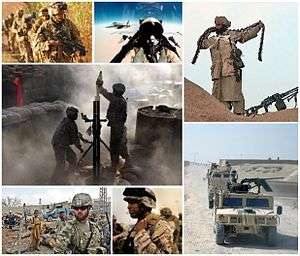

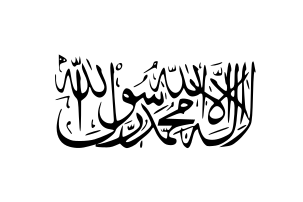
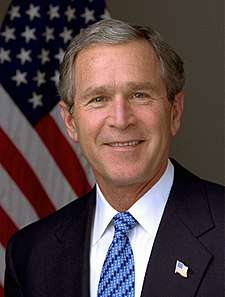
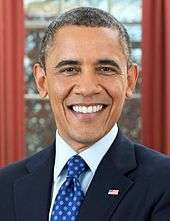
.jpg)
